- 0}"> Favourites 0">({{ favouritesCount() }})
- Trip Calendar
- +44 (0)20 8410 3449
- [email protected]

Inspirational Off-Piste courses
- Off-Piste Coaching
- Off-Piste Adventure

Guided touring adventures
- Hut to Hut Ski Tours
- Ski Safaris
- Day Ski Touring
- Ski Touring Skills

Learn awareness and safety skills.

Classic alpine summer adventures

Exhilarating, safe mountain adventure

Vertical Ice-fall adventure

Stunning high altitude trekking

Incredible trekking journeys
- Private Groups

- How hard is the Ski Haute Route? (Updated for 2021)
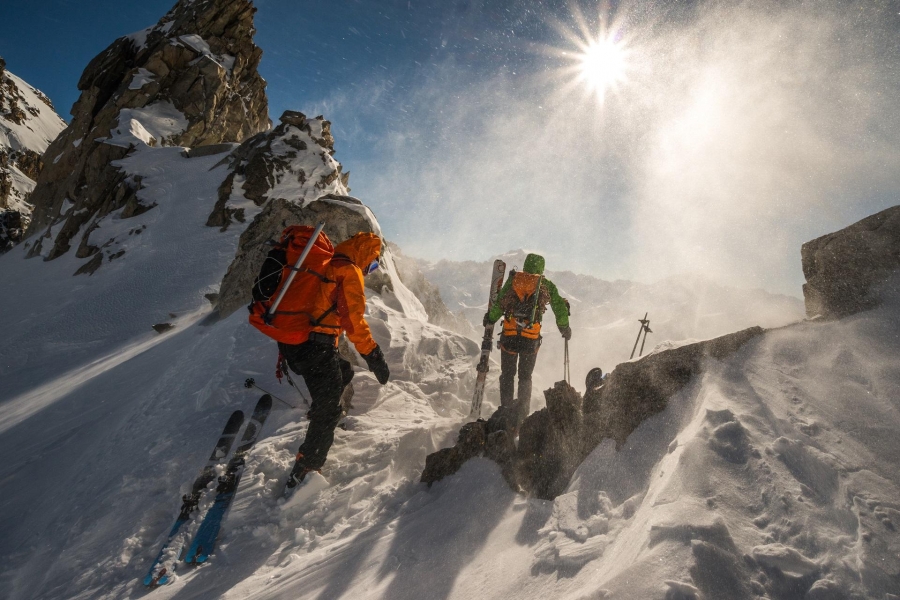
The Haute Route (high road) is the quintessential ‘must do’ ski tour and appears frequently on bucket lists. For every ski tourer it is a milestone and a rite of passage, but how hard is the Haute Route, and am I ready to attempt it? At Mountain Tracks, these are questions we receive a lot. Hopefully, you will find some answers here:
The Haute Route links two historic Alpine centres; Chamonix in France and Zermatt in Switzerland. Following an elegant and sometimes ingenious course, the route threads its way through the Mont Blanc Massif and the Swiss Valais. These two incredible ranges are among the highest areas in the Alps.
The Haute Route in its entirety dates back to 1924 (the history of the individual passes or ‘cols’ is much longer), so the journey is steeped in history and tradition. The total distance is approximately 120kms with 6,000m of ascent and descent. Described here is the Verbier route but there are many variations, some like the 'Grand Lui' or 'Classic' variations involve greater technicality.
How difficult is the Haute Route Ski Tour ?
Regarding the downhill: The terrain is remote and the snow is variable so you must be an experienced and confident off-piste skier who is able to handle the changing snowpack. There are moderately steep slopes (30 degrees) and frequent changes in snow texture on the descents so it is essential that you have experience descending mixed terrain.
It is important to stress that the Haute Route is not solely for the elite and mind-bogglingly fit; it is achievable by ‘good intermediate’ off-piste skiers, with the correct preparation. Ideally your skills will have been developed over a number of years, skiing off-piste with experienced groups. Pushing yourself to finds the best snow on the mountain is the name of the game. If you are not comfortable with this, you may need more experience.
Regarding the uphill: The Haute Route is graded ‘advanced level’; this means you should be familiar and efficient using touring equipment and be able to demonstrate self-sufficiency on the mountain, for example, there are several sections where moderately steep kick turns are necessary. So at minimum, you need prior day-touring experience, but ideally you will have previously completed another hut-to-hut trip.
Sometime it is necessary to use crampons and ice axe, but this is usually on snow (rather than ice) and not at a high standard, so competence with mountaineering equipment is useful but not essential.
How strenuous is the route?
This is an ‘advanced level’ tour so a good level of aerobic fitness is a prerequisite. You should be able to comfortably ski all day and be happy skiing (uphill) at 400m/hr. Typically there are 3-5 hours of uphill per day and between 900m to 1300m of ascent. But don’t forget; it is normal to be tired on occasions and it is normal to try hard. Good pre-trip fitness prep is the key to success here.
Training and preparation
The trip is not just about success, it is also about enjoyment, and the fitter you can get before the trip the more fun you are going to have. In fact feeling fit in the mountains is exhilarating for its own sake and is part of the mountain lifestyle.
Our training should focus on the desired result. So in this case we would like to be able to exercise at a moderate intensity for many hours (typically 5 to 11 hours). We can achieve this by building aerobic workouts over time. The best exercises (excluding skiing!) are body-moving outdoor activities like hill walking (with a rucksack), running and cycling.
It is worth Remembering that if you are not used to exercising a lot, your body will need time to strengthen up to avoid injury.
Day by Day..
The Haute Route begins in the small town of Argentiere, near the head of the Chamonix valley. On the first day it is important that the whole group is physically prepared and has all the correct equipment. The first day begins with a warm-up but this is no substitute for a committed pre-trip training program. The daily itinerary is always subject to alteration depending on weather, mountain conditions and the ability of the group.
Day 1: Grands Montets to the Argentiere hut
In the morning, we start the tour with a warm-up at the Grands Montets ski area. Your guide will run skills sessions on avalanche search and rescue, skinning technique and use of mountaineering equipment.
The Haute Route journey officially begins at the top station of the Grands Montets (3300m) cable car! Firstly we make an exciting initial descent down the impressive Rognon glacier to the larger Argentiere glacier. Here we make our first transition to skins and make our way up the glacier to the Argentiere hut (2770m) with impressive views of the north face of Aiguille Verte, Droits and Courtes. The hut gives us our first night at altitude and helps the acclimatisation process.
Hours: 3 (plus the time spent training)
Altitude range: -800m / +200m
Guides tip: Take a great amount of care when preparing your rucksack; you don’t want to leave things behind, but the pack must stay light!
Day 2: Argentiere hut to Trient Hut
Today we pass from the French Alps to the Swiss Alps via the Col du Chardonnet; the first high altitude pass.
The day begins with a relatively short ski down the glacier from the hut before turning to the right and ascending (on skins) 800m to the Col du Chardonnet (3300m). This is an airy and impressive place giving incredible view both to the French and Swiss sides. The way from here involves a steep (90m) decent by rope to gain the Saleina glacier, followed by a further ascent by skins to the Saleina col. This gives access to yet another huge glacial plateaux leading to the Trient hut (3170m) where we spend the night.
Alternative route: Depending on mountain conditions, we sometimes use a different route to reach the same destination: The col de Passon and the col Superieur du Tour.
Altitude range: -200m / +1100m
Guides tip: Stay confident and focused on the first big hill, it represents a psychological barrier.
Day 3: Trient Hut to Prafleuri hut:
Today we leave the Mont Blanc massif behind and enjoy a long descent down a remote valley which connects us with the Swiss Valais.
Initially we have an easy ski down the Trient glacier before using crampons to cross the col des Ecandies (2800m). The col gives us access to the Val d'Arpette and a superb ski descent taking us to the picturesque lakeside village of Champex.
From Champex a short journey by taxi takes us to Chable, part of the Verbier ski area. We take the skilift up as far as the Gentianes pass (2903m), and tour via a series of small cols to the summit of the Rosablanche (3336m). This summit offers a spectacular vantage point before skiing down to the Prafleuri hut (2624m).
Altitude range: +1000m/ -1100m
Guides Tip: On this day there are lot of ‘change overs’ so practice your efficiency when taking skins on and off.
Day 4: Prafleuri hut to Dix hut
After several days on the Haute Route, we feel well acclimatised and naturally stronger. This day takes us to the Dix hut below the imposing north wall of Mont Blanc de Cheilon
From the Plafleuri we ascend to the relatively easy col des Roux. This is followed by a long traverse above Dix Lake where care is needed places. Once at the head of the lake, a long (and often hot) skin uphill takes us to the Dix Hut.
Altitude range: +900/ -450m
Guides tip: Your clothing should be versatile, so you are neither hot nor cold at any single moment. Think carefully about how you can achieve this on the move.
Day 5: Dix hut to Vignettes hut
The voyage to the Vignettes refuge over the Pigne d’Arolla is amongst the most spectacular on the Haute route.
After a short descent onto the Dix glacier, we embark on a long ascent (1000m), passing through impressive glacial terrain to the summit of the Pigne D’Arolla, this is the highest point on the Haute Route and offers a wonderful viewpoint across the Western Alps. While ascending the ‘Pigne’ there is a delicate section called ‘pass of the Serpentine’, which often has to be climbed on foot.
From the summit, we descend for 600m to reach the Vignettes Hut, which lies on top of a huge cliff overlooking a steep glacier.
Hours: 6 to 7
Altitude range: +1000 m/ -600m
Guides tip: To get up to the Pigne d’Arolla is nearly 1000m of ascent at altitude, so ‘pace’ is critical. The guide will pace the group, but you will also need to pace yourself. Move efficiently without burning unnecessary fuel.
Day 6: Vignettes to Zermatt
The final day of the Haute Route is a magnificent journey in its own right, it is also the most strenuous day; good weather is required.
After a 5am breakfast we begin the climb up the Col de L’Eveque. After reaching the col, a good descent follows and then we embark on a second climb (first by skin, then by foot) to Col du Mont Brule. From here, the final col: the Valpelline is two hours away. At the top our efforts are rewarded by fantastic views of the Matterhorn.
Now we have the final and very long descent to Zermatt beginning on the famous Stockji and Zmutt glaciers and then leading down through traditional hamlets to Zermatt itself. The descent takes us right below the Matterhorn pyramid and is a sight to behold.
Hours: 8-12
Altitude range: +1600 / -2600m
Guides tip: Take the last day seriously. Be up early and be well organised with your kit. You will need all the skills and a good performance for the last day of the Haute Route. This day is strenuous for everyone; so harness the team spirit and focus on your goal, it’s worth it.
By Matt Dickinson IFMGA guide
Day 5: The long ascent to the summit of the Pigne d'Arolla
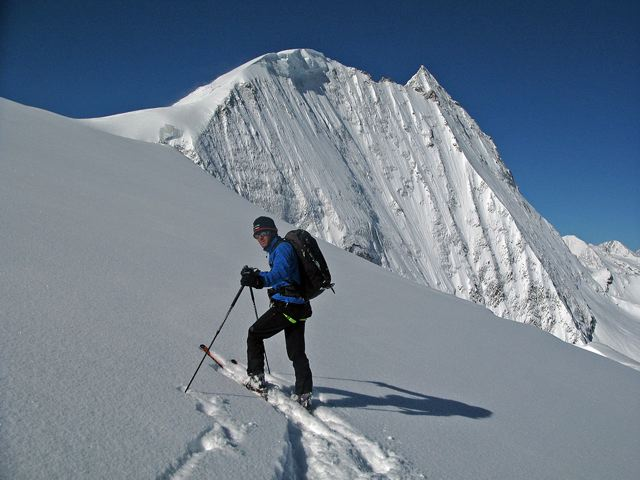
Day 3: Good weather is not guaranteed
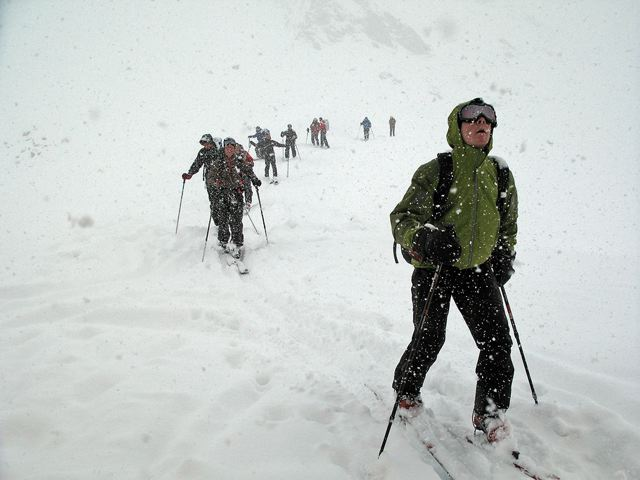
Day 5: Descending the Pigne d'Arolla with the Otemma glacier below
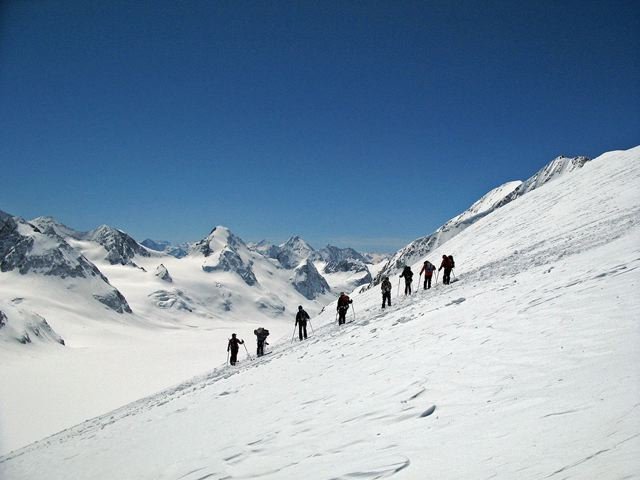
Day 6: The long early morning skin to the Col de l'Évêque
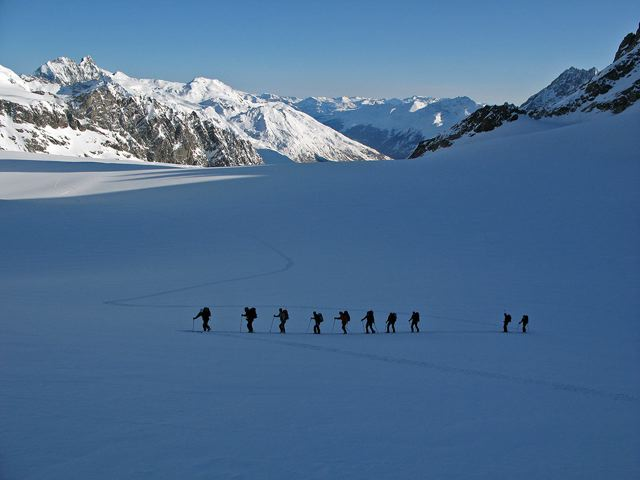
Day 6: On top of the Col de la Vallpoline with the Matterhorn in the background
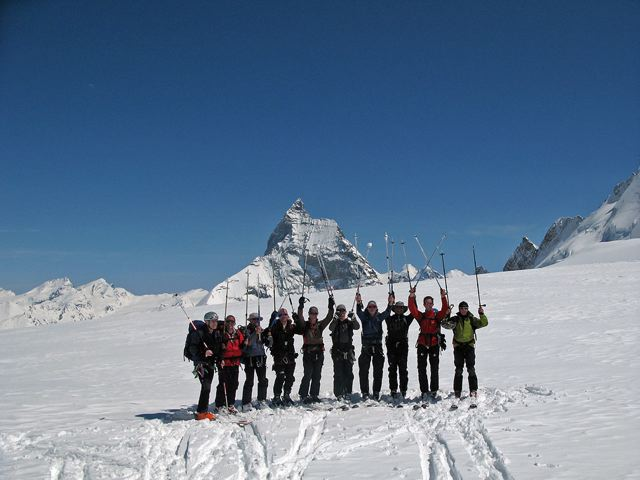
Day 6: Beginning the long descent of the Stockji Glacier in the direction of Zermatt
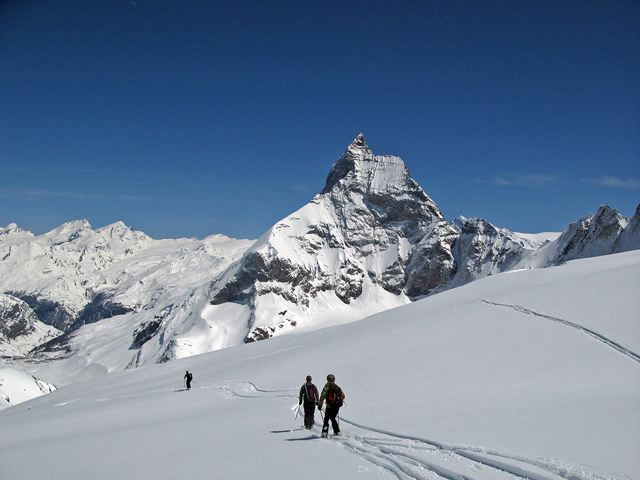

Search Blogs and Other Pages
Top blog articles.
- How Difficult is the Matterhorn
- Chooing an avalanche air bag - buyers guide
- Trekking Poles and Walking Poles Reviewed
- Should I buy tech pin binding or not?
- Get fit for skiing, at home!
Sign up for special offers, news and promotions! More information

IFMGA / UIAGM / IVBV
The IFMGA / UIAGM / IVBV symbol is the logo of the International Federation of Mountain Guides Association.
Nick, Olly and Matt are all fully-qualified UIAGM Mountain Guides and members of the British Mountain Guides Association.
The International Ski Instructors Association is the world body for professional ski instructors.
The ISIA was formed in 1971 and there are currently 39 member nations representing the very best in ski instruction around the world.
You do not have any favourites. Click the star icon on the search or holiday pages to favourite a holiday.
{{ holiday._source.name }}
Your browser is out-of-date.
Update your browser to view this website correctly. Update my browser now

- Mont Blanc 5 Day Course
- Mont Blanc 3 Day Course
- Ski Mont Blanc
- Climbing Routes
- Matterhorn 4 days
- Eiger, Monch and Jungfrau
- Grand Paradiso 4061m
- Mont Blanc Introduction Course
- Monte Rosa 4563m
- Vallée Blanche
- Chamonix 4 days Off Piste
- Classic Haute Route 7 days
- Bourg St Pierre route 6 days
- Tour du Mont Rose
- Haute Route Chamonix-Zermatt
- Ski and sail Svalbard
- Lyngen Alps to Finnmark
- Ski & Sail Antarctic Peninsula
Haute Route ski touring: Chamonix to Zermatt
Since 1924, the winter version of the haute route, from chamonix to zermatt, is one of the most famous ski touring traverses in the world and a classic mountain journey. the route offers everything you would expect on a high mountains tour: amazing scenery, glacier terrain every day, tough climbs and great downhill descents., price: starting from 2350 €.

There are now multiple variations of this route, Chamonix Mont Blanc Guides offers you the classic 7 days route: starting from Argentière (upper side of the Chamonix valley), through some of the Alps' most spectacular scenery, arriving in Zermatt at the foot of the famous Matterhorn.
The Haute Route is an Advanced Level trip for experienced ski tourers. The tour involves several big climbs and long technical descents, with a number of sections where the use of the rope for security is necessary. Like most high altitude ski tours, reasonable weather and snow conditions are required in order to complete the whole tour.
Your high mountain guide:
- Alpinism state qualified
- English and French speaking
Please use the tabs above to read about the day by day itinerary, and other useful information.
.jpg)
Haute Route Day by Day Itinerary
Itinerary subject to change depending on weather / mountain conditions & participants fitness.
Evening before, telephone appointment with your guide for a Program briefing, plus gear check, and confirm meeting time on the morning of Day 1.
Your guide will bring the gear you have requested from us on day 1.
Night in the hotel (2 or 3 *** depending availability) in shared twin room on Bed & Breakfast base. Dinner is at your charge.
Day 1: Argentière hut or Albert 1er hut
Depending on the availabilties in the huts and opening of the cable cars, we either aim for Argentière or Albert 1er hut.
We head to the col du Passon through easy south and sunny slopes, a beautiful climb facing the impressive north face of the Argentière basin.
Once at the bottom of the couloir, we put our skis on our back-pack, put crampons on and ascend the 80m of couloir, to arrive at the col du Passon (3030m.)
Here we can admire the Tour Glacier and the north face of the impressive Chardonnet mountain.
We ski down to Albert 1er hut by crossing the glacier Plateau.
This first day is not that long and will be a good occasion to practice our ski touring skills and avalanche safety.
Hours: 5 to 6 h
Altitude range: -900m / +540m
.jpg)
Day 2: Albert 1er to Champex
We climb the Col supérieur du Tour pass (3388m) then have an easy ski down the Trient glacier into Switzerland to reach the col des Ecandies (2796m).
Here we have some short steep sections and we will most likely use ropes and crampons. A superb ski descent takes us to the picturesque lakeside village of Champex, where we spend the night in a gite.
Hours: 5 to 6h
Altitude range: +1041m/ -1100m

Day 3: Champex to Prafleuri hut
We take a bus or taxi to Chable, part of the vast Verbier ski area. We can ski a few runs here before taking the skilift up as far as the Gentianes pass (2903m), and ski tour up to the summit of the Rosablanche (3336m). Here a panoramic view of peaks surrounds us, before we ski down to the Prafleuri hut (2624m).
Hours: 4 to 5h
Altitude range: +400m/ -2372m
.jpg)
Day 4: Prafleuri hut to Dix hut
A 6 am departure to cross the short col des Roux followed by a long traverse above Dix Lake which we follow to the Pas du Chat.
We climb up to the Dix hut (2928m) opposite the imposing north face of the Mont Blanc de Cheilon.
Hours: 6 to 7h
Altitude range: +730m/ -430m
.jpg)
Day 5: Dix hut to Vignettes hut
A climb to Serpentine pass (3423m) - most likely using crampons - leads to the Brenay pass (3639m) and finishes with the spectacular Pigne d'Arolla (3796m).
Here we can admire the view stretching from the Mont Blanc to the Matterhorn before skiing between seracs down to Vignettes.
Altitude range: +868 m/ -602m
.jpg)
Day 6 : Vignettes hut to Bertol hut
We descend to the Mont Collon glacier then climb to the Evêque pass (3392m) dominated by the peaks of the Evêque and the Cardinal.
Traverse of the col Collon and a superb descent on the Arolla glacier to Plan de Bertol (2615m). An 800 m ski tour up brings us to the Bertol hut (3311m) perched on a rocky spur facing the Dent Blanche and the Matterhorn.
Altitude range: + 1100m / - 852m
.jpg)
Day 7: Bertol hut to Zermatt
We cross the Mont Miné glacier to ski up to the Tête Blanche (3724m) to take in the awe of the Matterhorn pyramid. Then we have the final descent to Zermatt on the famous Stockji and Zmutt glaciers.
You can then choose to stay and rest in Zermatt, or join the other group members who plan to head back to Chamonix.
Due to variations in clients arrangements from Zermatt, the cost of transport from Zermatt or additional accommodation will be at the charge of each individual.
We will of course reserve a hotel or taxi for you if you let us or your guide know.
Altitude range: +400m / -2000m
.jpg)
Haute Route Chamonix to Zermatt Technical Information
Technical level required for the haute route ski tour.
Snow slopes of up to 40 degrees in varying snow conditions (deep powder, wind crusted, hard packed, etc).
You need to have previous ski touring experience, master downhill and uphill kick turns, and be able to ski in all snow conditions (style is less important!).
Ropes and crampons will sometimes be necessary, and you may have to carry your skis on your back to traverse / climb certain sections.
Fitness level for the Haute Route Ski Tour
Daily altitude ranges from 800 to 1200m with up to 8 hours walking. You should practise an endurance sport regularly.
We climb about 350m per hour, which is not difficult in itself, however it can be strenuous with backpacks and changing weather and snow conditions.
Changes to the program
The high mountain guide reserves the right to modify or interrupt the program at any time for safety reasons, technical or physical problems with one or several participants or due to bad weather and snow conditions.
Meeting point
The day before the course, at the end of afternoon, Telephone appointment with your guide to review the program, equipment and confirm the appointment of day 1.
By train (SNCF): Chamonix train station via Saint-Gervais-Les-Bains - Le Fayet.
By plane: Geneva airport by coach or shuttle.
There are regular airport shuttles between Geneva Airport and Chamonix. Special discount rate on Mountaindropoffs, please ask us for the code.
Accommodation
3* hotel the night before, thereafter in catered alpine huts. Pillows and blankets are provided, but please bring a sleeping bag liner.
Half board in the huts (dinner and breakfast). You can buy lunche in the huts for the following days.
You should also bring your own additional snacks, e.g. energy bars, dried fruit and nuts (nothing heavy or squashable).
The gear list will be provided upon booking.
Haute Route Chamonix to Zermatt in 7 Days Pricing and Availability
The cost is based on a group of 4 up to 6 people. If you are a private group, please contact us to discuss dates and prices.
IMPORTANT NOTE : we get back to you as quickly as possible to confirm your booking, as all depends on the places available in the huts.
GET IN TOUCH directly by e-mail or phone/whats app +33 6 95 04 23 02 as we have other different dates / program and routes available too.
The price includes:
- Organisation of the trip
- High mountain guide (state qualified)
- 1 night B&B in 3* hotel in Chamonix the night before (day 0)
- 6 nights in mountain huts with dinner and breakfast
- Taxi on day 3
The price does not include:
- Transport to Chamonix
- Transport from Chamonix to Les Grands Montets on Day 1: regular bus or train
- Transport from Zermatt back to Chamonix at the end (taxi is approx 90€ per person, depending the number of people and taking into account the guide)
- Lunches (buy them in the huts = count 20-25€ per day)
- Additional snacks and drinks in the huts
- Personal ski and safety equipment (touring skis, boots, harness, transceiver, shovel,probe)
- Any unplanned additional expenses due to weather forecast, snow conditions, lack of fitness, etc
- Alpine insurance (rescue, medical fees & repatriation)
IMPORTANT: if you plan to stay in Zermatt after the course, please note that you will still have to contribute to the guide's taxi fee to return to Chamonix. Price to be confirmed upon number of participants.
Live & Book
Weather forecast
day after tomorrow
Lift tickets
Live panorama map, timetables & prices, mountain excursions, accommodation.
- Booking in only 3 minutes
- Maximum protection & excellent assistance
- Real guest reviews
- 97% customer satisfaction
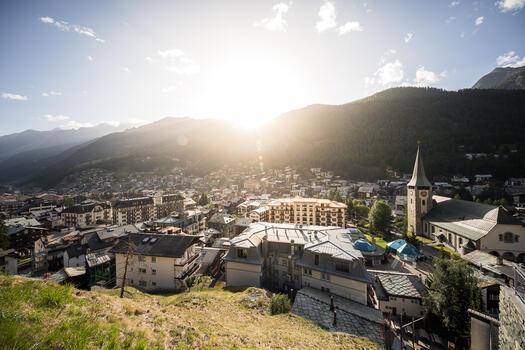
Holiday flats
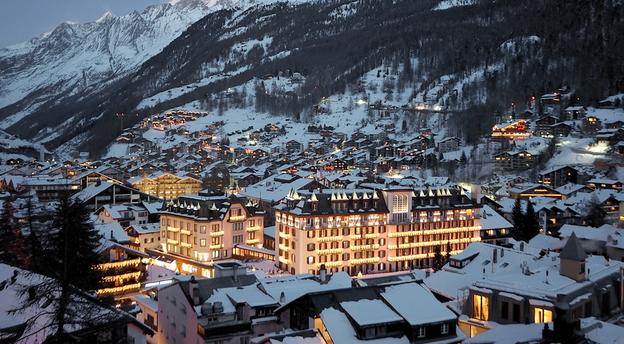
Tickets & Shop
Ski tickets, train tickets, accomodation, monday, 29. april 2024.
- Planning hikes & tours
Haute Route Chamonix-Zermatt
- print version
- Share the current page on Twitter
- Share the current page on Facebook
- Share the current page on Google+
An absolute ski tour classic. Over 5-6 days, from one mountaineering centre to another.

- Type Skitouring
- Difficulty medium
- Duration 50,00 h
- Distance 94,3 km
- Ascent 6700 m
- Descent 8345 m
- Lowest point 718 m
- Highest point 3776 m
Description
Chamonix and Zermatt: Two names that make any mountaineer’s heart beat faster. A multi-day ski tour links them both. Every day starts early, often when it’s still dark. There are tough ascents and fantastic descents, requiring both physical and mental stamina. Surrounded by the highest mountains in the Alps, you travel from hut to hut on an incredible route.
- The classic among ski tours
- From hut to hut
- Surrounded by the highest mountains in the Alps
1. Stage Aiguille des Grands Montets – Glacier d’Argentière – Glacier du Chardonnet – Col du Chardonnet – Fenêtre du Saleinaz – Plateau du Trient – Cabane du Trient
2. Stage Cabane du Trient – Col des Ecandies – Val d’Arpette – Champex – Verbier (Taxi) – Cabane du Mont Fort (Bergbahn)
3. Stage Cabane du Mont Fort – Col de la Chaux – Col de Moming – Rosablanche – Cabane de Prafleuri
4. Stage Cabane de Prafleuri – Col de Roux – La Barma – Lac des Dix – Cabane des Dix
5. Stage Cabane des Dix – Col de la Serpentine – Pigne d’Arolla – Cabane des Vignettes
6. Stage Cabane des Vignettes – Col de l’Evèque – Col du Mont Brulé – Col de Valpelline - Zermatt The details on the tour (distance, duration, altitude and depth) also include the Orsière-Verbier-Mont Fort stretch that is covered by taxi and cable car.
We recommend to book a mountain guide who knows well the place.
We recommend:
- Ski touring equipment: touring ski-boots, touring skis with touring bindings, ski poles, skins, crampons
- Climbing harness
- Backpack, shovel, probe
- Avalanche transeiver
- Warm weatherproof clothing
- Warm gloves and warm hat
- Sunglasses and sunscreen
- Warm drinks
- Snack (high energy foods such as chocolate, dried fruit etc.)
- Food (energiereiche Nahrung wie Schokolade, Trockenfrüchte)
- Bring everything needed for a multi-day ski tour from hut to hut
The Haute Route is a long tour during which you spend several days high up in the mountains a long way from civilization. Calm weather conditions, experience in the high mountains and careful preparation are essential.
- Always go with a mountain guide on a tour
- Stay up-to-date with the weather and avalanche status: Snow Report More information is available in the Swiss avalanche bulletins ( www.slf.ch )
- Always maintain visual contact with accompanying persons
- Use key sections and extremely steep slopes individually
- Never go into a wild game protection zone (these are marked and one will be fined)
- Always switch the avalanche transceiver (LVS device) unit to transmission
- Always carry a shovel and a probe
- Pay close attention to daily atmospheric warming and continually re-evaluate the situation
Tip: “Be searchable”. Equip yourself with an additional RECCO rescue reflector*. Whether summer or winter. Available in our Online-Shop or our information desk. *The additional reflector does not replace an avalanche beacon.
Map and arrival
Patrouille des glaciers.
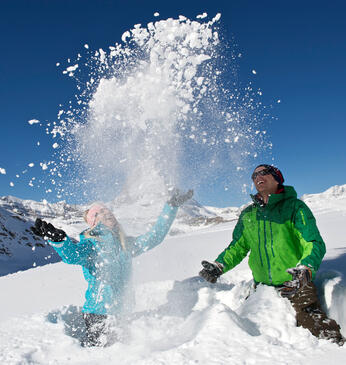
Snow report
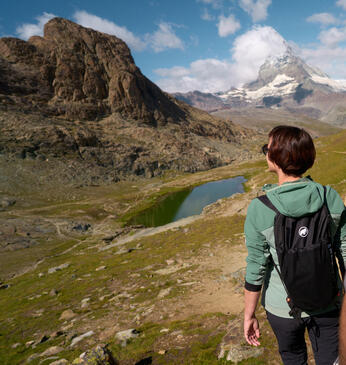
Experiences & activites
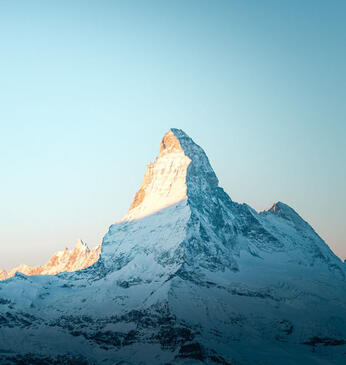
Gift Vouchers
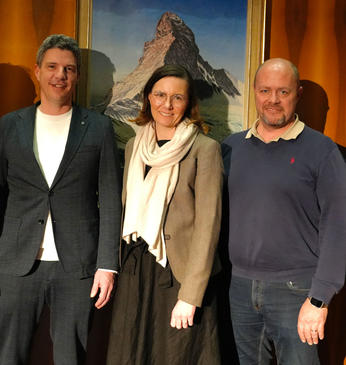
AGM Zermatt Tourism: A magical financial year
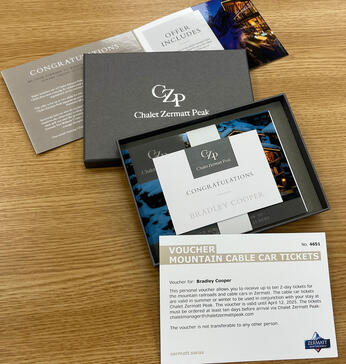
Zermatt Tourism takes part in the biggest night in Hollywood
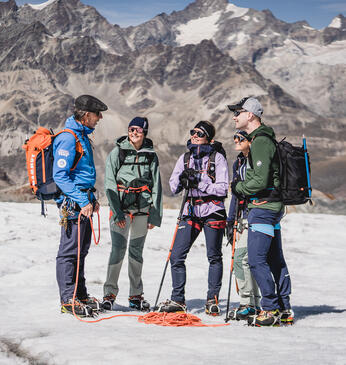
Grow beyond yourself with the Mammut Mountain School
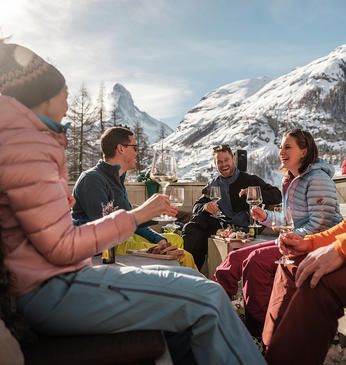
Tips of the day
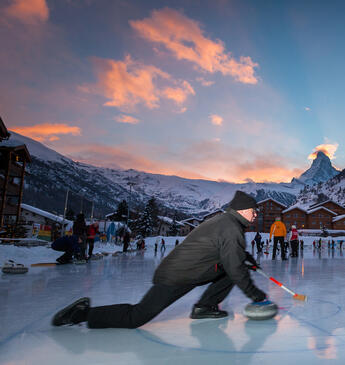
Room / Appartment 1
Room / Appartment 2
Room / Appartment 3
Room / Appartment 4

Skiing The Haute Route: Everything you Need to Know
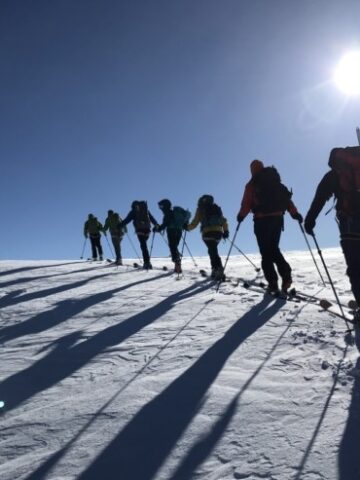
A Classic Ski Tour: The Haute Route
In the world of ultimate ski trips, there is one that is often at the top of every adventure skier’s bucket list – The Haute Route. Meaning “High Road” in English, The Haute Route traverses the French and Swiss Alps from Chamonix, France to Zermatt, Switzerland. As we head into Spring ski season, I can’t help but reflect on our Haute Route trip in 2017 with a group of very experienced ski friends and two professional guides (highly recommended for this trip). During the seven-day trip, our group set out to conquer the Haute Route while crossing glaciers and high mountain passes using mountaineering equipment and touring skis .
For a preview of the trip, check out the trailer video below. The full video of the trip is long but well worth the time as it’s a documentary of our entire trip.
Chamonix to Zermatt
Haute route day 1 – skiing argentière to refuge albert premier.
Our Haute Route trip begins with us all meeting in Martigny. From here we take the train to Argentière, then take the lifts up and Ski/Hike to Refuge Albert Premier. Originally we were to go to the Refuge Argentière, but it was completely booked. I think most people were there since Albert Premier was not so crowded.
Climbing stats – 6 miles (9.6 km), 5 hrs 49 minutes, 2810 ft (856 M) ascent, 2396 ft (730 M) descent
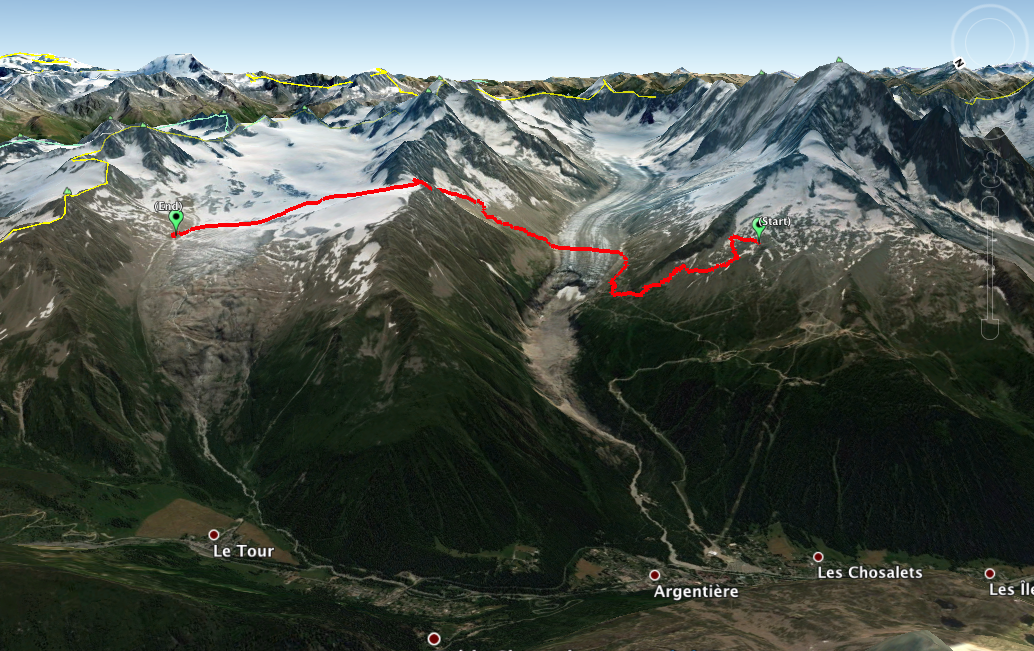
Our guides inspected our gear at 7am, and off we went on the 7:45 am train to Argentierre. Our Haute Route trip has begun!
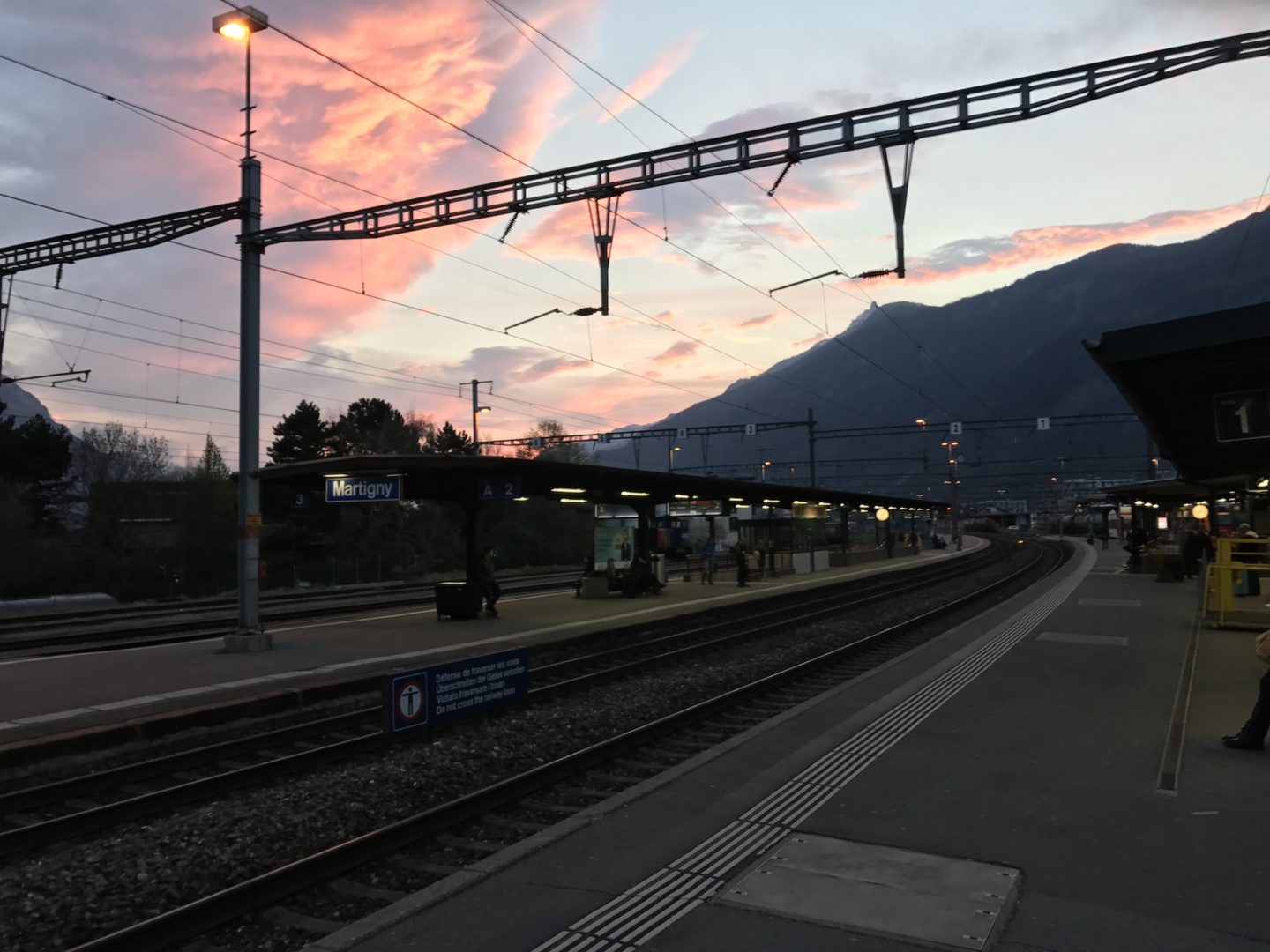
The train ride up the Gorge du Trient was very cool, and time went by very quickly. From there, the walk from the train station to the telecabin station for the Grand Montets was our warm-up for this – our first day of the Haute Route.
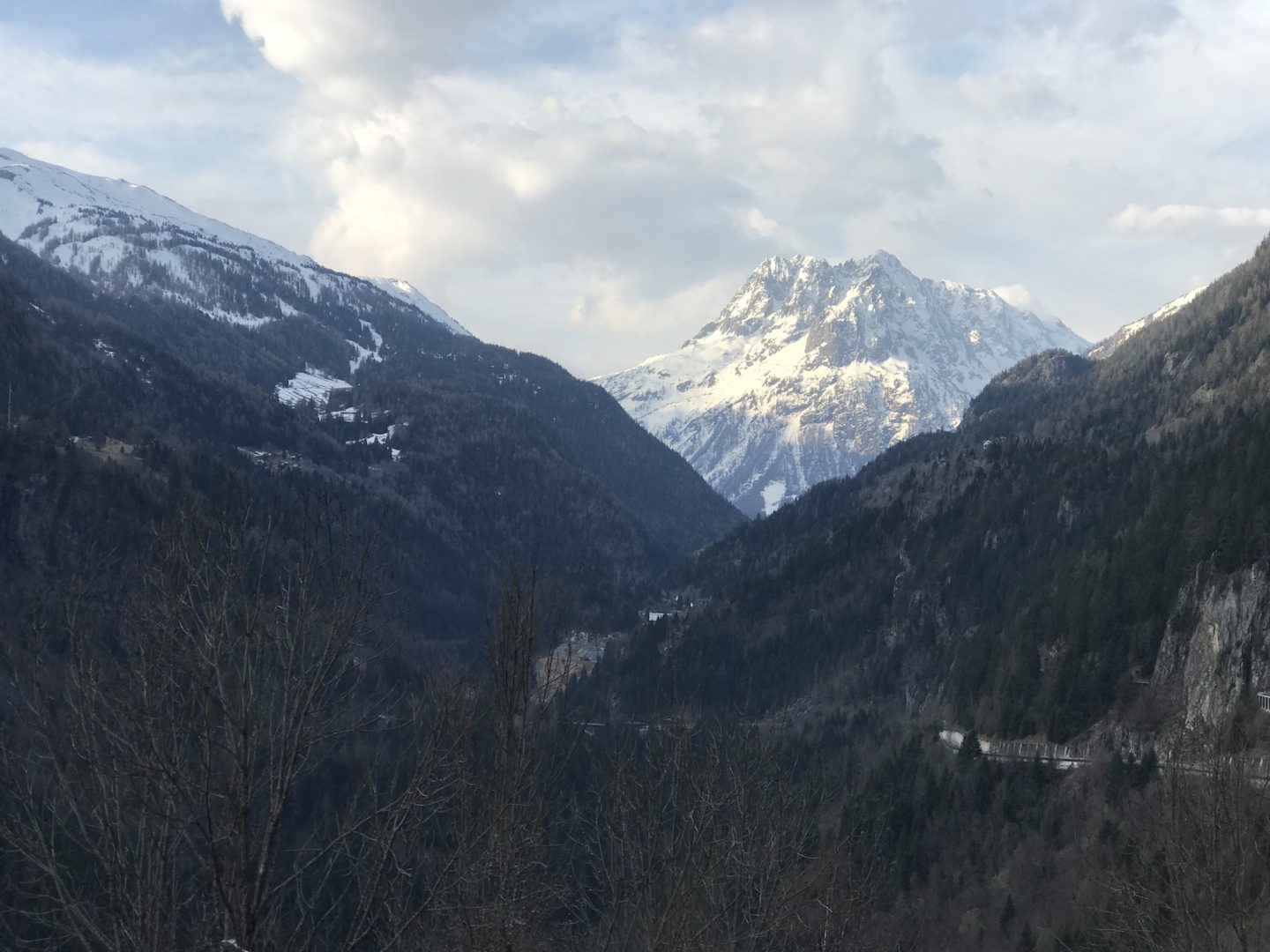
Originally we had planned to take the Lognan Telecabin, followed by the Grand Montets with a nice ski down across the Argentièrre Glacier to our first big climb of the Col de Passon. Unfortunately, the wind gods were not with us. It was snowing and blowing like crazy. The Grands Montets telecabin was closed (and it has since actually burned down). Instead, we had to take the HERSE chair lift which added to our hike for this first day, so instead of skiing down to our first big climb – we climbed to it!
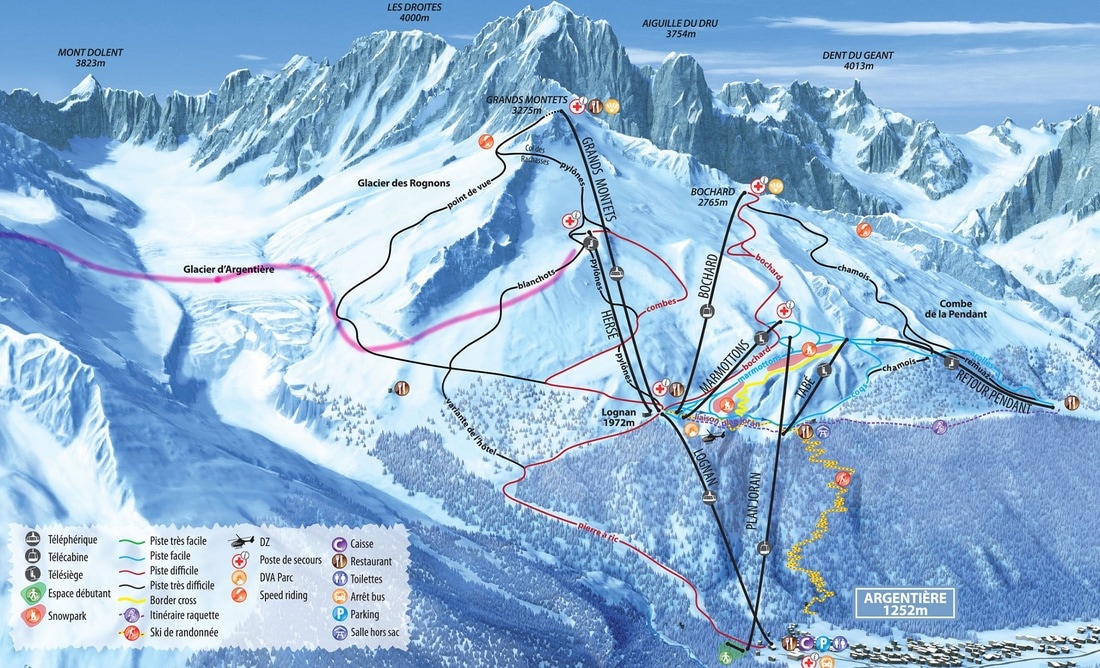
Upon arriving at the top of the HERSE chairlift, we’re ready to take a small downhill run on some icy pistes and begin our first ascent of the well known Col du Passon. Our goal for the day is to make our way to the Refuge Albert Premier. The original plan was to stay at Refuge Argentière, but it was booked a month ahead of time, so our plan shifted to the Refuge Albert Premier.
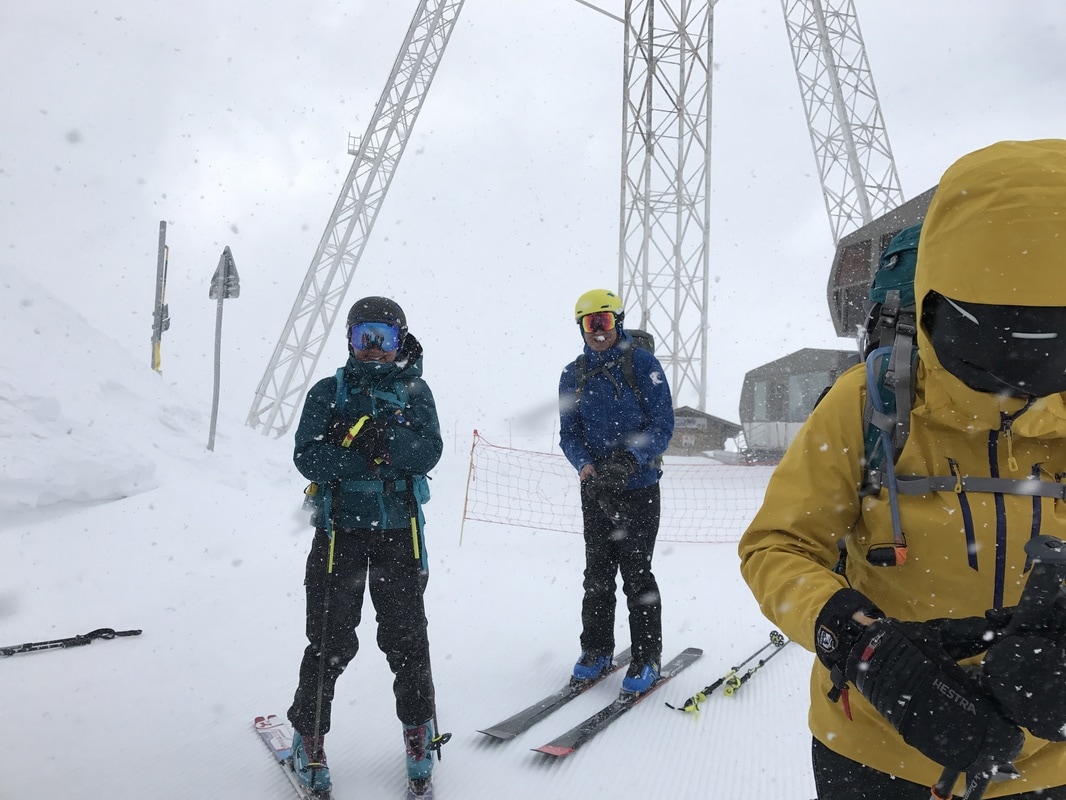
Inside Albert Premier, it is comfortable and not very crowded, as most start with Refuge Argentiere instead. Dinner is good, and thanks to Eric for carrying up the delicious dessert wine – a 2011 Grains de Malice seen on the table.
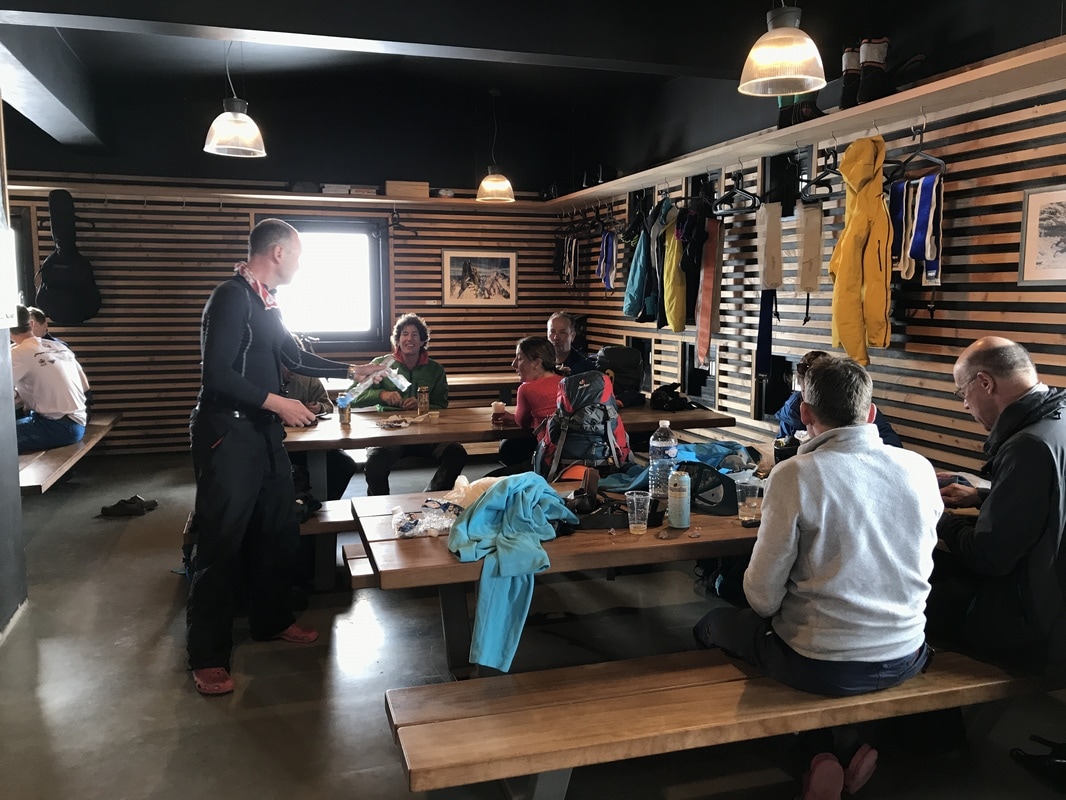
Haute Route Day 2 – Refuge Albert Premier to Cabane du Trient
First Breakfast in a hut – and early start off to Trient.
Climbing stats – 4.75 miles (7.6 km), 5 hrs 38 min, 2437 ft (715 M) ascent, 907 ft (277 M) descent
On our second day of the Haute Route we covered the ski trek from Refuge Albert Premier to the Cabane du Trient. This took us through the Col du Midi, with some scary high winds. Most would do the Col Superieure du Tour, but the guides thought this track would be better with the high winds.
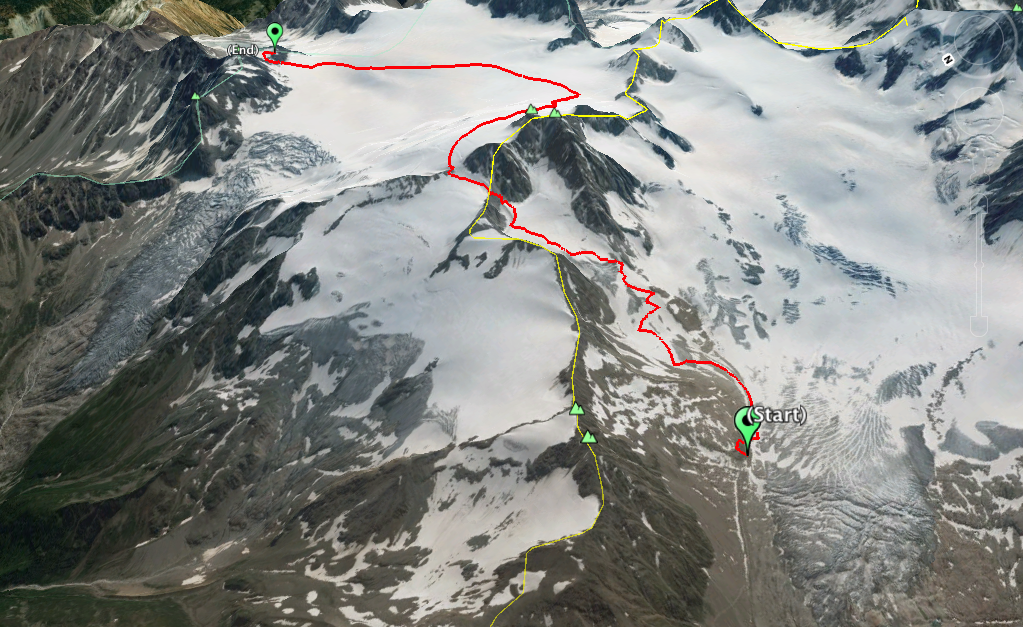
It was around this point that the guides noticed that Phil’s nose wasn’t his normal nose and that he was developing some signs of frostbite. Phil was “mister covered face” for the rest of the day!
er covered face” for the rest of the day!
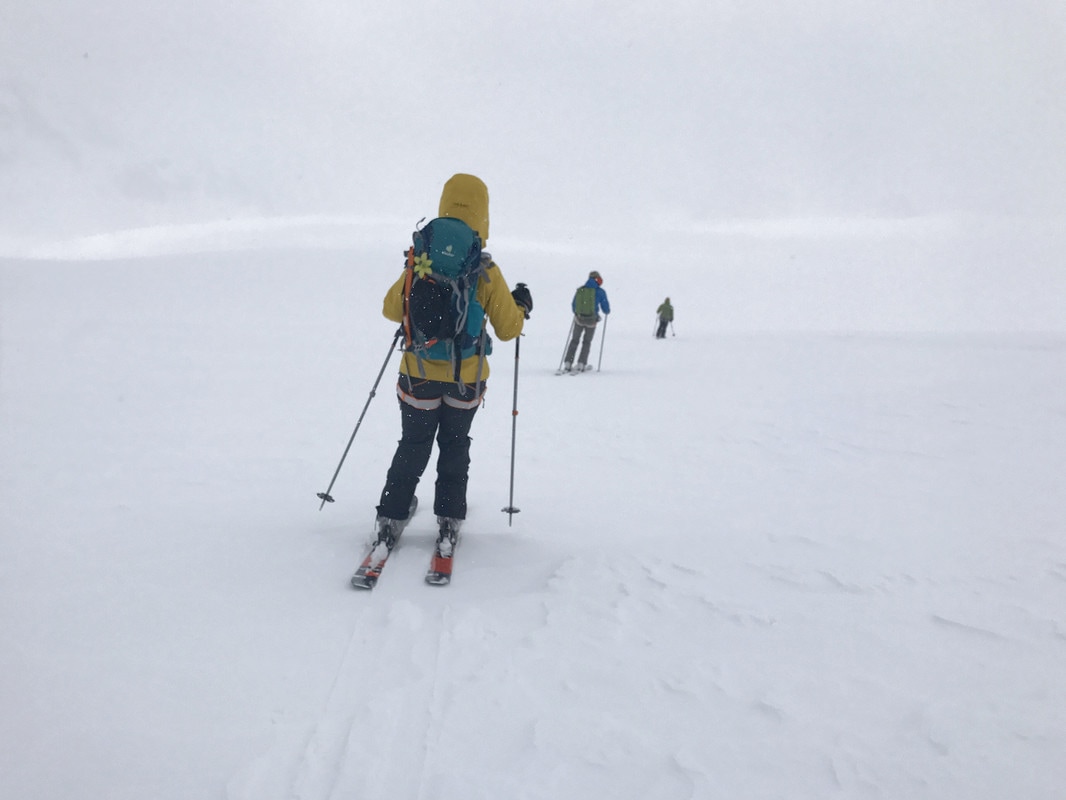
Inside the Cabane du Trient where we enjoy dinner and take in the awesome views of the beautiful sunset before turning in for the night. A great way to end day two of the Haute Route!
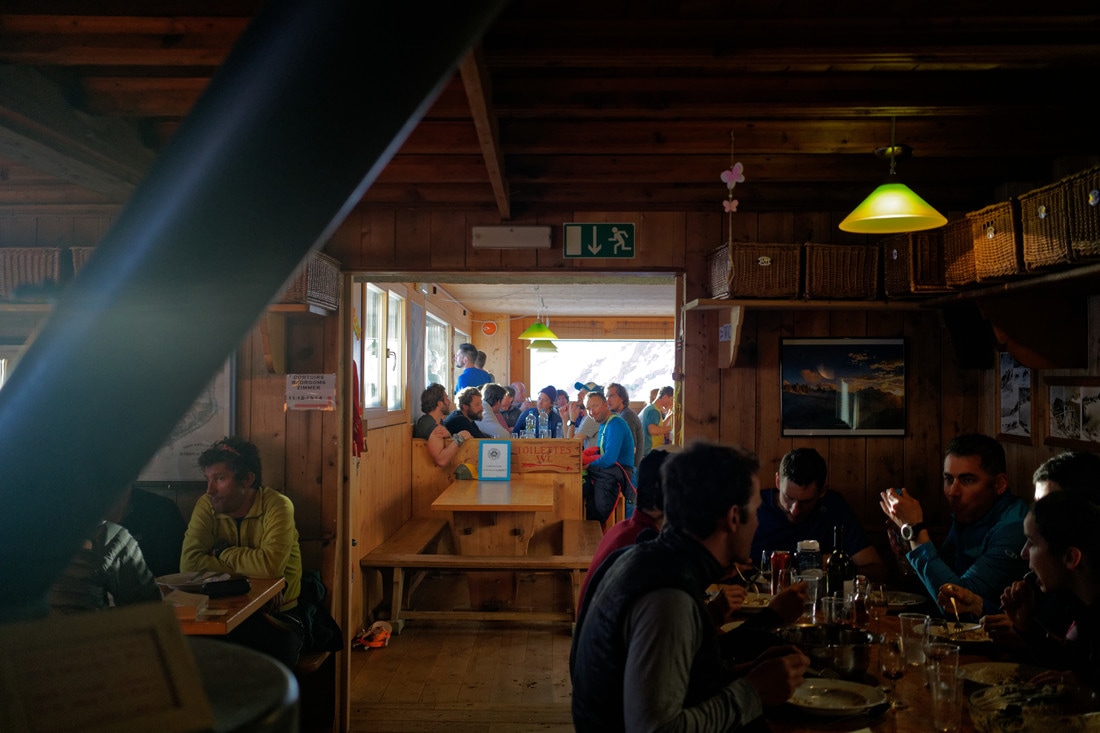
Haute Route Day 3 – Cabane du Trient to Cabane des Dix – multiple stages
Well, this is a crazy day. Originally we were supposed to go from Cabane du Trient to Cabane du Mont Fort. However, the guides realized the trip the day after – from Cabane du Mont Fort to Cabane des Dix – would be too much for our group. Two itineraries were proposed:
Option 1) Ski down to Champex, and take bus to Arolla, stay in hotel, and ascend to Cabane des Dix the next day.
Option 2) Skin up about a mile on day 3 to a helicopter approved landing area, then Heli over to Rosablanche and continue on to Cabane des Dix by ski that day.
Option 2 was only about 120 Fr more per person than Option 1, so all of us went with the Heli option.
Climbing stats – part 1 to the Heli landing spot – 1.3 miles (2 km), 1 hrs 15 minutes, 706 ft (215 M) ascent, 361 ft (110 M) descent
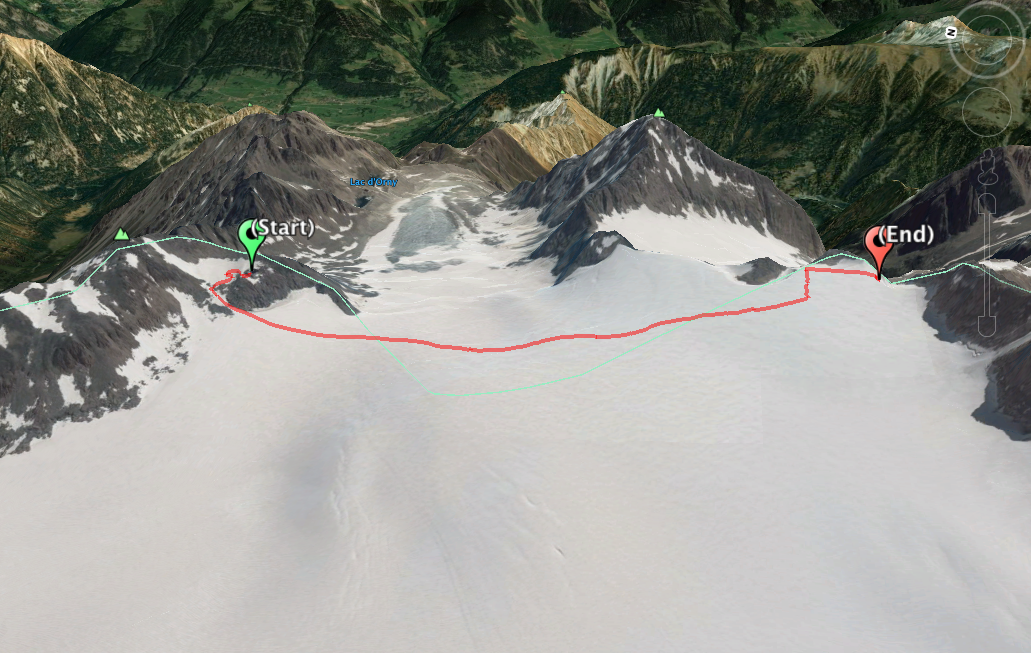
Now it’s time to Climb the Rosablanche to the top, climb down, and trek over to the Cabane des Dix. The below image illustrates the next phase.
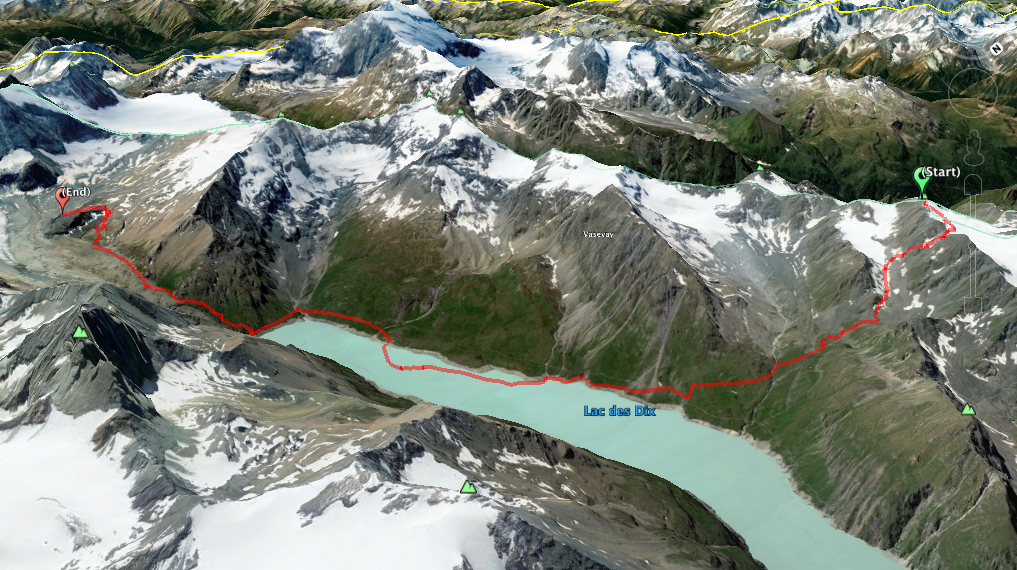
Climbing stats – part 3 to the Rosa Blanche to Cabane des Dix – 7.8 miles (12.6 km), 7 hours, elev gain 2631 ft (802 M), elev loss 3937 ft (1200 M)
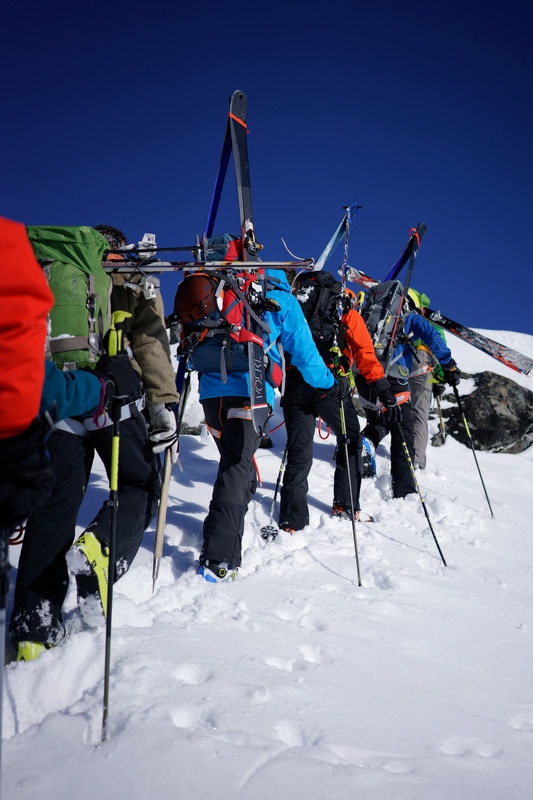
After skiing the great snow off of the Rosablanche, our descent down to the Lac des Dix began with a run down the Couloir de la Rosablanche. This couloir is well known to the ski racers of the Patrouille des Glaciers – the race between Zermatt and Verbier. For an image of what this Couloir looks like filled with racers going up, click here!
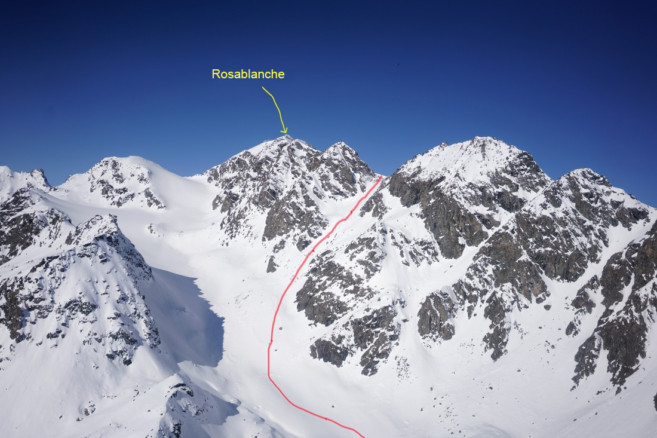
Haute Route Day 4 – Rest Day at the Cabane des Dix
After a long Day 3, we decided to make Day 4 a rest day. Great day to explore the hut a little more! Martin, our guide, explained that too often groups get into their huts at night, eat, go to bed, and never really get to know the character of their hut – this extra day at Cabane des Dix was awesome!!
Some of our group stayed in the hut and relaxed for the day. A few of us skinned up to La Luette to hit a local peak. For those of us that skinned up to La Luette, we were granted with what Martin called “Mouse knee-deep powder” at the beginning, but real powder at the top!
Climbing stats – 3.75 miles (6km) , 3 hrs 55 minutes, 2000 ft (610 M) ascent, 2000 ft (610 M)descent
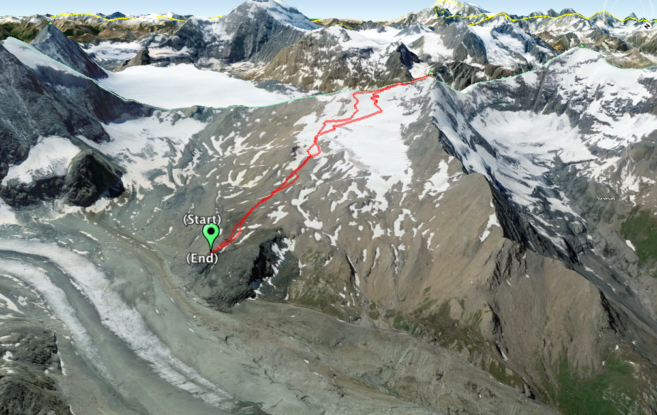
Tip: Skip carrying a picnic lunch and go for the Rösti option in the Cabane, it is the way to go! Plus, none of the other huts could come close to the Cabane des Dix with regards to Beer selection – they must have had 10-15 choices, while others had 2.
Haute Route Day 5 – Skiing Cabane des Dix to Cabane des Vignettes
Day 5 starts early. Up at 4:30 am, we leave at 5:30 for the ascent on the Pigne D’Arolla. We had some illness in the group the day before (altitude sickness and perhaps some Asthma), and were worried about a possible need for evacuation. But, thankfully, we pulled it all together and we were ready to go for this big day! It was “headlamps on” and snowing when we started, and we were definitely the first group up and out the door!
Climbing stats – 6.33 miles (10.2 km) , 11 hrs 56 minutes, 3080 ft (939 M) ascent, 2271 ft (692 M) descent
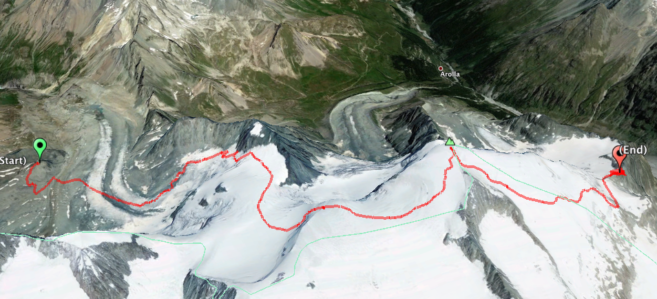
Side Story: What can happen on the Haute Route
There is a little side story that happened just around the time the picture above was taken. Visibility was horrible, you couldn’t see landmarks, etc…. Our guides stopped, checked their topo maps, altimeter and compass. I offered them a peek at my GAIA app that had topo and a GPS location on it, but they said “no, we’re ok.”
Another guide from Chamonix, leading another group who had been here the week before, passed us and veered to the right. I’m sure there might have been some second-guessing from our guides, but they were confident and we continued on.
We were the first group to hit the Serpentine. Who do you think pulled up behind us about 40 minutes after we last saw them? The group from Chamonix! Our guides were very modest about this, saying it could happen to anyone. But we couldn’t help but snicker at how the Tortoise (definitely our group), beat the hare – at least to the Serpentine!
Interested in other Backcountry Ski Tour options? Check out this guide that outlines all the different ways you can experience Backcountry Skiing.
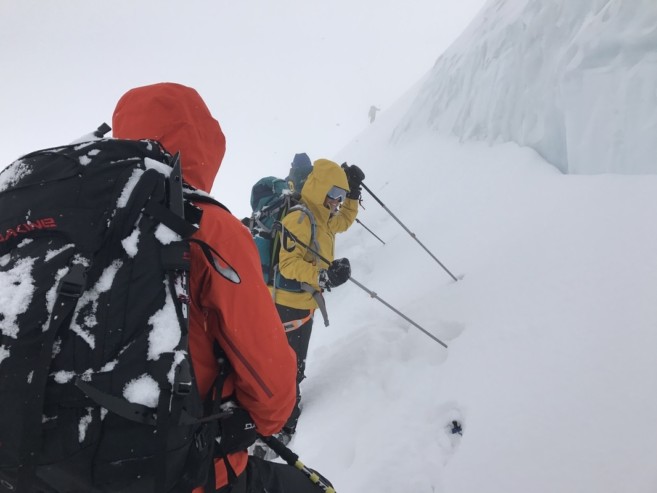
Haute Route Day 6 – Cabane des Vignettes to Schönbielhütte
Day 6 started with a departure at 6:30 am. This was one of the longest days for all of us with 3 Col’s to climb – the Col de L’Eveque, the very steep Col du Mont Brulé, and the mentally draining Col du Valpelline. The ski run down beside the Matterhorn was amazing, but the final ascent up the Moraine ( https://en.wikipedia.org/wiki/Moraine ) to the hut was gruelling. There were times when rocks slid down the hill towards us. The joke of the day was that it was the Chamois pushing the rocks down on us.
The departure from the Cabane des Vignettes was not exactly pleasant as everyone in the hut was leaving at the same time. It was probably 120 people, and the sketchy icy path out of the hut potentially leading to a 500m fall off a cliff! Most people on this trek would go all the way to Zermatt (which I had done back in ’85), but we chose an alternate route including a stopover at an uncrowded Cabane Schöbielhütte. This is a super cool hut right next to the Matterhorn. That way we could then arrive early in Zermatt on our last day with no rushing necessary.
Climbing stats – 13.66 miles (22 km) , 11 hrs 14 minutes, 4196 ft (1279 M) ascent, 5696 ft (1736 M) descent
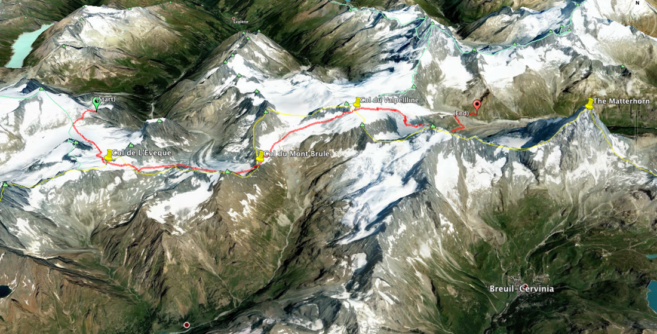
Haute Route Day 7 – Schönbielhütte to Zermatt
Day 7 is our easy day – a cruisy, relaxing run all the way down to Zermatt.
Climbing stats – 7.23 miles (11.6 km), 1 hrs 58 minutes, 6 ft (2 M) ascent, 3477 ft (1060 M) descent
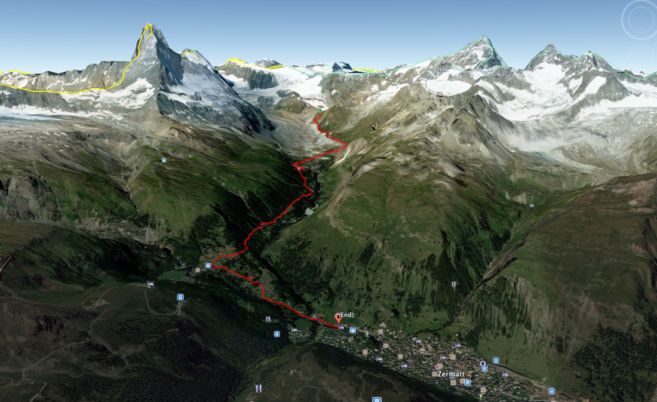
Does the Haute Route sound awesome to you? Looking to get started with Backcountry Skiing? Check out our Backcountry Skiing Know Before You Go blog.
Swiss Mountain Guide
Hiking, Mountain Climbing, Expedition and Skiing Guide
- Trip Builder
Trip Itinerary – The Haute Route
Chamonix – zermatt haute route itinerary., 2021 haute route tour dates:.
- March – May 2021: custom design your ski tour. for individual and group
Day 1: Welcoming in Chamonix. Prepare equipment and review tour.
Day 2: A perfect way to acclimatize for the Haute Route is to ski the Vallee Blanche. Although this run can be accessed by lifts, it is rugged glacial terrain that will allow the skier to prepare for the type of necessary along the Haute Route. Spectacular views of some of the worlds best know mountains are an added treat.
Day 3: Leaving Chamonix to Argentière and ascend the Grand Montet by gondola. From the top, we will ski down and skin up to the Argentière Hut (2,771 m / 9,089′)
Day 4: Departing from the Argentière Hut, we will climb the Chardonnet Pass take in the spectacular views before skiing to the Trient Hut.
Day 5: This day sports a descent starting in the high mountains and finishing on the Rhone valley floor via Champex. Transportation will be provided to Verbier with the day ending at the Mt. Fort Hut.
Day 6: The Rosablanche will be our high point for this day followed by a marvelous alpine descent of this snow and glacier clad mountain, finishing at the Prafleuri hut.
Day 7: Traverse from Prafleuri hut to les Dix hut via the col des Roux, lac des dix and the pas du chat ( the cat step )
Day 8: The climb to the top of the Pigne d’Arolla provides splendid views and leaves us, after a pleasant descent, perched at the Vignette Hut.
Day 9: After ascending the Tête Blanche via Col Brulé and col de L’Eveque we will enjoy the thrill of our final Haute Route descent into Zermatt.
Ski Tour Difficulty:
This is a strenuous tour and requires a high level of fitness. Participants must be strong skiers able to perform strong stem christies while carrying a pack in variable conditions. Powder, hard spring snow, crud and everything in between. Basic mountaineering skills are helpful, we may use a rope, ice axe, and crampons. Your guide will be happy to teach you these skills during the tour.
Custom trip builder .
Home / Skiing / Knowledge Base / Haute Route Advice
Haute Route Advice
Haute route advice for skiers.
Some sound Haute Route advice for anyone thinking of skiing the world’s most famous ski tour: The Haute Route is well known as one of the all time classic mountain journeys in the world, with good reason. It links two of the most important centres for skiing and alpinism in Europe (the world?!): Chamonix and Zermatt. It has incredible scenery and glacial ski terrain. It passes beneath a host of iconic peaks, starting with the impressive north wall of the Argentiere basin and finishing below the Matterhorn. And finally, of course, it’s an essential tick!
This article provides information on the minimum fitness and experience requirements needed to ski the Haute Route, as well as background info on the route and what to expect each day. Hopefully this should help you decide if the trip is suitable for your current ski mountaineering experience and off-piste ski level.
( Please Note: This article describes the ability and experience required to join a Haute Route ski trip lead by a professional mountain guide. To do it safely on your own, you need a broad range of additional skills including avalanche safety training, navigation skills, crevasse rescue and glacier travel skills, logistics knowledge and good quality ski mountaineering decision making experience).
Are You Ready to Ski It?
The Haute Route is a popular target for experienced ski tourers looking for an adventure… However, in recent years the route has become significantly harder due changes in glaciers and snow cover on technical sections of the route, so it’s not to be under-estimated. It’s a tough and committing trip, with some long and tiring days plus some steep, exposed terrain in both ascent and descent – requiring both experience and a careful approach. Above all, it should be noted that the Haute Route is not a suitable trip for those with just a few days experience of ski touring, or skiers who have no mountaineering experience. Please use the following guidelines to help you decide if the time is right.
Technical Ski Ability, Fitness and Ski Mountaineering Experience
The Haute Route is an Advanced Level Alpine hut to hut tour, that includes some ski mountaineering, so you need good levels of ski touring experience for this to be a suitable trip. More specifically, there are 4 requirements for joining a guided Haute Route trip (or any hut to hut ski tour) – here they are, using Alpine Guides’ ski and fitness levels as benchmarks:
1. Technical Ski Ability – your off-piste ski ability should be at Ski Tech Level 3-4 ( more info here ). NB If you are a Telemarker, then it needs to be at Level 4.
2. Physical Fitness – you should be at Ski Fitness Level 3-4 ( more info here ).
3. Alpine Ski Touring Experience – you should have several weeks ski touring experience, using an alpine touring setup/equipment . This needs to be in the Alps, or on equivalent terrain eg. in North America, New Zealand, Scandinavia etc (ie ski touring in the UK is not enough!), preferably including some hut to hut touring, but a strong day touring resume is ok too. NB By a ‘day tour’, we mean a minimum of 2-3 hours uphill skinning in the day! – ie doing a shorter skin off the top of the lift in order to pick up a nice descent is what we’d consider a typical off piste day. If you have skied with us on a Silvretta Tour, a Ski Touring Course, or other similar introductory level trip, we can advise you on the suitability of a Haute Route, or make a recommendation regarding any further training required. If you have already been on one of our intermediate or more advanced level ski mountaineering trips, you should be fine joining a Haute Route. If you haven’t skied with us before, you should have a solid touring resume including at least 3 weeks worth of hut or day touring, or a reference from another guide/guiding company. In particular, before the start of the trip you must have used harscheisen (ski crampons) and must be safe and proficient at doing uphill kick turns whilst skinning on steep, possibly icy terrain.
4. Mountaineering Experience – in recent years the route has become more technical due to glacial recession, with more sections of steep ground needing to be climbed on foot whilst wearing crampons and roped together. A number of key points along the route that were once all on snow, now involve climbing sections of snowed up rock and/or ice in crampons – so before the start of the trip you must have experience using ice axe and crampons on this type of terrain.
Summary of Ski Mountaineering Skills Required
The ski mountaineering skills you should have before booking on the trip include:
Familiarity with alpine touring kit – you should be familiar with and know how to use alpine touring boots/bindings/skins/harscheisen and other touring kit.
Skinning skills – you must have used harscheisen (ski crampons) before, and you need to have efficient skinning technique, being able to skin safely on a variety of terrain, including icy traverses.
Uphill Kick Turns – you must be able to do safe and efficient uphill kick turns: changing direction in a zigzag track on exposed, steep (up to 35deg) and sometimes icy slopes. This is a key skill, and you may sometimes be performing a kick turn in situations where a slip could have very serious consequences.
Skiing with a rucsack – you must be able to ski well whilst wearing a heavy rucsac (~8kg) containing safety and overnight gear.
Mountaineering experience – before booking on the trip, you need experience using an ice axe and crampons on steep snow, snowed up rock and/or ice whilst roped together – ie you need to be confident walking in crampons on snow, ice and rock unroped on easier terrain and climbing in them whilst roped up on steeper terrain.
Steep descents – you need to be happy being lowered down steep snow slopes on a rope (either side slipping on skis, or on foot wearing crampons) to get down short, technical descents.
Avalanche Awareness – you need to have worn an avalanche transceiver before and be aware of basic avalanche safety protocols.
Finally , with all this comes the need for some grit and determination – ie you need to be happy living in alpine huts, making early starts and dealing with any bad weather during the week.
Power to Weight Ratio
Ski touring is a sport for everyone – big, small, young and old! – but clearly, it involves going uphill for several hours a day, so your body weight has a big effect on the amount of effort this requires. You don’t need to be an athlete to ski the Haute Route, but you do need to be fit and active and regular training in the run up to the trip will be required. Crucially, you don’t want to be carrying too much extra weight.
If you are new to ski touring, then we cannot emphasize enough the importance of not being significantly overweight: if you are a stone overweight (7-8kg/15lb) , then you will find the trip a lot harder and you are likely to struggle. If you are more than 12kg/25lb overweight then you may manage some steady day touring, especially if lift assisted, but you stand almost no chance of completing a big multiday ski tour like the Haute Route.
Although it’s possible to ski at a high standard off piste whilst being somewhat overweight – as soon as you point the skis uphill, gravity starts to work against you… Therefore, if you are carrying a few extra pounds, then losing as much of this as possible in the run up to your trip will have the biggest single effect on how much you enjoy the ascents.
Skier Age and the Haute Route
Our minimum age requirement for skiing the Haute Route is 18 years. We have no maximum age limit, but clearly there comes a point where age starts to count against you:
An age where you can get away with a lot physically. You are much less likely to be overweight in this age range and if you have the necessary ski touring and mountaineering experience and train regularly in the run up to the trip, you should be Ok to complete the Haute Route.
The age range that covers most of our clients on the Haute Route. There is a much bigger range of abilities in this group than in the younger one, e.g. someone who is comfortable putting on weight in middle age and doing virtually no exercise, compared to someone with 20 years of triathlons behind them. Stamina is less affected by aging and experience levels go up as you age, so if you are not overweight and take regular endurance exercise, then there is no disadvantage in being in this age group. However, if you are carrying some extra weight or not doing as much endurance exercise as you used to, then you need to start training and losing weight a minimum of 6-12 months before to the trip, in order to be fit enough when you arrive.
We have many clients in this age group who ski with us at a very high level each year, but in general they are all very experienced and unusually fit and active for their age – the older they are, the truer this is. Over 60 you realistically need to have a solid background in endurance sports and be carrying no spare body weight to enjoy skiing the Haute Route.
Weather and Avalanche Conditions on the Haute Route
Like all multiday alpine hut tours, when skiing the Haute Route you will be traversing avalanche terrain and crossing glaciers along sections of the route each day – so reasonable weather and sufficiently stable snow conditions are required in order to complete the whole route. In particular, if the avalanche risk reaches Level 3 – considerable – then for safety reasons, changes to the itinerary will be necessary. Having a spare ‘weather day’ built into your itinerary is a good way of increasing your chances of reaching Zermatt. If you don’t manage to get the full route done, it’s usually because of a large dump of fresh snow, in which case you’ll ski plenty of fresh powder during the week – so not all is lost!
Success Rates on the Haute Route
We are often asked, how likely is it that we will make a successful traverse of the Haute Route and reach Zermatt by the end of the week? This is a difficult question to answer, as it can vary a lot from year to year. We will always do our best to ensure everything that is within reasonable control, ie. the strength and experience of our client teams and guides, the logistics and all of our planning is aligned for you to succeed. However, the weather and mountain conditions do not always allow us to proceed safely, and there is no way to predict this in advance – in some seasons only one or two teams may reach Zermatt, but in good, settled weather seasons it will be closer to 100%.
In the event of poor weather or conditions along the route, we will not cancel your trip – it will continue with a modified itinerary. We will always modify or replan your trip to keep you safe and provide the most enjoyable weeks skiing that we can. This may sometimes involve skiing sections of the route, linked by taxi or public transport, or even relocating the trip to a different part of the Alps where conditions are safer – in past years we have skied in the Vanoise, Bernese Oberland, Mont Thabor region (Briancon) and various other areas, to allow our teams to enjoy a great weeks’ touring when it just hasn’t been possible to ski along the Haute Route safely.
Best time to ski the Haute Route
The Haute Route Season runs from mid-March to the end of April – this is when the glacier and snow conditions are generally best for the route and therefore when the mountain huts are open, along with all the uplift and other infrastructure supporting the route.
We are often asked when in the season it’s best to go, so it’s important to understand that the biggest single factor affecting conditions along the Haute Route is the kind of weather you get on the week . This determines everything – and unfortunately there is no reliable seasonal pattern to the weather you get in the Alps at this time of year. In the past 20 years, we have had seasons where the weather has been consistently stable from mid March – mid April and all of our teams have reached Zermatt and others where there has been a month of storms and none have reached Zermatt! It can be equally stable or unsettled throughout the season, with heavy snowfalls occurring at any time, along with the associated avalanche risk, which is the main reason itineraries sometimes have to be modified or changed.
In terms of the skiing conditions – March has average colder temperatures and shorter days, so there is more chance of a colder snowpack and skiing on powder. As the days get longer and average temperatures increase through April, the snowpack becomes more transformed, with a greater chance of skiing on spring snow. At the end of the season, the snowpack becomes thinner in the mid-mountain, so there is more chance of having to walk the occasional lower section carrying skis. This is all based on averages of course and each year is different!
In terms of avalanche conditions – windslab risk is more frequent at the start of the season, with a spring snowpack developing as the season progresses (in good weather, this creates stable conditions in the mornings and a daily increasing risk on sun affected slopes). As mentioned however, the weather and temperatures each week create the current avalanche situation – so a storm, wind, or change of temperature at any time during the season can increase avalanche risk along sections of the route.
Before the main season , in February, the crevasses on the glacier sections may not be as well filled in with snow and consolidated, days are even shorter and colder and the snowpack can be less stable than later in the season (more chance of persisting windslab risk, due to wind and lower temperatures). It isn’t the best time to ski the route and the huts therefore don’t open until mid March.
However, the conditions can often be suitable in February and a relatively small number of people do ski the route staying in the unguarded ‘winter rooms’ of the huts. Winter rooms have blankets/bunks and cooking gear, but you have to carry and cook your own food – so this means skiing with considerably heavier packs, which is much harder work on both the climbs and the descents. It can be done, but it’s regarded as a more esoteric/hardcore way of doing the tour for experienced ski mountaineers – and also some luck with the weather and conditions are definitely needed!
In order to increase the chances of reaching Zermatt in less-than-perfect weather conditions, we schedule a spare ‘weather’ day into our itinerary. This can often be used to let poor weather pass through (eg we spend an extra night in a hut, or valley base as necessary) before continuing along the route to Zermatt. Without this spare day, any poor weather during the week can lead to teams having to abandon the route immediately, due to lack of time. During sustained periods of poor weather or increased avalanche risk, there are various work-arounds which allow teams to continue skiing the safest sections of the route, using taxis or public transport to link things together. There are possible joining and escape points at Verbier and Arolla (approximately 1/4 and 3/4 of the way along the route) and we sometimes have to make use of these during longer periods of poor weather.
Our scheduled Haute Route trips run in the main season – starting in mid March and running every week until mid/end April .
Mountain Huts on the Haute Route
During the week you will spend up to 5 or 6 consecutive nights living in mountain huts. Its desirable that you have previous experience of using huts, so that you know what to expect and how the hut network operates, but please read our Using Alpine Huts article for further info.
What To Expect
The following is a rundown of what to expect on a typical Haute Route trip. Please Note: There are numerous different combinations of huts and accommodation along the route and we frequently vary our itineraries to make best use of bookings and current weather and snow conditions. For example – if there is a significant fresh snowfall, the guide will often re arrange hut bookings in order to keep the team safe and increase the chances of success.
Day 1 – Ascent to Argentiere Hut
~400m ascent. Before setting off on the Haute Route, we do some warm up runs at the Grands Montets , before donning skins and heading out of the patrolled ski area. This leads to a great 500m descent with stunning views down on to the Argentiere Glacier , which we cross and then skin up to the Argentiere Hut . En route we refresh on some key skills, which may include kick turns, transceiver training or crampon and ropework.
NB this is a warmup day and hut approach, not a beginners training day – ie the idea is to acclimatise, refresh the skills you already have and arrive at the first hut ready for an early start the following morning.
Day 2 – Argentiere Hut to Champex or Trient Hut or Albert Premier Hut
1250m ascent, 800m descent ~6-7hrs From the Argentiere Hut a choice of routes now presents itself – either the Col du Chardonnet or Col du Passon .
Both are the same distance, but in recent years the Col du Passon has become more and more popular, since the Col du Chardonnet dried out in 2003 and is now a roped down climb/abseil rather than a ski descent.
We follow which ever route is in best condition, as both lead on to either the Swiss border and the Trient Hut , or the Le Tour Glacier and the Albert Premier Hut . This first day is quite long, with 1250m of climb and two or three sections of roped climbing on foot – however the views and high mountain ambiance are amazing. Hut choice depends on the group, current conditions the best combination of hut bookings for the week. Our preferred option this season is to continue past the Trient hut and make the descent towards Champex, to stay at the Relais D’Arpette.
Day 3 – Val D’Arpette – Verbier – Prafleuri Hut or Mont Fort Hut
700m ascent, 2400m descent ~8-9hrs. If staying at the Trient hut, the day begins with a few hundred metres of descent down the right bank of the Trient Glacier, followed by a short roped climb on snowed up rock to reach the Col des Ecandies at the top of the Val D’Arpette .
This deep, north facing valley gives a wonderful long ski run right down to Champex. If staying at the Relais D’Arpette, we will have completed this descent the previous afternoon. From Champex we meet a pre arranged minibus to take us the few kilometers down the valley to the Verbier lift system. After lunch on the slopes in Verbier, if heading to the Prafleuri Hut we set off to traverse 3 cols with short descents in between, which leads to the glacier below the Rosablanche and a good north facing decent down to the Prafleuri Hut – this is a long day and we usually arrive at the hut around 5pm.
If staying at the Mont Fort Hut , we can get up a little later before having an afternoon’s off piste skiing around Verbier, as the Mont Fort Hut lies within the Verbier lift system.
Day 4 – Prafleuri (or Mont Fort) to Dix Hut
900m ascent, 600m descent ~5-7hrs From the Prafleuri Hut, an hours skinning leads to the Col des Roux , where the long descending traverse above the Lac de Dix begins. This section of the route is south facing, so in warm weather, must be completed early in the day.
In good conditions with a fast team, various alternatives may be taken here, in order to find some fresh snow. If starting from the Mont Fort Hut , it takes a couple of hours longer to reach the traverse above the Lac de Dix, coming around the North side of the Rosablanche before making a good descent off the Col de Sovereu . Although longer (1400m of ascent to Dix Hut), this route is quieter and offers good skiing.
Either way, at the end of the lake the long climb up to the Dix Hut begins – usually in the afternoon sun. On paper this is quite a short day from the Prafleuri Hut, but the uphill finish in the afternoon heat makes it feel much harder. Luckily the Dix Hut is in a superb position, with a great sunny terrace where you can enjoy the view and a well earned beer before dinner.
Day 5 – Pigne D’Arolla to Vignettes Hut or Nacamuli Hut
950m ascent, 700m descent ~4hrs At 3790m, the Pigne D’Arolla marks the highest point reached on the trip and is a wonderful viewpoint across the whole of the Western Alps.
The ascent from the Dix Hut involves 900m of climb and takes about 3 hours, passing through some steep glacier terrain, including the passage of the Serpentine , which often has to be climbed on foot.
From the summit, it’s a 600m descent down to the Vignettes Hut , which lies perched in a spectacular position on a rocky ridge crest. Here again, in the right conditions it’s sometimes possible to take a different line in order to find fresh snow.
If the weather isn’t so good, it’s also possible to avoid the high ground on the Pigne D’Arolla and reach the Vignettes Hut via a lower, more sheltered route traversing the Pas de Chevres Col and climbing up to the hut following the regular approach route from Arolla.
If staying at the Vignettes Hut, traversing the Pigne is quite a short day. However, in good weather it’s also possible to continue a further 2.5 hours to the Nacamuli Hut in Italy, which is less well known and makes the last day a couple of hours shorter.
Day 6 – Final Day to Zermatt
750m ascent, 2400m descent ~8-10hrs from the Vignettes (or 650m ascent, 7-8hrs from the Nacamuli) The final day of the Haute Route is always one of the most memorable days out in any ski mountaineers career – crossing three cols and six glaciers, with a final huge descent down to Zermatt under the North Face of the Matterhorn .
An early start is required to make the first climb up the Col de L’Eveque , before a nice descent and second climb up to the Col du Mont Brule . The final section of this is steep and frequently climbed on foot.
From the Col Brule, the Col Valpelline doesn’t look that far away, but it always takes a good two hours to reach. Cresting the final col, the Matterhorn rears up ahead, opening the way to the final 1900m descent down the Stockji and Zmutt Glaciers to Zermatt .
This is a big day and requires good weather, as there are some large crevasses and a complex descent down the Stockji glacier to Zermatt.
Day 7 – Spare Day
To allow for weather delays. We’ve been guiding the Haute Route for many years now and our guides are well aware that having an extra day in the itinerary greatly increases your chances of completing the route. It makes the trip a little more expensive, but you get 7 days skiing instead of 6 and it’s definitely worth it if you are serious about reaching Zermatt. If we reach Zermatt on Friday, then Saturday morning will be spent skiing in Zermatt, before returning to Chamonix in the afternoon.
OUR BEST HAUTE ROUTE ADVICE
The better your ski level , the more you will enjoy the trip – ie being able to ski comfortably and in control even when tired at the end of a long day, or if snow conditions are challenging.
The fitter you are , the more you will enjoy the ascents – over half the time spent on the mountain each day will be in ascent on skins – and the more energy you will have left to enjoy the descents!
Good personal touring skills means greater safety and efficiency – as you have a much-increased margin of personal safety. This means you can make quicker progress along the route, rather than needing extra help at every small difficulty along the way. Therefore, the whole team benefits.
Some good reasons for having an efficient team
- A faster group can utilize small weather windows each day, increasing the likelihood of a successful crossing in mixed weather.
- A faster group can avoid warm afternoon weather, which often leads to poor snow/ski conditions and avalanche danger. Also, arriving at the hut in good time gives more time for food, relaxation and recovery for the following day!
- If you are especially slow, or become injured due to poor technique, you may have to leave the tour early.
- You are a team of like minded people who depend on each other for a successful trip – abandoning the route may be unsafe without a guided escort to the valley, in which case the success of the whole group may be compromised.
If you arrive well prepared, then all you need is a bit of sunshine, some half decent snow and you’ll enjoy skiing one of the most amazing mountain journeys out there – so do it properly, safely and enjoy it!
Had a fantastic time skiing the Haute Route with Alpine Guides last week. Expert guiding, patience, and great company from our guide Lori 👍 😀⛷❄️Logistically everything went fab!! Planning next year already 👍😀
Great company and a great Haute Route (honeymoon) trip!!
Great trip with Alpine Guides doing the Haute Route last week. Logistics, guides, huts, and everything else was first class (and very reasonably priced). Would highly recommend to anyone looking to do this.
Just back from an amazing Haute Route with Alpine Guides. Great organisation before and after the trip and the fact that they screen the clients before letting you sign up means that we had a very strong group, which made it better for everybody. Our guide (Jon Bracey) was superb and very reassuring, even when trying to find a hut in a white out! Would definitely use these guys again if venturing into the high mountains.
We had an awesome Haute Route trip with Alpine Guides a couple of weeks ago. The information provided before the trip was detailed and Rich was super helpful and communicative in the run up to the trip, despite our annoying questions! John Taylor led the trip - he was super knowledgeable and very capable... his managed to get us all to Zermatt safely and with high spirits almost all the way! I wouldn't hesitate to recommend Alpine Guides to anyone! Chris
I simply wanted you to know just how pleased we were with everything from the initial planning phase to finally arriving in Zermatt. Dave Hollinger is an exemplary guide. He was able to assess the skills and abilities of all and make appropriate decisions which resulted in success for the entire team. I can without any hesitation recommend Alpine Guides as a great guide service… I look forward for another opportunity to ski or climb with you, you guys rock! Thank you so much and please extend my best wishes to Dave. Charlie Downs
Join us on the Haute Route
Check out our Ski Program!
Ski Touring Courses
Sign up for our newsletter for regular updates from Alpine Guides
- Mont Blanc Tunnel closed from 2 Sept to 16 Dec 2024
- Skier 25, dies on Aiguille Verte after 500 meter fall
- Magic Mont-Blanc, from Thursday 11 to Sunday 14 April 2024
- In Chamonix, which ski resorts are open for spring skiing?
- Refuge Grands Mulets opens 4 April 2024 and conditions for ski ascent of Mont Blanc
At the foot of Mont Blanc (4808m or 15,770ft), the highest mountain in western Europe, Chamonix's alpine town atmosphere

The resort of Chamonix has three 5 star hotels, eleven 4 star hotels, twenty two 3 star hotels, thirteen 2 star hotels

TransferFix, we help you find your Chamonix transfer

Opening Dates 2024

Since 1934, Snell Sports has been the largest mountain shop in the Chamonix Valley.

Compare & Book Online with Chamonix.net
The haute route chamonix-zermatt, ski touring.
The 'haute route' or high-level route is a six day traverse across the mountains and glaciers between Chamonix and Zermatt and is sometimes continued to Saas Fee.
This great journey traverses glaciers and high passes through the very heart of the alps, taking in such peaks as the Rosa Blanche and Pigne d'Arolla. There are constantly changing views of Mont Blanc, Matterhorn, Grand Combin and Monte Rosa.
This is ski touring at its best, high in the mountains, from hut to hut, with long climbs and stunning descents, only once dropping to valley level.
Starting in the heart of the Mont Blanc massif and ending up in the shadow of one of the most famous mountains in the Alps, the Matterhorn, it is a journey that every ski tourer should undertake at least once in their lives.
The haute route was first crossed on foot by an English party, at the end of the nineteenth century, before being gradually linked together on skis in the first quarter of the twentieth century.
The most famous of all the Ski Touring trips in the world, right here Chamonix-Zermatt, an extraordinary trip through the heart of the Alps glaciers. The warm nights in the mountain huts and memorable ski days. On the footsteps of pioneers - who traced the in the late 19th century - we will link the two capitals of the Alps: Chamonix and Zermatt.
Zermatt is about 70 km from Chamonix, as the crow flies, but the actual route travelled is much further than this.
Most guided parties take the slightly easier Verbier route but the more difficult route around the Grand Combin may be taken if conditions, group size and ability permit.
Itinerary: Grands Montets, Col du Chardonnet, Cab Trient, Verbier, Rosablanche, Pigne d'Arolla, cab Bertol, Tête Blanche, period: march and april.
There are many variants to the Haute Route, including Grand Lui Variation, Zermatt-Saas Fee, Verbier-Zermatt. We give you here a description of the two most common routes.
Both routes require a competent level of off-piste ability, fitness, about one week's touring experience and a guide .
Classic Haute Route Chamonix Zermatt - Grand Combin / Bourg-St-Pierre route
After crossing the Mont Blanc range to Champex a night is usually spent in the village of Bourg St. Pierre.
Day 3 - A long and steady climb to the Cabane de Valsorey (3030m) passing through an interesting gorge at one point.
Day 4 - A steep climb (often made on foot wearing crampons) leads to the Plateau du Couloir. After the Col de Sonandon (3504m) is a fantastic run, mainly downhill, with a short climb at the end to reach the Cabane du Chanrion (2462m).
Day 5 - Either over the Pigne d'Arolla via the Glacier du Brenay and a junction with the Verbier route, followed by a descent to the Cabane des Vignettes, or reach the hut via a dull, but easy climb up the Glacier d'Otemma.
Verbier Haute Route Chamonix Zermatt
Day 1 - Telepherique from Argentière to Grands Montets (3295m). Descent of the Glacier des Rognons to the Argentière Glacier followed by a long climb to the Col du Chardonnet (3323m). After a short descent and long traverse the Fenêtre du Saleina is climbed to reach the Plateau du Trient, Switzerland, and the beautifully sited Cabane du Trient (3170m).
Day 2 - A long and superb descent of the Val d'Arpette to Champex is followed by crossing the large Val des Bagnes by public transport, to reach Verbier and a short tour to the Cabane de Mont Fort (2457m).
Day 3 - Ascent of Rosablanche (3336m) a very fine viewpoint. Descent to the unusual Cabane de Prafleuri (2931m).
Day 4 - Over the Col des Roux and a long traversing descent above the Lac des Dix, followed by a gradual climb to the isolated Cabane des Dix (2928m).
Day 5 - Over the Pigne d'Arolla (3796m) to the Cabane des Vignettes (3160m).
Day 6 - The longest day! Up and down over three cols amid magnificent mountains and then the huge descent, passing below the Matterhorn to Zermatt from the Col du Valpelline (3568m).
Return to Chamonix by minibus / train.
Social Networks

Latest News


Ski touring Haute Route Chamonix Zermatt in 6 days

Level 1: You have never practiced.
Level 2: You have some initial experience.
Level 3: You practice occasionally.
Level 4: You practice regularly.
Level 5: You have a sustained practice.
- General information
- Group booking
- Private booking
- Further information
The Haute Route is without doubt the most famous ski tour in the Alps. Launched in 1903 by members of the Compagnie des Guides de Chamonix, it links these two historic centres of mountaineering via a series of 3000m mountain passes and a 3800m peak. The extraordinary beauty of the landscapes traversed makes it an absolute must for ski tourers. Despite its popularity, this tour is a serious undertaking requiring good levels of skiing experience and physical fitness. This tour leads you through some of the most spectacular parts of the Alps, from the Argentière Basin to the lower slopes of the Matterhorn, and a total escape.
The Haute Route Chamonix Zermatt - 6 or 7 days? The suggested itinerary normally takes 6 days. Two sections are a bit longer than the others: Argentière - Champex (day 2) and Les Vignettes - Zermatt (day 6). On 7 days, the itinerary is almost the same, but the section Les Vignettes - Zermatt includes an extra night in refuge Bertol. If you prefer a uniform itinerary, or if you just wish to enjoy the Haute Route atmosphere for longer, we suggest picking the 7-day itinerary .
If you are not able to free yourself for a full week but you dream of discovering the Haute Route atmosphere, then the Verbier - Zermatt ski tour is perfect for you.
Group session associates several people who don’t know each other. It allows for a planned program to benefit from an attractive price on fixed dates. This formula is ideal for people looking for the friendliness of a group. Dates : See below for the group booking module
Price 2024 : 1575 € per person based on minimum of 4 participants Included in the package : - IFMGA English speaking mountain guiding service - half-board in mountain huts (dinner, breakfast and night) - take out lunches and daily snacks: pack a little bit of space in your backpack - ski lift access as per programme - transfers as per programme - rental of full safety kit (avalanche transceiver/DVA, shovel, probe) Not included in the package : - cancellation, assistance-repatriation insurance - personal drinks in huts and other personal expenses, no tap water (we recommend you bring Euros and Swiss Francs) - personal technical equipment - transfer to the meeting point and transfer back from Zermatt to Chamonix
A pivate booking is the historical relationship that binds a guide to his/her client. It allows you to be alone, or in a constituted group, with your guide that meets your specific needs. It is undoubtedly the ideal formula to realize your projects because it guarantees you a maximum of comfort. You are free to choose your departure date (depending on the availability of the huts) and the itinerary can be adjusted, according to your specific expectations.
Prices 2024 : 2 people : 3175€ per person 3 people : 2405€ per person 4 people : 2025€ per person 5 people : 1790€ per person 6 people : 1575€ per person Included in the package : - IFMGA English speaking mountain guiding service - half-board in mountain huts (dinner, breakfast and night) - take out lunches and daily snacks - ski lift access as per programme - transfers as per programme - rental of full safety kit (avalanche transceiver/DVA, shovel, probe) Not included in the package : - cancellation, assistance-repatriation insurance - personal drinks in huts and other personal expenses, no tap water (we recommend you bring Euros and Swiss Francs) - personal technical equipment - transfer to the meeting point and transfer back from Zermatt to Chamonix (135€/pers)
In this section, find all the information about this activity. To prepare your trip effectively, refer to the guides’ tips . They share their expertise and recommendations, ensuring you have a great experience.
Meeting point : 09:30 in front of the Grands Montets (Argentière) ticket office. Contact us if you are having difficulty getting to Argentière from Chamonix. Tour finishes in Zermatt. In order to limit traffic in the valley, we recommend using public transport (bus or train). Optional transfer back to Chamonix (135€/person)
Fitness level : For people who regularly exercise/take part in endurance sports and are experienced ski tourers. Vertical ascent of up to 1300m per day. Seven to eight hours of exercise per day. You will carry your backpack including mountaineering equipment (crampons and ice axe), as well as your skis. Altitudes of under 4000m.
Technical level : For advanced ski tourers. Varied slopes, a few technical sections (slopes up to 35º). Strong technique in all snow conditions required. Knowledge of basic mountaineering techniques (walking with crampons and ice axe) and kick turns needed.
Note : this trip is not appropriate for splitboarding.
Guiding policy : 4 to 6 people.
Accomodation : During the trip: half-board in huts. Showers available on day 2. No drinking water.
Before & after the trip: We have some hotel partners in Chamonix with special prices for our customers.
Documentation : Participants must have mountain sports insurance with repatriation cover. We strongly recommend that this also includes cancellation cover. You can take out insurance when you sign up. Participants must also take valid ID with them.
Documents available for download
- Information sheet
- Guides' tips
- Conditions of sale
- Client rights
- Insurance contract
We recommend you to pay particular attention to the choice of your equipment. It contributes greatly to the success of your stay. Weight is decisive: you always have to evaluate the ratio weight/comfort, to find the best compromise. Equipment - Comfortable frameless rucksack of 35l on which you could fix your skis & ice-axe, - Ski touring skis & shoes, rentable - Adhesive climbing skins & ski knifes adapted to your skis, rentable - A pair of poles with large discs, rentable - A pair of light crampons with anti-balling plates & an ice-axe, rentable - A security pack including harness, DVA, shovel & probe - this pack will be lend by your guide. - We recommend an helmet for ski touring / mountaineering Clothing - Waterproof and windproof, non-insulated parka with hood (Gore-tex or equivalent), rentable - Waterproof and windproof, non-insulated pants, rentable - Thick polar-pile fleece jacket or equivalent, - A light down jacket, - 1 long-sleeve shirt, - Medium weight thermal underwear (top + bottoms, silk or polypro, double as pyjamas), - Warm ski socks, - Warm ski hat and light sun hat with brim, - Warm ski gloves or mittens, - A pair of thinner/finer gloves (in leather or fleece), - Neck protection, - Spare thermal underwear (for sleeping and change). Accessories - High-altitude sunglasses (grade 4 is recommended), - A pair of goggles, - 1.5L water bottle, - An isotherm bottle, - A mini toilet bag including: sun block for face and lips, aspirin, elastoplast, 2nd skin kit, earplug, toilet paper, - A headlamp with spare batteries, - A cotton or silk sleeping sheet: compulsory in every hut. - Hut provide blankets, slippers or clogs - A plastic bag containing your ID card & Euros for extras.
Our Rental Partners : You can rent your equipment with our rental shops partners and benefit from special price Sanglard Sports , Ravanel & Co & Concept Pro Shop Our Equipment Partners : Millet , Dynastar , Julbo , Grivel & Monnet
Grands Montets - Refuge d'Argentière Following the fire that hit the cable car of les Grands Montets in 2018, the classic itinerary is modified. We start from Bochard lift (2 766m), we join Lognan glacier (2 700m). We skin up to Rognons glacier (3 050m) through the Rachasses pass. We ski down to Argentière glacier. The Argentière glacier is mostly flat at this stage, making the ski tour to the refuge short and easy. We stay overnight at the Argentière hut (2 771m). The view over the impressive north faces rising high above Argentière glacier is stunning! Vertical ascent: 575m / Vertical descent: 750m
Refuge d'Argentière - Champex We start with a short climb up to the Passon moraine (2 380m). We cross the moraine on foot and may have to use crampons. The climb now continues on skis to the foot of the Col du Passon (3 028m), which we reach using crampons. We now ski beneath the north face of the Chardonnet. We put our skins back on to cross the Tour glacier to reach the Col Supérieur du Tour (3 289m). We are now in Switzerland. A long descent of the Trient glacier followed by a short, technical climb in crampons takes us to the Col des Ecandies (2 796m). There is now a magnificent descent through the Val d’Arpette to the village of Champex (1 480m) where we spend the night in a comfortable gîte. Vertical ascent: 1 100m / Vertical descent: 1 850m
Champex - Cabane de Prafleuri We go by minibus to the Verbier ski area. The ski lifts take us to the foot of the Col de la Chaux (2 940m), which is our first climb. Next we reach the Col de Momin (3 003m), which gives access to the magnificent Grand Désert glacier. We continue to the lower slopes of the Rosablanche (3 336m), which we can climb as a round-trip from here, before descending to the charming Prafleuri hut (2 662m). Vertical ascent: 700m / Vertical descent: 900m
Cabane de Prafleuri - Cabane des Dix We start the day with a short climb to the Col des Roux (2 804m) from where we can see the rest of the day’s route. A long descending traverse leads us to one end of the Dix lake. From here we climb up via the Pas du Chat (2 385m) to the Dix hut (2 928m), which is dominated by the Mont Blanc de Cheilon (3 869m). Vertical ascent: 850m / Vertical descent: 400m
Cabane des Dix - Cabane des Vignettes Our days begins with a short descent to reach the Tsena Refien glacier, along which we make our way up to the Pigne d’Arolla (3 796m). At around 3600m we might have to use crampons on the ‘passage de la Serpentine’. The summit of the Pigne d’Arolla is one of the best viewing points on the Haute Route, with panoramic views across the Alps. This stunning glacier stage concludes with the beautiful descent to the Vignettes hut (3 160m). Vertical ascent: 1 000m / Vertical descent: 640m
Cabane des Vignettes - Zermatt We start with a short descent to the Mont Collon glacier, which we climb up to reach the Col de l’Evêque (3 392m). We next descend the upper Arolla glacier to the Vierge where we put on our skins to reach the foot of the Col du Mont Brulé (3 213m), which we climb using crampons. After a short descent, we go to the Col de Valpelline (3554m), which is our last climb. The time has come to commence our descent to Zermatt and probably one of the most beautiful descents in the Alps, passing beneath the Dent d’Hérens (4 171m) and the Matterhorn (4 478m). We reach Zermatt mid-afternoon. Vertical ascent: 1 130m / Vertical descent: 2 730m
Book your activity
Calculate your carbon footprint.
Discover the carbon emissions of this activity and add your trip to the meeting point.
CO2 emitted per person for the activity: 88 kg . Learn out more about the footprint calculation of this activity
CO2 emitted per person for this activity & journey(s) = 0 kg In order to limit global warming to +2°C by 2100, the COP-21 agreement stipulates that each human should emit no more than 2t of CO2 per year. According to the French Ministry of Ecology , today European citizens emit an average of 11t per year, and American citizens emit an average of 21t annually. , or 8.8€ The price for a ton of CO2 is currently 100€ in the European Union to offset.
Find out more about our zero impact strategy .
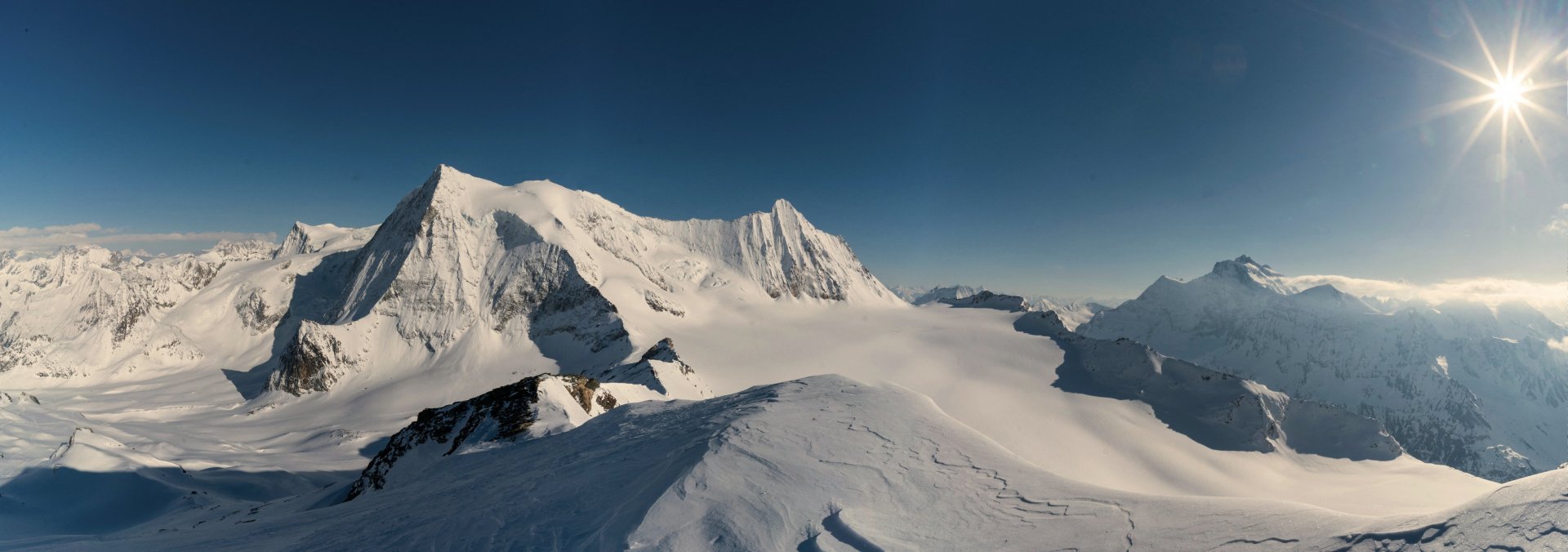
- Route Finder
- Route Planner
- Travel Guide
- Places to visit
- Eat & drink
- Accommodation
- Ski resorts
- Current Conditions
- Avalanche Report
- Collections
- Travel Stories
- Publications
Ski tours in Haute-Savoie
Auvergne-Rhône-Alpes,France

- Show images Hide images
The 10 most beautiful ski touring routes in Haute-Savoie

Discover many more routes in the Route Finder
Try planning your own routes
- Everything in Winter Sports
- Winter Hiking
- Ski Touring
- Snowshoe walking
- Backcountry Skiing
- Long Distance Ski Touring
Forecast for Haute-Savoie

Find ski tours in neighboring regions
Discover other ski tours within haute-savoie, similar activities in haute-savoie.
Backcountry Skiing across the Haute Route Traverse
Your tour starts in Chamonix, France
Things to know
Following the footsteps of pioneers, cross the French-Swiss border in the most epic way possible—by ski touring the world’s most renowned ski touring route. Set out on a 7-day Haute Route traverse, a journey through the heart of the Alps that skiers have been crossing off their bucket lists ever since 1911. With Chamonix-Mont-Blanc as your starting point, an alpine hut-to-hut venture takes you to the glacier paradise of Zermatt, lying at the foot of Matterhorn. Experience a daily change of surroundings as you make your way across steep passes and hidden valleys, or switch between mighty glaciers—and even mightier ski descents. This is ski touring at its best—dare to undertake this premiere alpine journey with an expert guide leading the way.
Traverse the most famous ski route in the world
Week-long exploration of the Alps scenery, mostly above 3,000m
Tour Chamonix and Zermatt, two spots highly coveted by any skier

Haute Route is the mother of all ski touring traverses. Threading its way through steep Alps, the route takes you from hut to hut—from Chamonix, the birthplace of modern alpinism and ski mountaineering, to Zermatt in Switzerland—in a matter of 7 days. Cross some of the world’s most spectacular mountain terrain, and explore high mountain passes and broken glaciers. Expect a perfect mix of big Alpine days fused with European comforts, including local cuisine and fresh après-ski scene!

Ease into your Haute Route adventure by doing mandatory classic laps on the Mer de Glace, the largest glacier in France. Shake the jet lag, stretch the legs, and prepare for the challenge ahead!
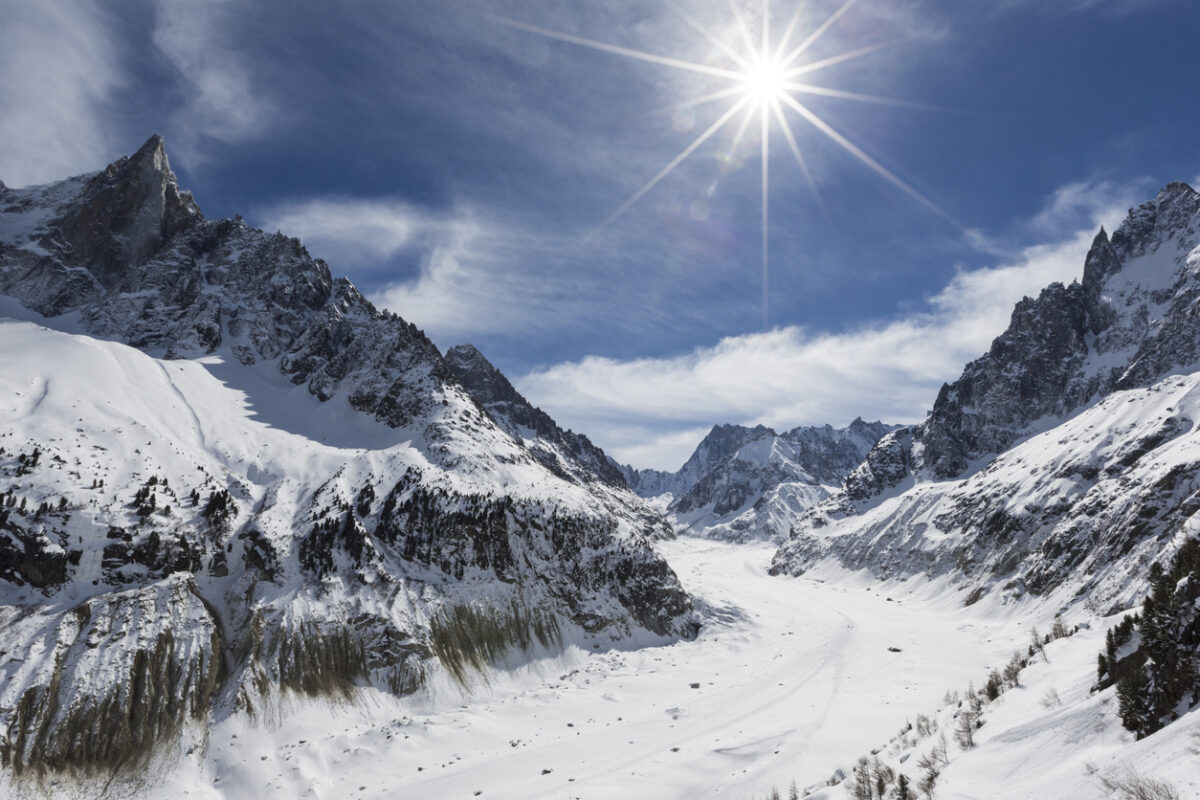
To kick off the Haute Route Traverse, you’ll ski down the Argentière glacier from the Grand Montets lifts. You have two options here: the classic option through the Col du Chardonnet or the Col du Passon. Both lines are similar in length and involve a steep snow section. Once through the Col, it’s smooth sailing to the Trient Hut, one of the highest ones on the route at 3,200m (10,500 ft). Ascent : 1,100m (3,610 ft) Descent : 1,600 (5,250 ft) Length : 10km (6 miles)
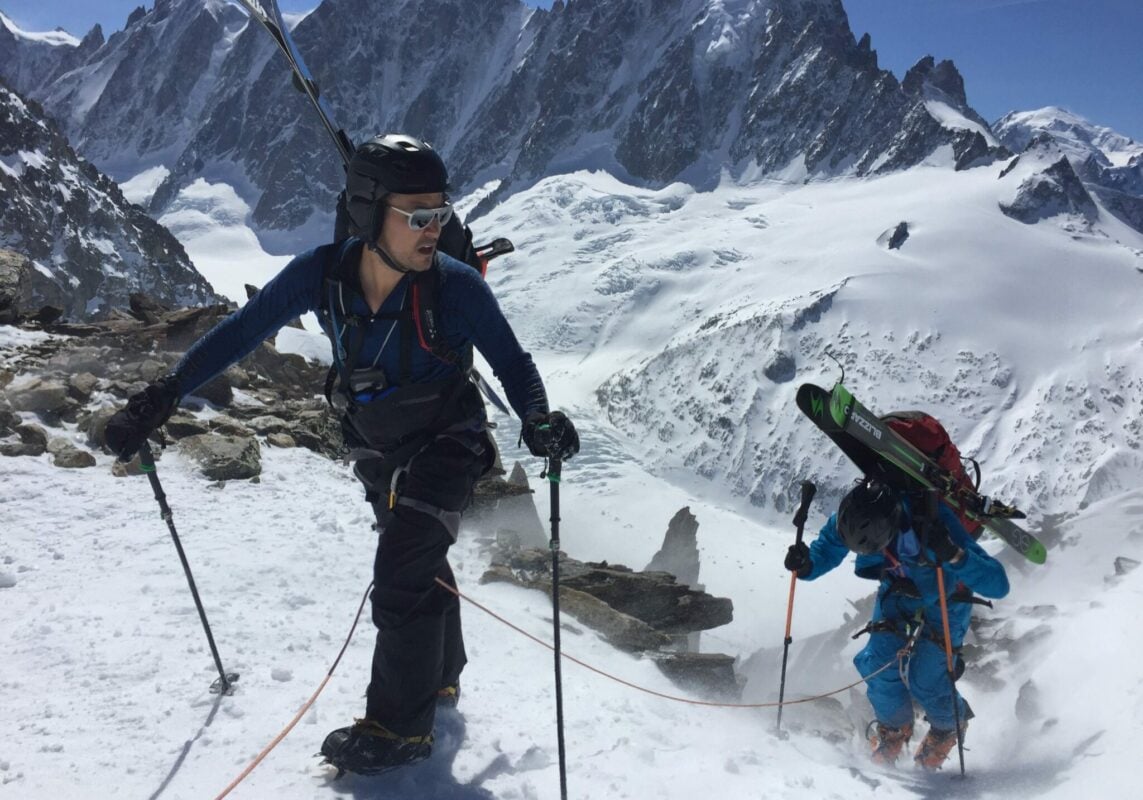
This is a more gentle day to recover from the previous one. A short glacier ski through wild glaciers takes you to the most technical climbing section of the route, Col des Ecandies. A 200-meter (656-foot) bootpack sets you up for a 1,600-meter (5,250-foot) cruise down the Val Ferret to the Swiss village Champex. A one-hour taxi ride takes you to Verbier, a village in south-western Switzerland where you’ll spend the night. Ascent : 200m (660 ft) Descent : 1,800m (5,906 ft) Length : 10km (6 miles)
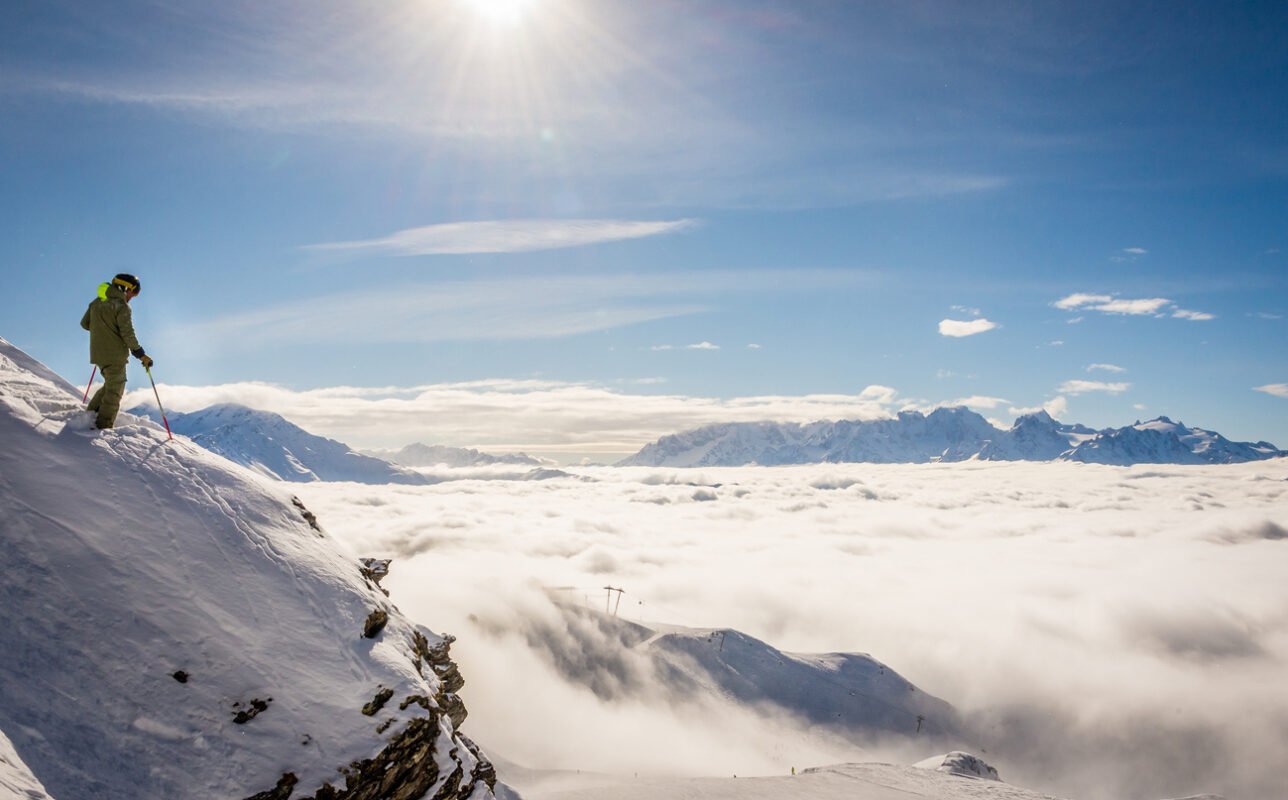
Catch the first lifts to the top of Mont Gelé standing at 3,519m (11,550 ft) above sea level. A quick skin up the piste and over the Col de la Chaux takes you across a quick traverse, descending to the Lac du Petit Mont-Fort. From there, you start a long climb up to the Rosablanche mountain before a long descent to the Prafleuri. Treat yourself to a pint of good brew and get some well-deserved rest! Ascent : 1,200m (3,940 ft) Descent : 1,550m (5,085 ft) Length : 11km (7 miles)
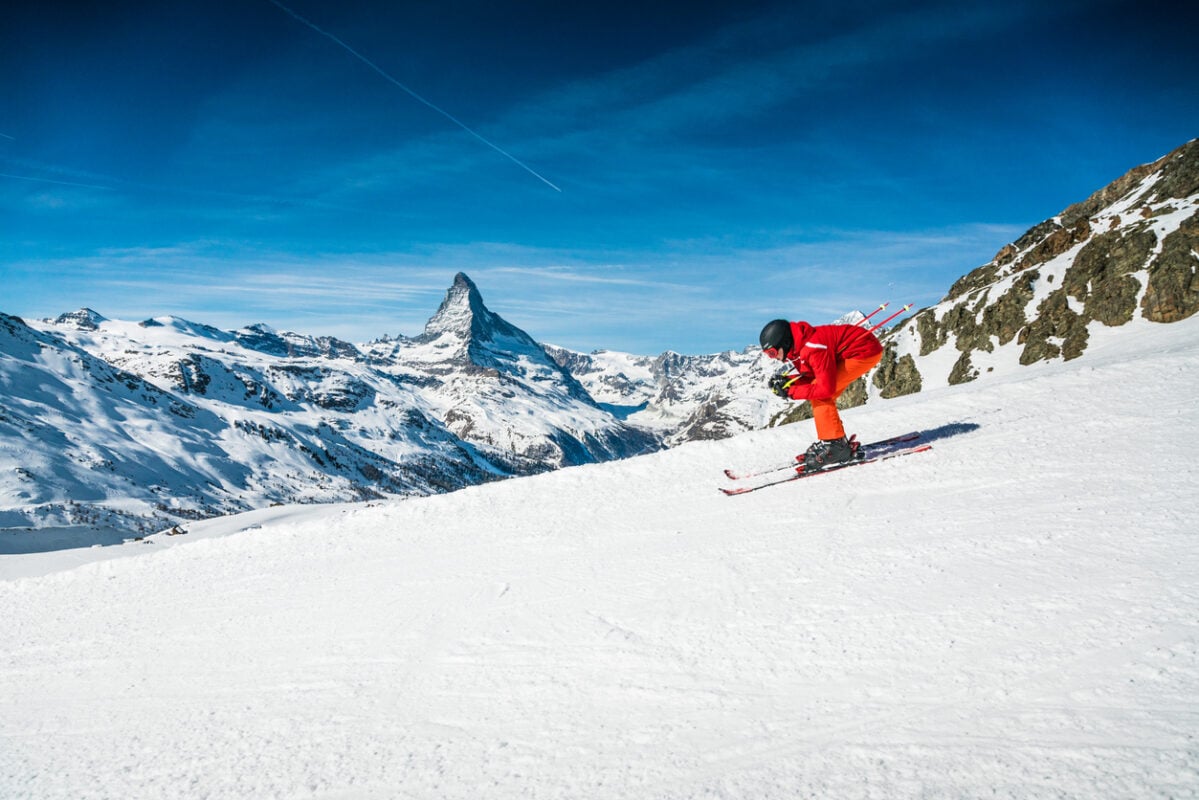
A quick early-morning climb up the Col des Roux sets you up for a long traverse above Lac des Dix. From the edge of the lake, a long skin takes you to what might just be the best hut of the trip, the Cabane des Dix. Once at the hut, you have two options: beer and rösti or more ski runs. Ascent : 1,000m (3,280 ft) Descent : 700m (2,300 ft) Length : 9km (5.5 miles)
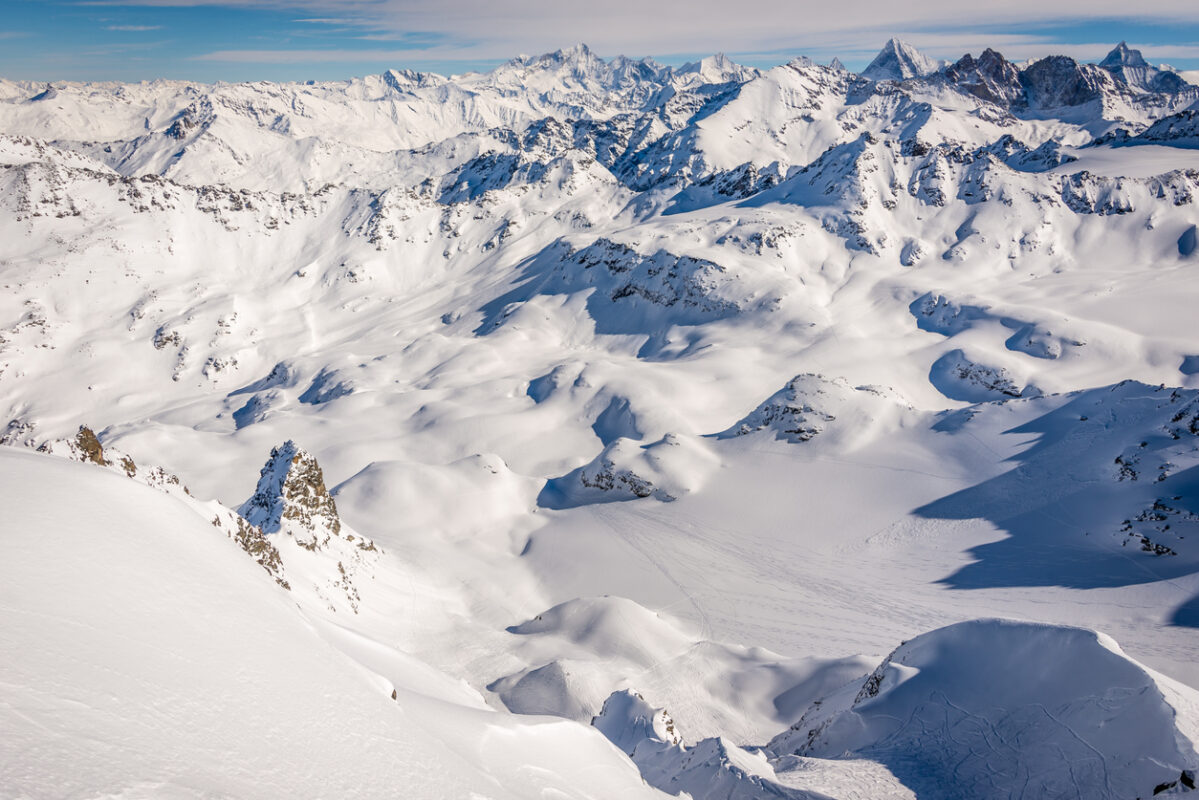
This day is a big up followed by a big down. First you’ll head up the Glacier de Tsena Réfien over the spectacular passage de la Serpentine and finally to the summit of the Pigne d’Arolla, the highest point of the route at 3,790m (12,440 ft) above sea level. Shed your skins and ski down the Glacier de Pièce to the steps of the Cabane des Vignettes for the evening. Ascent : 1,000m (3,280 ft) Descent : 750m (2,460 ft) Length : 9km (5.5 miles)
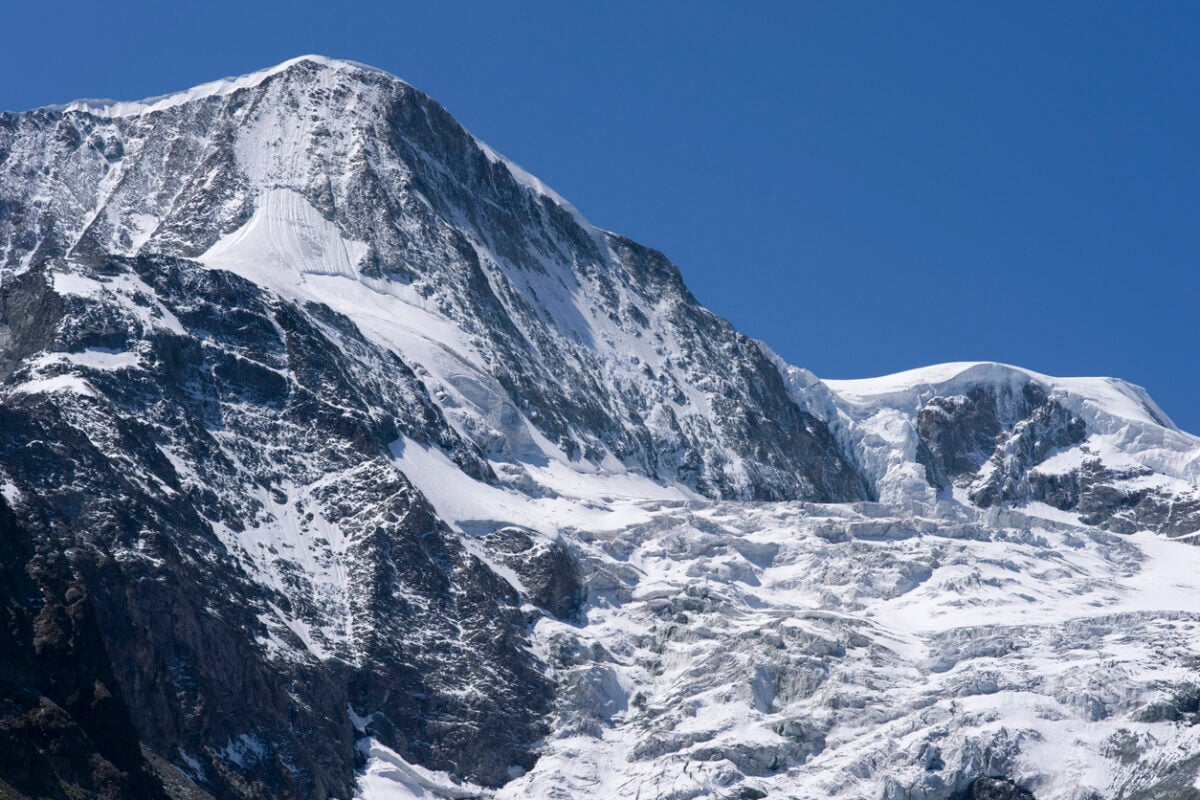
An epic day ahead of you brings this traverse to an end. Pass over 3 cols, 7 glaciers, and 3,200m (10,500 ft) of descent, amounting to 29 km. This big day will certainly have you craving for a celebratory drink along with some traditional Swiss food. Your guides can organize transport back to Chamonix or they can arrange for your luggage to be shipped. Ascent : 1,700m (5,580 ft) Descent : 2,200m (7,220 ft) Length : 29km (18 miles)
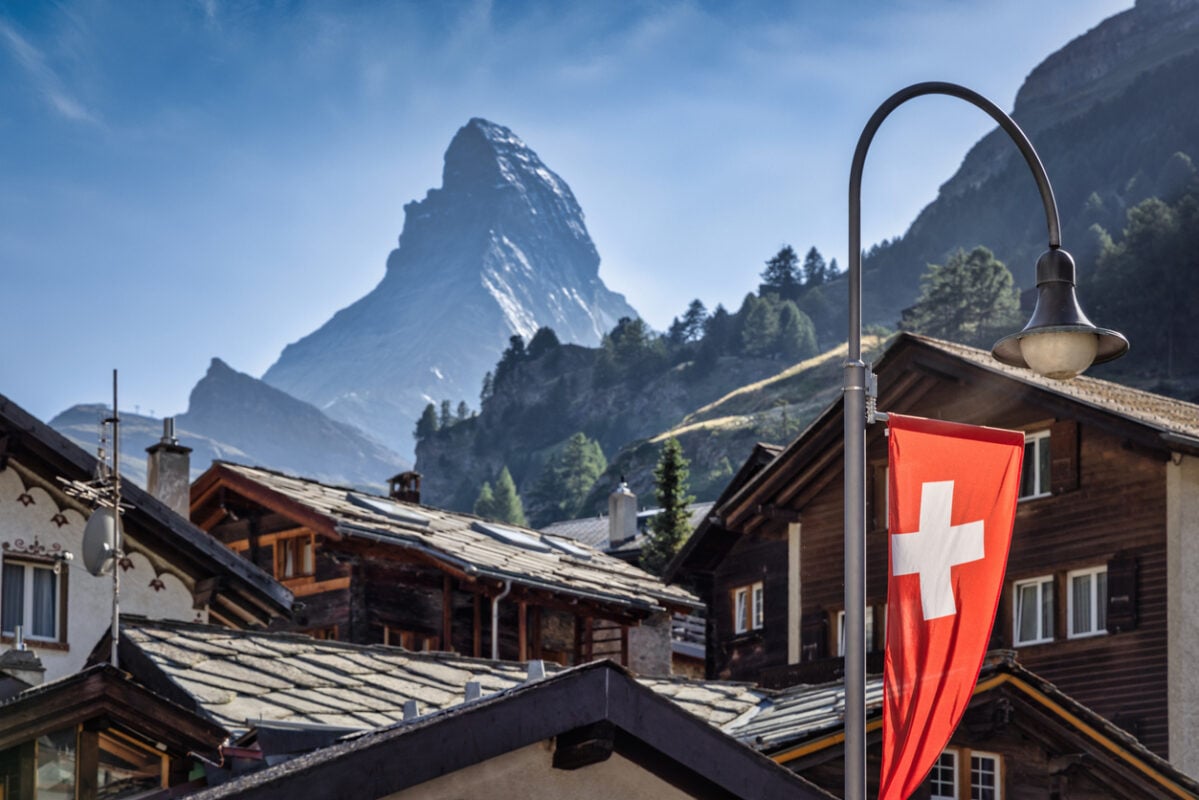
Meet your guide
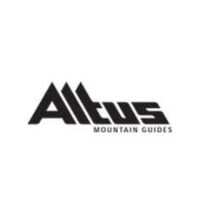
Excellent guide service. From the moment of booking to the end of the course, the staff and guides were helpful, enthusiastic, patient, and very knowledgeable. Highly recommended.
Fantastic mountain guides whom I would come back to anytime. My experience with Altus has been on three different occasions: ice climbing, ski touring and mountaineering, and each time had an awesome adventure. Their guides are extremely knowledgeable, inspiring, thorough, and able to cater to individuals’ preferences and needs
What you get on this adventure:
- An experienced, certified ski guide with extensive knowledge of the area
- 7 days of guided ski traversing
- Transportation during the tour
- 5 nights of accommodation (no accommodation on day 0, 1 and 7)
- All meals — breakfast, lunch, and dinner (except for dinner in Verbier, Zermatt, and on day 7, as well as all meals on day 0 and 1)
What’s not included:
- Technical backcountry ski touring equipment
- Transportation to and from Chamonix
- Airport transfers — we recommend Mountain Drop-Offs
- Alcoholic beverages or additional beverages and snacks
- Accommodation before and after the tour
- Accommodation on day 0, 1 and 7 of the tour
- Dinner while in Verbier and Zermatt
- Meals on day 0 and 1
- Travel insurance
- Rescue insurance (needed for skiing in Switzerland)
- Guide gratuities — optional
To enjoy this guided Haute Route Traverse, you need to be in excellent physical condition. Apart from that, you need to have previous backcountry skiing experience and advanced ski ability is required (black diamond runs). You will be on your feet for 7 full days for an average of 6 miles (10km) per day, with the last day amounting to 19 miles (30km). You will need to manage controlled descents and ascents in variable conditions, as the largest day requires 4,593 ft (1,400m) of climbing over 9,843 ft (3,000m) of elevation. All participants should feel comfortable on challenging black-level resort runs and be able to carry a loaded daypack while skinning up variable degrees of terrain.
To participate in this tour, you need to have extensive previous backcountry skiing experience. You will be skiing, touring, and summiting on glaciated terrain for 5-7 hours every day. If you’ve never backcountry skied before, we suggest joining a guide for a day of touring in Chamonix and Mont Blanc .
For technical backcountry ski touring gear, you will need to bring:
- Alpine touring skis, telemark skis or splitboard with skins (can be rented)
- Touring boots and poles (can be rented)
- Lightweight ice axe and ski-touring crampons
- Digital, 3-antenna avalanche transceiver or beacon
- Lightweight snow shovel
- Avalanche probe
For personal items, we recommend bringing:
- Backpack large enough to carry all items listed (around a 30-40L backpack)
- Sunglasses or ski goggles
- Gloves and hat
- Wind and waterproof shell jacket with hood (Gore-Tex recommended)
- Wind and waterproof ski pants (Gore-Tex recommended)
- Lightweight, breathable jacket and pants
- Insulated jacket (synthetic insulated jacket)
- Balaclava or a neck warmer
- Synthetic or wool base layers, underwear and socks
- Hut clothing and shoes
- One triple-action locking carabiner or two conventional locking carabiners
- Repair kit and Leatherman for your equipment (can be shared between several people)
- Water bottle and 1L of water
- Small light quick dry towel
- Thermos with a warm beverage — optional
- Food you can eat on-the-go
- First aid kit
- Camera — optional
All mandatory gear can be rented from one of the manifold rental shops in Chamonix. If you don’t have your own, you can rent:
- Avalanche safety pack, including backpack, beacon, shove, and probe
- Alpine touring or telemark skis, touring boots, and poles
- Splitboards
- Glacier gear and helmet
Gear rental locations are in Chamonix and should be picked up the night prior to your outing. If you need to rent gear, let us know and we can help make arrangements.
Group sizes and prices:
- For this guided Haute Route Traverse, the usual client-to-guide ratio is 6:1.
- The cost is per person and doesn’t decrease as the group grows.
Backcountry skiing across the Haute Route Traverse can be arranged for larger groups. Contact us to make arrangements.
Min. age requirements:
- If you are older than 18, you’re good to go.
All participants must complete a liability waiver, which is sent to participants upon booking and must be completed online or in paper form before the trip date.
To get to Chamonix, most people fly into Geneva International Airport (GVA) , one hour away. Once you arrive, there are several ways to reach your destination, including public transport. Looking to make airport transfers hassle-free? Check out Mountain Drop Offs —they provide door-to-door service in their comfy and spacious shuttles. Use the code 57HCHX to get a 5% discount!
Once you and your guide agree on the details of your itinerary, your guide will suggest the best place to meet. Most likely it will be the Moö Bar on day 0 or Aiguille du Midi on day 1. The guide will choose the appropriate terrain dependent on conditions and the ability of the group.
57hours is committed to providing safe outdoor adventure experiences. We require all guides using our platform to have a COVID-19 safety plan and to make the details of that plan accessible to travelers. In most cases, group sizes will be reduced, guides will avoid overcrowded locations, and other safety measures will be met depending on the location and activity.
We also expect clients to respect local regulations and take measures to protect themselves, their guides, and the communities they’re traveling to. For more information on COVID-19 measures in France and Switzerland, please refer to France Diplomacy’s COVID-19 Information and Switzerland’s Travel Advisory by the Federal Office of Public Health .
Please contact us if you have any questions or require further information. We are happy to provide you with the most up-to-date information!
A 30% deposit to secure your place is due upon booking. The remaining amount is paid 2 months (60 days) prior to departure. Once the trip is confirmed by the guide, the cancellation policy stated below applies.
- If Client cancels the Booking anytime prior to thirty (30) calendar days in advance of the trip contemplated by the booking, Client is entitled to a full refund.
- After that deadline, Client is not entitled to any refund. Any reimbursable expenses arising out of the Booking incurred by Guide prior to the date of cancellation (including but not limited to plane tickets, car rental payments, and lodging or transportation fees) are non-refundable as soon as they are incurred by the Guide.
Other things to do in France

Backcountry Skiing in La Grave

Skiing Across 3 Countries from Chamonix

Off-Piste Skiing in the Mont Blanc Massif

Private Exclusive Gran Paradiso﹠Mont Blanc Ski Tour

Holiday Off-Piste Skiing in Chamonix
View all (37) adventures in France
Choose a currency
- USD - $ US Dollar
- EUR - € Euro
- AUD - AU$ Australian Dollar
- CAD - CA$ Canadian Dollar
- GBP - £ British Pound Sterling
- CHF - CHF Swiss Franc
- JPY - ¥ Japanese Yen
- SGD - S$ Singapore Dollar
- HKD - HK$ Hong Kong Dollar
- DKK - Dkr Danish Krone
- NOK - Nkr Norwegian Krone
- SEK - Skr Swedish Krona
Haute Route Ski Traverse
A world classic tour with all the amenities
The Haute Route is a classic ski tour through the heart of the Western Alps and some of its most stunning scenery. First completed in 1860, this high-level mountain traverse covers more than 75 miles / 121 kilometesr of alpine terrain, crosses 12 different glacier systems, and connects the two major mountain centers — Chamonix, France and Zermatt, Switzerland.
This route is perhaps the most famous ski tour in the world. There are few places in the world where skiers can travel unencumbered in the heart of the mountains, over high cols, hidden valleys, and immense glaciers. The huts allow us to enjoy the skiing as only traveling light can. You’ll witness an amazing mixture of cultures while staying in these huts as you socialize with ski mountaineers from around the world who are also taking on the challenge of the Haute Route.
You’ll savor the delights of the Alps from the comforts of the charming French and Swiss alpine hut system, which offers warm beds, fully catered meals, and wine. Just to be up in the mountains with such comforts might be enough for some, but you’ll also enjoy 4,000 – 8,000-foot / 1219 – 2438-meter descents while crossing high mountain passes, taking in incredible views of Mont Blanc and the world famous Matterhorn. You may even take in a bite of Swiss cheese and a glass of wine at the end of this incredible ski journey.
Description
The Haute Route is a tour for skiers with advanced skills who are able to ski in variable snow conditions. Skiers should be able to ski “ off piste” in all types of ungroomed snow. Also, for our climbs skiers should be able to execute uphill kick-turns without difficulty. This is a challenging tour which requires skiers to be in excellent shape not just for the downhill skiing but also for the uphill sections. A basic knowledge of general mountaineering techniques is helpful but not necessary. Any specialized mountaineering techniques required for this tour can be learned from Mountain Madness Guides during the first couple days of the trip. We will meet in Chamonix on the afternoon or evening before the tour begins to answer questions, begin packing, and finalize other logistics.
Have a Question? Contact Us!
- (800) 328-5925
- [email protected]
$3,150 – 8 Days / In country
Price Includes
- IFMGA/UIAGM certified guide
- 4 – 5 nights in alpine huts
- Breakfast and dinner in huts
- Cable car and bus fees
- Group climbing gear
Price Does Not Include
- International airfare
- Train to/from Chamonix and Zermatt
- Meals other than ones included with huts
- Hotel accommodations
- Cable car & bus fees
- Personal climbing gear and clothing
- Alcoholic and bottled beverages
- Personal expenses (phone calls, laundry, room service, etc.)
- Travel insurance with trip cancellation, medical and evacuation policy
- Additional charges incurred as a result of delays beyond the control of Mountain Madness
- Guide/Staff gratuities
Payment Schedule
- $700 deposit at time of registration, which includes a $300 non-refundable registration fee
- Balance due 120 days prior to departure
- The balance may be paid by check, wire transfer, ACH or credit card with a 3% convenience fee
Dates In-Country / Custom Dates Also Available 2023
- Mar 23, 2023 — Mar 30, 2023
Cancellation / Refund Policy
- MMI strongly recommends trip cancellation/interruption and evacuation insurance for all trips. Our insurance partner, Ripcord , offers comprehensive travel insurance including trip cancellation, as well as rescue/evacuation policies and can assist in answering any questions. In addition, Participant is expected to have sufficient medical insurance as prescribed by their country of origin. Participant understands that MMI does not include any type of insurance with the cost of the trip.
- If you decide to cancel your trip or change your itinerary, MMI must be notified in writing. Your trip will be cancelled from the date written notice is received. If proper written cancellation notice is not received, amounts paid and reservations made will be forfeited.
- Non-refundable fees may apply for certain trips in order to secure permits and other services. MMI must strictly adhere to cancellation policies outside MMI’s control.
- Due to the personalized service we offer on our trips, MMI reserves the right to waive any fees. We will attempt to accommodate changes and cancellations, waiving certain fees when feasible.
- Circumstances outside the control of MMI and its partners, may require amended cancellation/refund policies. Such circumstances may include, but are not limited to COVID-19, natural disasters, wildfires, terrorism and so forth.
International Trips/Courses:
- Full refund, less the non-refundable registration fee, will be provided 121 days or more before the departure date
- No refunds will be provided 120 days or less before the departure date
Trip Insurance
We strongly recommend the purchase of travel cancellation insurance to protect you from the unexpected. You aren’t likely to think of it now, but people do get ill, break a bone, have a family emergency or get assigned to a last-minute business trip. If you are in remote areas, please note that emergency rescue & evacuation can be very expensive.
We also strongly urge you to consider rescue and evacuation insurance if your own policy does not provide the coverage needed. Services available may include, but are not limited to, helicopter evacuation, medical care, etc.
If you choose not to purchase insurance, you assume full responsibility for any expenses incurred in the event of a medical emergency and/or evacuation, as well as for trip cancellation, interruption, lost luggage, etc. We are not the experts and therefore ask that you please consult our travel insurance partner directly with any specific questions.
To protect against losses due to illness, accident, or other unforeseen circumstances, Mountain Madness strongly recommends the purchase of travel insurance as soon as possible after making a deposit. Mountain Madness has partnered with Redpoint Resolutions as our preferred travel insurance provider. Redpoint’s Ripcord Rescue Travel Insurance™ is designed for adventurers.
For a quote, or to purchase travel insurance, please click this link Ripcord Rescue Travel Insurance™ or call +1 – 415-481‑0600. Pricing varies based on age, trip cost, trip length, and level of coverage.
Critical benefits of Ripcord Rescue Travel Insurance include:
- A completely integrated program with a single point of contact for emergency services, travel assistance, and insurance claims
- Evacuation and rescue services from your point of injury or illness to your hospital of choice
- Comprehensive travel insurance for trip cancellation/interruption, primary medical expense coverage, baggage loss or delay, emergency accident and emergency sickness medical expense, emergency dental, accidental death and dismemberment, and more
- Optional security evacuation coverage in case of an unplanned natural disaster or other security events
- Waiver for pre-existing conditions (must be purchased within 14 days of tour deposit)
- Optional “ Cancel for Any Reason” coverage (must be purchased within 14 days of tour deposit)
Flight Information
We advise you to fly into Geneva, Switzerland. Plan your arrival in Chamonix on the evening of Day 0 or the morning on Day 2. From Geneva book private transfer to Chamonix. Transfers from the Geneva airport to Chamonix should be booked in advance. You can see a list of transfer companies here . Your return flight should depart Geneva late afternoon/evening on day 10. Included in the cost of your trip are hut breakfasts and dinners.
Haute Route Ski Traverse Day by Day
Hotel, Chamonix
Check in to your hotel and get organized for tomorrow’s departure. There will be a meeting with your guides at 3 pm to go over equipment and logistics. Chamonix is a beautiful, quaint French town with many great shops and restaurants.
Chamonix — Vallée Blanche Ski Descent
Meet in the morning at the Aiguille du Midi Tram and discuss the route plan for the day. Ride the tram to the top of the epicenter of alpinism and ski mountaineering in Chamonix. After exiting the tram tunnel, prepare to have your mind blown by the scale and fast access to impressive glaciated ski terrain. The day will be spent with a ski of the Vallee Blanche where we have the opportunity to practice skills on glacier. Hotel night in Chamonix.
Trient Hut
Today we get an early start and ride the tram at the Grand Montet and cross the Argentiere Glacier to reach the Col du Chardonnet. With a steep descent (likely belayed) on the Swiss side, we cross the Fenetre de Saleina then continue to the Trient Hut (10,370ft., 3170m). 7 – 8 hours
Val D’Arpette
Cross Col des Ecandies (9,145 ft., 2796m) and descend to the Val d’Arpette to the quaint village of Champex, situated by a pristine alpine lake. We will take a short break from the alpine environment and have a van transfer to Verbier (45 minutes). In Verbier we will use the lift system and a descent to reach the Mont Fort Hut. We can drop extra gear at the hut and ski some of the exceptional terrain the Verbier area has to offer, or relax in the hut in preparation for the days ahead. 4 – 5 hours to hut
Prafleuri Hut
Today we climb over the Col de la Chaux and the Col de Momin, where we enter the Grand Desert glacier. The group will continue to the summit of Rosablanche, and have a 700m descent to the Praflueri Hut. If time and energy allows, there are excellent afternoon ski tour options with light packs from the hut. 4 – 5 hours
Today we ascend over Col des Roux and start a descending traverse above Lac des Dix. From the lake, we ascend to the Tete Noir where the Dix Hut is located. 4 – 5 hours
Vignettes Hut or Nacmuli Hut
Traverse high above the village of Arolla (Pigne d’ Arolla) to the Vignettes Hut (10,340ft., 3160m). The Vignettes Hut offers an incredible position on an exposed rock point surrounded by glacier. From the hut, there is beautiful view back down the glacier and out to the mountains we will traverse through the next day. 5 – 6 hours
Today we will descend slightly before climbing the Col de‘Eveque (11,095ft., 3392m). A 500m descent brings us to the Haute Glacier de Arolla. After crossing this glacier, we ascend to the Col du Mt. Brulé (10,510ft., 3213m) and onto to the Col du Valpaline. After enjoying the 2400m descent down the Stockji glacier under the North Face of the Matterhorn and into Zermatt, our adventure comes to a close. 8 – 9 hours
Return to Chamonix or depart for home.
Note on Itinerary: Although we do our very best to follow the schedule listed, this itinerary is subject to change due to inclement weather, unsafe route conditions, or other reasons beyond our control and in the guide’s best judgement.
Equipment for Haute Route Ski Traverse
Carrying gear, ski pack (35-45l).
35 to 45 liter capacity, avoid unnecessary options that add weight. Ideally a ski specific pack with avalanche tool pocket
Sleeping Gear
Sleeping bag liner.
Blankets and pads provide by the huts
Climbing Gear
Alpine climbing harness.
Must have adjustable leg loops and fit over all clothing
Black Diamond Couloir, Petzl Altitude, Petzl Hirundos
Locking carabiners (3)
Three large, pear-shaped carabiners are best
Black Diamond Rock Lock, Petzl William, Petzl Attache
Non-locking carabiners (3)
3 non-locking carabiners. wired straight-gates are recommended
Black Diamond HotWire
Mountaineering ice axe
under 5’7” use 60cm, 5’7”-6’2” use 60 or 65cm, over 6’2” use 70cm
Black Diamond Raven, Petzl Glacier
Black Diamond Whippet pole (optional)
nice to have on steep snow
Crampons w/ anti-balling plate
Steel 12-pont. Must be fit to climbing boots prior to trip, new-matic/hybrid type
Black Diamond Sabretooth, Petzl Vasak
Splitboard/Ski specific crampons
for all ski mountaineering trips
Climbing helmet
Lightweight
Black Diamond Half Dome, Petzl Elios
30’ of perlon accessory cord (6mm)
30 feet of 6mm cord
with alpine touring or telemark bindings
Split snowboard
backcountry touring specific snowboard
Collapsible Ski Poles
adjustable ski poles with powder (big) baskets
Climbing skins
with Glop Stopper skin wax
small collapsible style
Avalanche Beacon
beacon needs to be on 457 frequency
Avalance Probe
no ski pole probes!
Snow study kit (optional)
optional except the Level 2 course
Snow saw (optional)
optional but recommended
Head and Face
Fleece or wool hat.
It must cover the ears
Glacier glasses
100% UV protection with side shields and a hard-sided storage case
Shade hat or baseball cap
A visor hat with a good brim is essential for protection from the sun
Mountain Madness trucker hat
Light weight work gloves
lightweight gloves with leather palm for rope work
Black Diamond Transition Glove
Mid-weight gloves
Black Diamond Punisher Glove
Heavyweight shell glove
Gore-tex or equivalent (trips before July)
Black Diamond Enforcer Glove
Thick socks (2 pair)
Two pairs of synthetic or wool socks, medium to heavyweight. Check boot fit with thin and thick socks on
Smartwool or Thorlo
Thin socks (2 pair)
Two pairs of synthetic or wool socks to wear under heavy wool socks to help prevent blisters and keep feet dry
Smartwool or Cool Max
Alpine touring ski or snowboard boots
lightweight
Synthetic t-shirts
Two synthetic or merino wool t-shirts. No cotton!
Long-sleeved Base Layer
Two lightweight to mediumweight, pull-over is best
Patagonia Capilene
Sports bras
Two, synthetic, no cotton!
Softshell Jacket w/ hood
This is what you will be wearing while hiking at higher altitudes or while kicking around camps at lower altitude. This jacket should be full-zip
Outdoor Research Ferrosi
Light weight synthetic jacket
light weight synthetic puffy or fleece
Patagonia Nano Puff jacket
Hardshell jacket w/ hood
A good jacket made of Gore-Tex (recommended) or waterproof nylon, roomy enough to fit over multiple layers
Outdoor Research Foray, Patagonia Triolet
Down or synthetic jacket w/hood
This is your most important piece of warm gear and will mean the difference between an enjoyable climb or a miserable one. A warm, full zip jacket with hood is ideal.
Helly Hansen Vanir, Feathered Friends Volant, Marmot Guide’s Down Hoody, Outdoor Research Virtuoso Hoody
This piece with a high SPF rating and lightweight fabric offers protection from high altitude sun
Outdoor Research
Long base layer
Two pairs light or mediumweight
Softshell pants
Softshell pants are water resistant, yet highly breathable and durable. Great for colder conditions over a pair of long underwear or tights higher on the mountain or summit day
Outdoor Research Voodoo, Mountain Hardwear Touren, Patagonia Guide
Hardshell pants
waterproof and breathable with side zips (minimum of ¾ zips recommended) Gore-Tex or equivalent
Outdoor Research Furio, Arcteryx Beta AR
Miscellaneous
Personal first aid kit (nw).
moleskin/blister kit, Band-aids, athletic tape, ibuprofen, personal medications, ect
Must have SPF rating of 20 or more. Bring two just in case!
Bring plenty of sun block with SPF of 40 or more. It's easy to underestimate the amount necessary for your trip!
Hand sanitizer
enough to last trip length
Bring extra batteries!
Water bottles
two 1 liter wide-mouth water bottles
Hydration bladder (optional)
hydration bladder or water bag with drinking tube (must also have 1 Nalgene Bottle or equivalent)
Water purification (NW)
Purifies drinking water while on the climb
Steri Pen, water filter, Potable Aqua, Polar Pure crystal iodine
Small stainless-steel thermos (optional)
For hot beverages on summit day

Pocket knife or multitool
Simple Swiss Army type with scissors. Make sure you transport in checked bag, not carry-on!
Toiletry kit (NW)
toilet paper stored in double zip lock bags
Nylon stuff sacks
for food and gear storage, large ziplocs are useful
Large plastic bags
heavy duty trash compactor bags recommended
Bandana (optional)
Snacks (general).
Bring your favorite snacks and power/energy bars or if there is something else you particularly like to eat while hiking and climbing
Voile Ski Straps (2)
multi functional for repair or emergency
Camera (optional)
or any sort of device that takes pictures
Soap, shampoo, towel (optional)
for use at campground showers when on itinerary
Travel clothing
Comfortable clothing for travel before and after the expedition
8 Days / In country
Haute Route
Previous experience required. Call for details. 800−328−5925
Training Trips
North America Washington
Mount Baker Ski & Snowboard Descents
- 2 Days / Includes Transportation, Tents and Food
Difficulty Intermediate
Ski Mountaineering Course
Forbidden inspiration ski tour.
Difficulty Advanced
2-FOR-1 GA TICKETS WITH OUTSIDE+
Don’t miss Thundercat, Fleet Foxes, and more at the Outside Festival.
GET TICKETS
BEST WEEK EVER
Try out unlimited access with 7 days of Outside+ for free.
Start Your Free Trial
Powered by Outside
Why You Should Ski This Haute Route in the Dolomites While You Still Can
Climate change means you may not be able to do hut-to-hut ski tours in the alps forever..
Heading out the door? Read this article on the new Outside+ app available now on iOS devices for members! >","name":"in-content-cta","type":"link"}}'>Download the app .
Skiing is a sport, perhaps more than any other, that is based on trust. A trust born from thousands of successful past repetitions. Trust in your ski edges, pole plants, muscle memory, leg strength, ski partners, and most importantly, your ability to manage the nagging fear in the back of your brain. As I clicked into my skis on the top of our first exposed, no-fall ridgeline, that nagging fear was as loud as Defcon 4.
The 2021-’22 winter in the Dolomites was downright terrifying. It was mid-March when we arrived in Cortina d’Ampezzo , the crown jewel of the Italian Alps and host of the 1956 Olympics. It hadn’t snowed in 72 days. It was the lowest snow year on record, dating back 200 years. Not ideal conditions for a five-day hut-to-hut traverse, and certainly not what we’d hoped for. Low snowpack meant bootpacking up scree fields, fighting to keep an edge on bulletproof faces, and rerouting multiple times to find a trace of actual snow.
Which brings me to the most important—and least controllable—ingredient in the cocktail of trust: snow. Many of us can ski steeper slopes when you’re working with stable, boot-high powder. Turns come easy, small lapses in judgment or technical skills are forgiven, and fear fades into sublime joy. But when the surface is a buffet of ice slab, sun cups, and two-inch breakable crust, mistakes are amplified tenfold, and joy fades into fear.
The Proposed Haute Route
Six of us flew across the pond to traverse the Dolomites on what was billed as the “New Haute Route,” a hut-to-hut linkup that had all the elements to be truly special: glacial travel, mountain-top refugios, steep couloirs, jagged ridges, and a unique Ladin culture. The problem, as we would learn, was that the route was predicated on good snow.
Our trip was organized by Dolomite Mountains, a boutique logistics company. They managed the shuttles, guides, bookings, route, and offered gear rentals, too. Starting in the small town of Cortina, we would follow a summer Alta Via, or High Route, passing through a series of passes, peaks, and valleys only possible with the right touring gear, technical skills, and nightly stops at secluded backcountry huts.
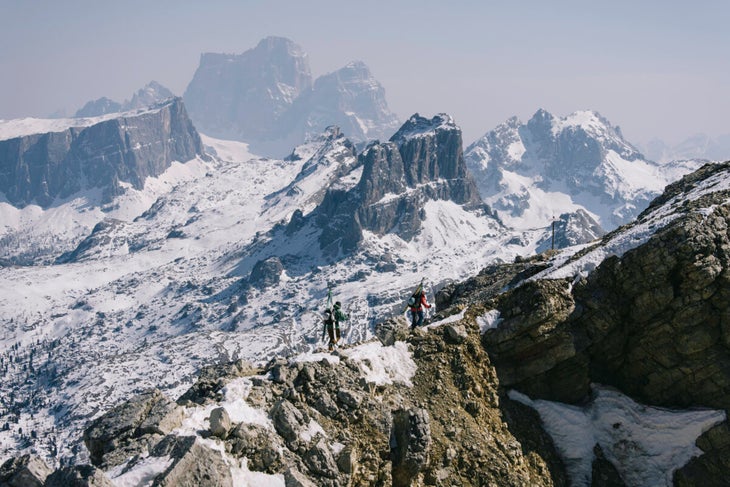
Along the way we would pass through a UNESCO Heritage Site and the Fanes-Sennes-Braies Nature Park , one of the largest protected areas in northern Italy. We would stay in some of the most well-known huts in the area: Rifugio Lagazuoi, Rifugio Fanes, and Rifugio Sennes, feasting on traditional Ladin meals. All told, the trip included six nights and five days exploring the Dolomites on backcountry skis, averaging 12 miles and 4,000 feet of skinning and skiing each day.
The Actual Tour
In the weeks leading up to the trip, we read reports of low tide. By the time we arrived, it felt more like July than March. Even though we started the trip at 6,000 feet and toured much higher, there were large patches of rock and grass everywhere. On a good snow year, the route would be great for intermediate to advanced skiers who would enjoy gradual climbs and smooth powder descents. The conditions we encountered, on the other hand, necessitated proficiency to ski widely variable snow. Think spring survival skiing, but worse.
We slogged through the first two days, wiping out any hope we’d find the elusive Dolomite powder turns the original trip was billed on. Skinning up ice, scrambling over rocks, dropping into lines with sun cups the size of beach balls, and so much mid-season melt that pockets of air under the surface collapsed under the weight of a skier. Dozens of refreezes without fresh snow had transformed entire slopes into freezer burn.
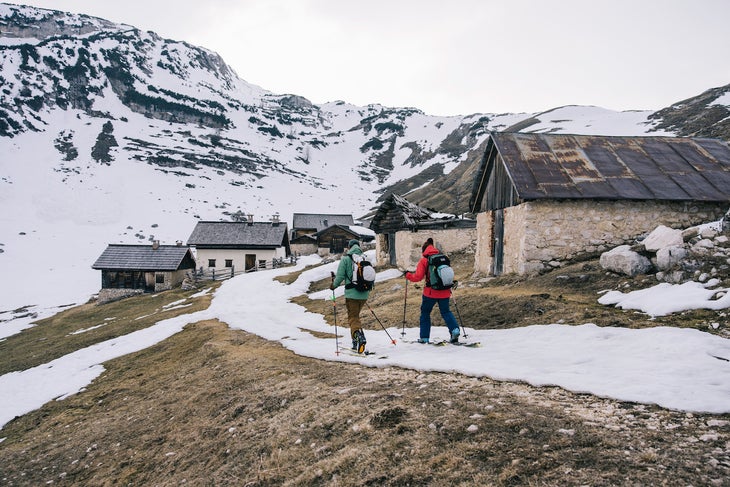
Predawn on our third morning, I snuck downstairs in our refugio early to journal. Sitting by myself at a small breakfast table before anyone but the hut owner stirred, irony sat inches in front of me. Stories of past climbers and skiers are woven into the fabric of the place. Every table and chair in the room was crafted by hand, with meticulous attention to detail. But outside was a much different, more disastrous scene. The looming effects of climate change were impossible to ignore. With a historically low snowpack, our ski tour became an epic, and not in the best ways.
Each day was a battle of attrition, pitting our persistence against better intentions of mother nature. Most of the descents were largely unskiable, forcing us to side-slip, jump turn, and carefully connect a few wiggles near run-outs, moving down as slowly as we had climbed up. Our third day proved the hardest when we had to navigate a no-fall traverse and slush bucket couloir begging to tear knee ligaments.
We ended up completing the full route safely, despite testing our collective wherewithal more than once. Like any adventure with a significant amount of Type-2 fun, these feelings slowly faded and have now been replaced by nostalgia. A year later and we’re planning a return trip to the Dolomites, hoping the snow gods will be more merciful this time.
Why You Should Still Go
The ski terrain in South Tyrol is undoubtedly world-class. Aesthetic peaks, faces that run thousands of feet to the valley floor, epic couloirs, and wide-open bowls are perfect for a variety of skill levels. From challenging skimo objectives to safe, low-angle hot laps, the potential for fun is everywhere. Warm huts, kind hosts, delicious food, and local wines complete what could be a trip full of real magic.

While our experience paints a clear picture of what’s to come a decade or two from now, it’s not a forecast for next winter, or even the winter after that. I’m hopeful we still have a few good snow years left. For avid backcountry skiers who enjoy full days and all the perks of a hut-to-hut experience, this Dolomite Haute Route should be near the top of your bucket list. The culture, refugios, and mountain views make it worth it by themselves. And, it won’t be around forever, so go while you still can.
Dolomite Haute Route Trip Details
- Info: dolomitemountains.com
- Duration: 6 days/5 nights
- Price: Starting at 3,160 Euros per person, includes lodging, breakfast and dinners, shuttle transfers
- Start: Val di Fassa/Alta Badia, Italy
- Challenge level: Moderate to challenging
- Best time to go: January to March
Planning Tips
Fly into Venice, Italy, and take an hour-and-half shuttle to Cortina. You’ll start and finish this route there, or you can choose other routes from the Dolomite Mountains. Most trips are five or six days, with additional travel time outside of that. Costs vary by itinerary, but plan for $3,000-plus per person, plus flights.
Gear Advice
For spring trips like ours, I would recommend a ski that’s 90-100mm underfoot and stiff enough to hold an edge on variable snow–something akin to the Blizzard Hustle 9 . You’ll be averaging 4,000 feet of vert and 12 miles of skinning and skiing each day, so when it comes to boots, prioritize lightweight comfort, i.e. alpine touring boots that have plenty of ankle articulation for miles of walking. Dolomite Mountains facilitate a gear shuttle, so during the trip, you’ll just need a day pack, large enough for avalanche essentials, spare layers, and food and water for the day. I used the Mountain Hardwear Powabunga 32 and loved it.
Popular on SKI

Join Outside+ to get access to exclusive content, thousands of training plans, and more.
Healthy Living
- Clean Eating
- Vegetarian Times
- Yoga Journal
- Fly Fishing Film Tour
- National Park Trips
- Warren Miller
- Fastest Known Time
- Trail Runner
- Women's Running
- Bicycle Retailer & Industry News
- FinisherPix
- Outside Events Cycling Series
- Outside Shop
© 2024 Outside Interactive, Inc
- Monte Rosa Spaghetti Tour
- Gran Paradiso
- The Triple Crown
Alps, Haute Route Ski Tour
Austria, otztal ski tour, swiss, bernese oberland ski tour, italy, gran paradiso ski tour.
- Tour du Mont Blanc Trek
- Dolomites, Alta Via 1
- Walkers Haute Route
- Tour Du Mont Blanc 11 Days
- Tour du Mont Blanc Highlights
- Haute Route Trek Guided 11 Days
- Ben Nevis: Skills & Climb
- Toubkal Summer: Prep Peak
- Toubkal Winter: Prep Peak
- North Wales: Mountaineering Intro
- North Wales: Alpine Prep
- Chamonix: Off-Piste Skiing Intro
- Chamonix: Ski Touring Intro
- Chamonix: Hut Ski Tour Intro
- Chamonix: Winter Alpine Skills
- Chamonix: Ice Climbing intro
- Tailor-Made
- Better Business
- Get In Touch
- Build an Adventure
Skiing / Snowboarding
The Haute Route ski tour has deservedly earned its reputation for being one of the worlds great ski adventures linking Mont Blanc with the iconic Matterhorn in the Swiss Alps. Embark on an epic 6 day challenge crossing spectacular glaciated terrain from Chamonix to Zermatt.
Adventure Snapshot
Start Location
Chamonix, France
March - April
From €1950.00
VIEW GALLERY
CHAMONIX TO ZERMATT ON SKIS
Setting off from the Mont Blanc valley, you will cover vast backcountry terrain until you reach the slopes below the Matterhorn in Switzerland 6 days later. Crossing through 2 countries and over many cols, this is a tough but rewarding experience you will not forget in a hurry. Epic descents and scenic climbs, this ski tour has it all. After many years of skiing the Haute Route we still keep discovering hidden gems and hidden powder pockets that keep us coming back for more. Our guides are all highly experienced IFMGA qualified ski guides with a vast range of knowledge that you’ll be sure to tap into during the trip. This trip runs with a minimum of 4 people and a maximum of 6 people. If you're worried you're not quite ready yet then you can take our test below. You can also join us on one of our intro trips or our 'entry level' hut to hut ski tour below. Intro Hut to Hut Ski Tour Haute Route Ski Tour 'Readiness' test Austrian, Otztal Ski Tour Ski Touring Intro Trip Off Piste Skiing Intro

Free Guide: The Haute Route Ski Tour
Everything you need to know about this famous ski adventure in our free 38 page guide including video content and our 'readiness test'.

YOUR ADVENTURE STARTS HERE
Who is this for.
You should be fit enough for 6 hut to hut days of hard work (5-8h/day of uphill work out) and capable of skiing in different types of off-piste snow conditions. You will also need previous ski touring experience ideally of a previous hut to hut trip, at the very least an introduction course. This is a tough but rewarding journey across one of the best ski routes on the planet and it can only be enjoyed fully if you are well prepared. Please take our readiness test before booking this trip. This will give both of us a good understanding of whether you're ready for the trip. The last thing we want is to put you in an environment that doesn't match your ability or isn't safe.
If you're a confident off-piste skier but have never ski toured before then you can jump on to one of of our intro to ski touring courses (Learn more here ). If you're still not sure whether you're ready, no sweat! Get in touch and we'll be happy to talk it through with you. You can also take our Haute Route Ski 'Readiness' test and find out Test
Adventure Overview
Guide Ratio
You have a fair amount of experience climbing, hiking or skiing more technical terrain. You’re comfortable on sustained adventures and you call yourself a ‘hardened’ adventurer. You're not quite George Mallory but you subscribe to his 'because it there' attitude.

ENVIRONMENTAL RESPONSIBILITY
Great news! Your place on this adventure is carbon offset along with our footprint in creating it. To learn more about what we're doing head to our 'Better Business' page.
LIVE THE ADVENTURE

Haute Route Ski Tour
One of the most iconic ski tours on the planet.

Our Ski Touring Intro Trip
Are you tired of the same old ski slopes, crowded lifts, and grumpy chairlift operators? Do you want to add a little excitement to your ski holiday? Well, my friend, it's time to try something new - a ski touring trip in Chamonix!

Ski Time with Adventure Base
Skis, powder, skins, crampons... are there many things better than a ski adventure?

Ski Touring
We have a rule that every month we get out of the office, away from the noise and in to the great outdoors. This month Olly decided ski touring was the ticket, so we headed off to the Refuge d'Argentiere. Very hot for February but a great way to escape the noise of office life. Enjoy.

Meet The Team
Introducing our crack squad of mountain lovers and adventure junkies. We spend most of our days plotting, planning and building some of the very best trips out there for you all to enjoy.
EQUIPMENT REQUIRED FOR THIS SKI TOUR
Certain items can be rented from Adventure Base such as crampons, ice axe, helmet and harness. You are able to add these to your cart at checkout. We use the latest kit from Black Diamond meaning you'll be using quality equipment and our rental options are much cheaper than if you were to rent it from a local shop when you get here. Win! (Note: Your kit might vary sightly from the images below)
Please note this is a guide and you may be required to rent or purchase last minute equipment on arrival dependent on the weather and changes in itinerary. For the full downloadable Haute Route Ski kit list please click here .
Skis & Skins
Ski crampons, ski touring boots.
Rent locally
Standard hard plastic climbing specific helmet.
Transceiver
Probe & shovel, down jacket.
Lightweight and thin down jacket.
FULL KIT LIST
Click the link in the text above to find the full kit list
"A really knowledgable team and a great set of people to spend a lot of time with as well. I’d definitely use them again on our next trip to the Alps." Alexi Haute Route Ski Tour
"Fantastic tour, Olly organised the trip excellently and Federico (the guide) was magnificent. A great week!" Sebastian Haute Route Ski Tour
Adventure Base delivered the most incredible adventure for my 40th with a group of my close friends. Although it was harder than we expected we all pulled through and I can't thank your team enough for making this such a great trip. Tim Haute Route Ski Tour
Haute route was a bucket list for me - skied for years but never did much ski touring and always wanted to ski past the Matterhorn! Thanks AB for delivering. Phil Haute Route Ski Tour
FINER DETAILS
Your adventure package .
On arrival day you meet with your guides and fellow climbers at the accommodation for a welcome briefing and dinner altogether in the evening. Here you will have an opportunity to ask any last minute questions as well as share your pre trip excitement with your group.
What's Included?
What's not included.
- Airport transfers
- Personal snacks, lunch and drinks in the huts
- Accommodation costs related to changes in itinerary
- Uplifts costs related to changes in itinerary
- Taxi costs related to changes in itinerary
- Personal travel insurance
This Trip is running on the following dates
March 2025.
Sat 15 Mar, 2025
Sat 22 Mar, 2025
6 spots available
Sat 29 Mar, 2025
Sat 05 Apr, 2025
april 2025
Sat 12 Apr, 2025
march 2026
Sat 14 Mar, 2026
Sat 21 Mar, 2026
Sat 28 Mar, 2026
Sat 04 Apr, 2026
april 2026
Sat 11 Apr, 2026
What to expect from your accommodation
When not skiing the mountain we know the importance of having a comfortable base. That's why we've chosen these mountain lodge with their super comfortable rooms and warm atmosphere. The perfect spot to rest up in-between your stays in the mountain huts. But don't let that nice linen and chocolate on the bed win your favour just yet. Wait until you've experienced a good old mountain hut with its basic, but charming amenities and friendly hosts. We bet you go home missing the huts more!
Chamonix valley
The lodge is an excellent base for our Haute Route ski tour. With stunning views of the mountains, it's well placed and just a few minutes away from Chamonix centre. Rooms are usually on a twin, triple or quad share basis with en suite bathrooms. There is a bar and restaurant for the evenings, with some lovely outdoor space to relax in. You will spend your first and last night of the trip here with dinner included.
Wifi included
Shared rooms
Mountain Huts
Along the Haute Route we will stay in the following mountain huts: Refuge d'Argentiere, Cabane du Trient, Cabane Prafleuri, Cabane Dix and Cabane Vignettes. Beautiful, remote mountain huts that offer a warm welcome, tasty food and a nice place to sleep.
Not included
Shared Dormitories

WHAT TO EXPECT
Here's your itinerary .
Please note this is a suggested itinerary only. While we try and stick to the tried and tested itinerary below, the mountain and the weather sometimes have other ideas. You must be capable of sticking to the required group pace in order to complete the tour. If ability or fitness is hindering the trip, you may be asked to drop out of the tour at your own expense.
Arrival Day in Chamonix valley
On arrival day in the Chamonix valley, at the foot of Mont Blanc, you meet your guides and fellow skiers at the accommodation for a welcome briefing in the evening. We'll discuss your equipment and the current weather and mountain conditions so that we all feel ready for the challenge ahead.
Ski the Grands Montets (3295m)
Warm up skiing, avalanche transceiver training and kit checks followed by an epic descent down the backside of the Grands Montets to the Argentiere glacier. Today is a test ski day for the group and the guide to make sure everyone is up to scratch. This is where your previous ski touring experience will come in handy to refresh skills and make sure you're ready to take on the route. We say farewell to the groomed pistes and set off into the backcountry. A short ski tour gets us to the Argentiere mountain hut where we tuck in for the night after a warm dinner. 450m ascent, 900m descent (6-7hrs)
Onwards into Switzerland
An early start as the sunrise lights up the towering peaks in the Argentiere basin - including the majestic Aiguille Verte (4122m). We ski tour up to the col du Chardonnet (3323m) or col du Passon (3028m), depending on current conditions, followed by skiing over to the Trient hut where we cross over into Switzerland. 1100m ascent, 1200m descent (6-7hrs)
Summit Mont Fort (3328m)
After a fantastic ski down the north facing Val d’Arpette, we take a short private transfer from Champex to Verbier. We then use the lift systems to access another great descent from Mont Fort, the highest peak in the Verbier ski area at 3328m. Once down the other side we are well and truly in the backcountry once again and we take on another ski tour up to the Rosablanche which leads to a final ski descent to the picturesque Prafleuri hut. 900m ascent, 2400m descent (8-9hrs)
The journey continues to the Dix Hut
We set off early to make it over the col des Roux which sits at 2804m. Stunning views of the alpine peaks surrounding us abound as we make a long traverse alongside the lac des Dix followed by a final climb to the Dix hut. 900m ascent, 600m descent (6-7hrs)
Pigne d'Arolla
One of the best and most challenging days of the ski tour. Climb up and summit the Pigne d’Arolla at 3790m, the highest point of the entire Haute Route. After enjoying the spectacular summit views we ski down to the charming Vignettes hut for a well deserved dinner. 950m ascent, 700m descent (5-6hrs).
The final descent to Zermatt
An early start for the final day of this epic challenge. Saving the best until last, we cross 3 cols before skiing down the stunning slopes of the Stockli glacier leading under the Matterhorn to Zermatt. One of the best days skiing to be had in the Alps. After some well deserved drinks in Zermatt we return to Chamonix by private transfer. 1,100m ascent; 2,400m descent (8-10hrs)
Departure Day
After a well deserved nights' sleep in the cosy hotel, its time for one last breakfast before the trip ends and you make your journey home.
Frequently asked questions about this adventure
Hr: what's the weather like.
The ski touring season for this trip runs from mid March to the end of April. This is the best Read more
The ski touring season for this trip runs from mid March to the end of April. This is the best window for favourable conditions, ski-lift access and guarded refuges. Be prepared for a real mix of weather and temperatures, from freezing cold early mornings to warm sunny afternoons. There really is no knowing what to expect for a trip like this.
HR: What are the snow conditions like?
As you’re probably aware, snow conditions are forever changing and therefore it’s very difficult to predict. As a Read more
As you’re probably aware, snow conditions are forever changing and therefore it’s very difficult to predict. As a general rule of thumb, March will be cooler with a greater potential for powder snow but shorter days. Towards the end of April you’ll get more spring snow and warmer weather but there is a chance you’ll have to walk some of the lower sections of the route. The unknown is all part of the adventure though, right? Whenever you ski in the mountains there will always be a risk of avalanches. The risk changes on a daily basis due to multiple factors but your guide will manage this and will ensure to select the safest and most enjoyable routes for each day your trip.
HR: How difficult is this trip?
We class this as a Level D difficulty. That means you’ve been on more adventures than you've had hot Read more
We class this as a Level D difficulty. That means you’ve been on more adventures than you’ve had hot dinners and you’ve built up a crafty skill set to tackle most challenges out there. It’s go time Captain Scott! Although we know that’s probably not quite right you can’t tackle this trip without being a competent off-piste skier and having experience of ski touring. We can help you get both but not on this trip. You will also need to come with a good base level of fitness. On some days you might be skinning for up to 5 hours so a good power to weight ratio is advised.
Skiing: What Equipment Will I Need?
Please read the kit list above.
Skiing: How big will the group be?
Our ski courses will be no more than 6 people per guide. If the group is larger than 6, there will be Read more
Our ski courses will be no more than 6 people per guide. If the group is larger than 6, there will be a second guide and we will have the ability to split the group if necessary.
Skiing: How do you match people up on the trip?
It is very important for you to let us know your previous experience and ski ability level before booking with Read more
It is very important for you to let us know your previous experience and ski ability level before booking with us. Then we are able to match you up to suitable groups with similar abilities to make sure you get the most out of your trip.
HR: What will we do if the weather is bad?
If you experience bad weather on the ski tour you will be able to escape into one of the many Read more
If you experience bad weather on the ski tour you will be able to escape into one of the many valleys and be collected by car if necessary. With the help of your guide you will then look at your best options based on the weather forecast and snow conditions. Our aim is always to provide you with the best ski experience and we will drive to other areas in the Alps if necessary to find better weather and make the most of your trip with us.
HR: What's the food like?
Don’t worry, you'll stay well fed and watered on this trip. You will be ski touring for 3-5 hours Read more
Don’t worry, you’ll stay well fed and watered on this trip. You will be ski touring for 3-5 hours a day so you’ll work up quite an appetite. The trip is based in both France and Switzerland so you will get to experience the best of both local cuisines. Think croissants, cheese and wine with some good strong coffee. Breakfasts and dinners at the refuges are included in your package but you’ll need to order your own lunches when you get to each hut. It’s well worth stocking up on snacks for the trip before you arrive (you can also stock up in the huts but for a higher price) as you’ll need them to keep your energy levels up each day while ski touring. All the huts accept credit cards but it’s worth carrying some cash as card machines can fail from time to time.
Skiing: What insurance do I need?
Let’s face it, these types of trips don’t come risk free. We’re putting ourselves in amazing environments Read more
Let’s face it, these types of trips don’t come risk free. We’re putting ourselves in amazing environments but also environments that carry an element of risk with them. In order to protect yourself adequately you will need a specialist travel insurance that caters for the types of activities you will be undertaking. It is a condition of our agreement that you are covered by adequate travel insurance for your arrangements. Click here to understand which one is for you.
HR: Expectations
90% of the trip is touring 10% skiing. This is an Adventure in the mountains rather than a jolly on the slopes.
HR: Ski Rental
Please book your ski rentals in advance through Concept Pro as they have limited stock during the touring season.
Please book your ski rentals in advance through Concept Pro as they have limited stock during the touring season.
There is the ability to restock with snacks in the huts you do not need to take 6 days worth with Read more
There is the ability to restock with snacks in the huts you do not need to take 6 days worth with you in the beginning.
HR: Spending Money
€150 per week (snacks, water, lunches) up to €300 if adding alcohol to dinners or apero's to your day! Opportunity to get Read more
€150 per week (snacks, water, lunches) up to €300 if adding alcohol to dinners or apero’s to your day! Opportunity to get more cash/restock in Verbier.
HR: What to expect from Huts
Very basic, no showers. They can be at full occupancy in touring season. Can be upto €9 CHF for 1L of Read more
Very basic, no showers. They can be at full occupancy in touring season. Can be upto €9 CHF for 1L of water!
MEET THE GUIDES
Ifmga guide.
Miha is an IFMGA guide from Slovenia based between the beautiful Julian Alps and Chamonix. He has been climbing for over 20 years all over the world, including expeditions to Nepal, Tibet, India, Pakistan, USA, Mexico and Peru. He summited an 8000er on his first expedition to the Himalaya, did a first ascent on the previously unclimbed Lasher peak in the Himalaya and climbed El Capitan and many routes over the Alps.
Pablo is originally from a small mountain village in Spain and came to Chamonix with only one dream to become a mountain guide. Based in Chamonix since 2013, Pablo made the Alps his playground as a guide and as an alpinist and has climbed many of the classic alpine routes. He combines mountain guiding with helicopter rescue work in Spain during the off seasons.
"My favorite mountain is the Midi d’Ossau, in the Pyrenees. It is a volcanic and unique mountain, that a stands out from the other peaks around. It is a huge fortress with many different features that provides incredible rock climbing routes, and the most important thing is that is 20 minutes from my house ;)"
Roger has spent over 15 years guiding around the world. He is a Guide instructor at the Spanish School of Guides and is fascinated by discovering mountains with clients. Roger has a big passion about showing people his beloved mountains and sharing climbs and descents with skis.
"If asked about my favourite mountain or mountain range, it wouldn't be easy to answer since perfect places to climb, ski or explore can be found all over the world. But, if I had to choose one, I think I'd say the Pyrenees, not very high, but wild and still quite unknown: the mountains where I learnt when I was a child and where I can still live great adventures far from the crowd".
Are you ready?
Our adventures are attributed a difficulty level from A to E. This Alps, Haute Route Ski Tour trip is rated Level C, for accomplished adventurers We recommend you only book a trip that reflects your ability.
For beginners and newcomers
- You’re not quite sure where to start but you’re hungry for an adventure
- Little / no prior experience
- Shorter time duration
- No technical skills required but keen to learn
- Basic level of fitness
More your level?
For those with some prior experience
- You have some previous experience in the outdoors, whether that’s hiking, skiing or climbing, and are keen to build on that
- You will either be starting to venture into more technical terrain or slightly more challenging environments
- Some basic skills
- Moderate fitness
For accomplished adventurers
- You enjoy challenging yourself physically and mentally
- You’re comfortable on multi-day adventures and you call yourself an avid adventurer
- You're not quite George Mallory but you subscribe to his 'because it is there' attitude
- Strong level of fitness
Think you've got this?
This trip is at this level
For the pros
- You're ready to test your skills on the next challenge
- You're comfortable in most types of alpine environments
- Some level of technical skills
For the experts
- You’ve been on multiple adventures and have built up a solid skillset to tackle most challenges out there
- Good technical skills and knowledge
- Experienced in alpine/mountains environments
- Very high level of fitness
View less challenging trips
Skills & climb: ben nevis.
Tackle Britain's highest peak in the snowy winter months away from the summer crowds. Spend 2 epic days on the west coast of Scotland as you take on the challenge of climbing Ben Nevis in winter conditions, with crampons on your feet and an ice axe in your hand. The perfect introduction for hikers with a good level of fitness who are looking to dive into mountaineering.
January - March
€700.00
The Tour du Mont Blanc Self Guided Trek: Custom Trip
The Tour du Mont Blanc is a 170 km trekking trail through France, Italy and Switzerland. Circumnavigating Western Europe’s highest mountain, Mont Blanc, it is one of the world’s most famous classic multi day treks and is on every serious hiker’s bucket list.
June - September
The Tour du Mont Blanc Self Guided Trek: Fully Booked
The Otztal ski tour is a stunning link up of beautiful Austrian mountain huts and peaks in the wild Tyrol region of the Alps. The ski terrain in this region is suited for those looking to tackle their first 'hut to hut' ski tour or for those interested in mellower skiing compared to the Northern Alps (such as the Haute Route or Bernese Oberland). You can expect shorter ski tour days, more comfortable huts and a great introduction to the world of multi day ski touring.
€1950.00
Ski the Gran Paradiso (4061m), the highest peak entirely in Italy, and tick off your first 4000m ski descent. That's right, there's a whole load of downhill for all that uphill effort!
The Haute Route ski tour has deservedly earned its reputation for being one of the world's great ski adventures. Embark on an epic 6 day journey crossing spectacular glaciated terrain from Chamonix to Zermatt. Love your skiing? This is a must for you!
The Bernese Oberland ski tour is a stunning link up of high altitude mountain huts and peaks in the wild Bernese Oberland region of the Swiss Alps. The ski terrain in this region is suited for those with previous ski touring experience, who are looking to progress to the next level and discover some high altitude peaks and glaciers. You can expect long ski tour days, comfortable huts and big ski descents.
The Eiger is one of the most sought after summits in the Alps and a formidable challenge for any keen mountaineer. Located in the Bernese Alps in Switzerland, this is a major Alpine classic steeped in historic tales of heroic climbing. On this trip we climb via the Mittellegi ridge. Got what it takes?
July - August
€4450.00
READY TO TAKE ON THIS EPIC CHALLENGE?
We hope you've found all the information you need above, but if not don't hesitate to get in touch. If you're ready to book, follow the link below.
Account sign in
Don't have an account? Sign up
By signing in, you are agreeing to our Terms of Use and Privacy Policy.
Create your profile and get first access to the very best of our products, inspiration and community.
By creating an account, you are agreeing to our Terms of Use and Privacy Policy.
Already have an account? Sign in here
Reset your password
Enter your email address below, and if an account exists, we’ll send you a link to reset password.
Know your password? Return to sign up
What is the Haute Route? All your hiking questions answered
The Haute Route might not be the most famous long-distance trail in the Alps or even the longest, but it’s worth looking into if you love hiking
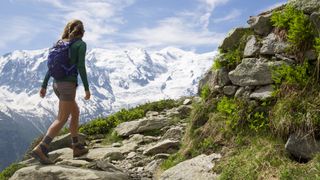
Do you have a pair of hiking boots that you’re itching to get out in the Alps? If so, you might be considering a long-distance trail like the Haute Route. While pretty much any town in the Alps makes a great base for day hikes , spending several days or even weeks trekking across some of the most dazzling mountain scenery in the world makes for a memorable adventure indeed. The Haute Route might not be the most famous long-distance trail in the Alps (that’s the Tour du Mont Blanc ), or even the longest (that goes to the 5,000 km Via Alpina), but it’s worth looking into if you want to get some quality time in with your trekking poles this year.
What is the Haute Route?
Simply put, the Haute Route is one of the world’s great long-distance hiking paths. Its name means “the high route” which is what it was branded when it was first chartered as a summer mountaineering route by members of the Alpine Club in the mid-19th century. It was given its French translation in 1911 when it was first explored as a ski touring route, and today this is its common name.
Linking the great mountains of Mont Blanc and the Matterhorn , hikers enjoy quintessential alpine scenery on this trail, which connects the ski resort towns of Chamonix in France and Zermatt in Switzerland.
These days, in addition to the original route, there is a lower elevation “walkers route” which remains below 9,800 feet (3,000 meters) while the ski touring route is higher, involving some glacier hiking and requiring gear like crampons and ice axes . There are various offshoots along the way and depending on the route you take, the trail varies in length but if you stick to the walker’s route the entire way, you’ll cover a whopping 132 miles (212 km).

Is The Haute Route hard?
What makes a hiking trail hard always depends on the hiker in question, but certainly for a lot of us, the sheer mileage of this route alone would be enough for us to classify it as challenging, even if just tackled in hiking boots in the middle of summer.
Distance aside, however, it’s the elevation gain of this route that stands out as presenting real difficulty. If you take the classic walker’s route, your total elevation gain is around 49,800 feet, which is almost as much as climbing Everest twice. Though you won’t reach such high elevations as the world’s tallest peak, you’ll still reach areas that are considered high altitude , so altitude sickness could be a concern.
The path itself is reasonably clear and free of mud, but there are sections of loose rock and singletrack that pose their own challenges. In general, hiking in the Alps is hard work and needless to say, you’ll want to get in shape to tackle this hike, and not the other way around.
Advnture Newsletter
All the latest inspiration, tips and guides to help you plan your next Advnture!
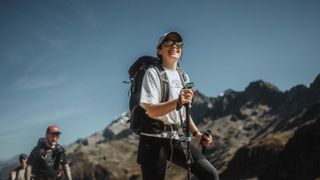
What is the difference between the Tour du Mont Blanc and the Haute Route?
Whereas the Haute Route takes hikers and skiers from one mountain (and country) to another, the Tour du Mont Blanc is a trail that circles Mont Blanc, the highest peak in the Alps, passing through four countries along the way. The TMB is shorter than the Haute Route at 106 miles and requires only 32,940 feet of elevation gain in that time, and is most famous for being the trail followed by runners in the UTMB , the world’s most famous ultra trail race.
However, those differences in distance and elevation gain aside, the two trails have plenty in common when it comes to terrain and scenery, and walkers on either route can expect spectacular alpine scenery and welcoming huts where you can spend the night and enjoy some delicious fondue.
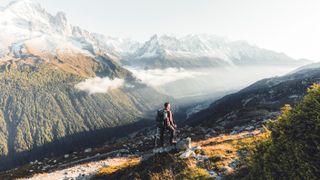
How long does it take to do the Haute Route?
How much time you need to book off work to do the Haute Route of course depends on which route you’re taking, whether you’re hiking, running or skiing, and what pace you move at. However, most guiding companies lead treks that last between 10 and 14 days, with shorter options that don’t take in the entire route available. Hiking for 14 days might sound like a long time, but that breaks down to an average of about nine miles per day, which is quite manageable for a lot of keen walkers. Also, you can hike the Haute Route self-guided and pick your own pace.
When should I walk the Haute Route?
Because of its higher elevation, summer is undeniably the best time to approach the Haute Route if you want to do so without needing crampons, and even then, you may encounter snow. July is probably the ideal month if you want to see wildflowers and to be able to walk in hiking shorts and a T-shirt, but always pack a fleece or down jacket , a waterproof jacket , hiking pants , hat and gloves for those chilly overnights. In general, the Haute Route is not as busy as the ever-popular TMB, though there are sections where it intersects with that trail and other trails where it may be busy.

Can you wild camp on the Haute Route?
Because the trail is so long, passing through two countries and many municipalities, it’s not easy to give a blanket statement about what is allowed and forbidden. In general though, wild camping ( dispersed camping in the US) is prohibited on private land in France and discouraged in Switzerland except above treeline , and there are definitely areas where you could be in a nature preserve or National Park and wild camping isn’t allowed.
There may be some quieter areas at high elevation where you can pitch a backpacking tent or bivy for the night without getting in trouble, but technically you could be breaking the law and be subject to a fine if you get caught. It all depends on where you are.
That said, hut hiking is truly one of the best and most special aspects of hiking in the Alps, and while it certainly makes for a more expensive approach, you won’t regret the decision when you walk into a beautiful hut after a long day on your feet and have a warm shower, a hearty meal, some great wine and get to sleep in a real bed (just bring your sleeping bag liner ).
To help keep costs down, there are also official campgrounds so you can create an itinerary that involves some huts, some nights in tents and perhaps the occasional night of wild camping. Whatever you decide, make sure you do your research ahead of time and book your accommodation, as lodging can fill up leaving few other options.
- Find refuge in a mountain hut during fall hiking season in the French Alps

Julia Clarke is a staff writer for Advnture.com and the author of the book Restorative Yoga for Beginners . She loves to explore mountains on foot, bike, skis and belay and then recover on the the yoga mat. Julia graduated with a degree in journalism in 2004 and spent eight years working as a radio presenter in Kansas City, Vermont, Boston and New York City before discovering the joys of the Rocky Mountains. She then detoured west to Colorado and enjoyed 11 years teaching yoga in Vail before returning to her hometown of Glasgow, Scotland in 2020 to focus on family and writing.
The best campfire songs for families and groups: sure-fire hits for the campfire
The trail I planned to hike is closed – can I use it anyway?
4 issues barefoot shoes can’t help you with (and the easy exercises that can)
Most Popular
- 2 4 issues barefoot shoes can’t help you with (and the easy exercises that can)
- 3 The trail I planned to hike is closed – can I use it anyway?
- 4 3 strength moves every trail and ultra runner should try
- 5 [READY TO CHECK] Revolution Race Nordwand Pro review: well-designed hiking pants at a reasonable price
Picos-Guides
Picos-berge.

- +49-(0)1525.8772777
- +49-(0)173.5858091
- [email protected]
Previous Trip
Austrian Haute Route Skitour
The ambitious counterpart of the haute route traversing the tyrolean alps. even more challenging than the original., group size:, difficulty:, accomodation:.
simple: Hut / bunks
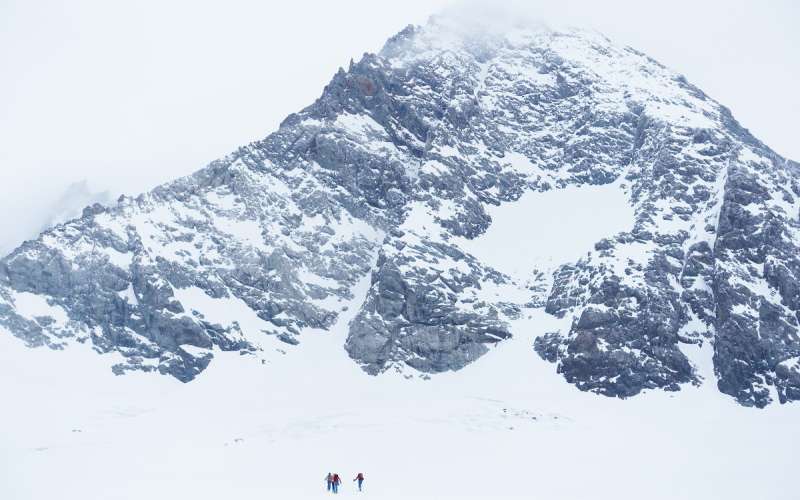
To put it right from the start: the "Skiroute Hochtirol" as locals call the Tyrolean Haute Route, is not a dull copy of the Haute Route Chamonix Zermatt. It's a proper challenge for ski mountaineers that even surpasses the original in terms of physical demands and adventure factor.
This superb hut-to-hut ski traverse travels the beautiful and unspoiled mountain landscapes of the Hohe Tauern, a mountain range located in Tyrol . It starts in the south Tyrolean valley of Ahrntal and culminates in climbing Grossglockner (3798 m ) highest peak in Austria and a sought-after trophy for ski mountaineers.
The itinerary is characterized by consecutive long days up to 2000 vertical meters of uphill, long descents in complete solitude and well-equipped Tyrolean style mountain huts.
Along the way you will climb beautiful ski summits like Großvenediger (3664m), tons of isolated cols and be marvelled by a permanently changing scenery.
If you have done extensive skitouring in the Alps, the Tyrolean Haute Route might still be a stunning ski adventure for you.
Individual dates for groups from 2 to 4 skiers.
Day 0 : Pre-trip meeting with your guide in a Hotel in Brixen-Bressanone at 7 pm. The nearest Airports are Innsbruck, and Munich with frequent train connections to Bressanone. Kit check and briefing on trip itinerary and avalanche conditions.
Day 1 : Early morning taxi ride to Kasern in Valle Aurina — the skitouring adventure starts. Long scenic ascend to a first col, Hinteres Umbaltörl (2845 m). Brilliant east facing slopes lead down to Umbalkees — we dive into the solitude of the Venediger Massif. Another uphill of 400 meters to the Reggentörl (3056 m) will give access to the steep north facing descent to the Essener Rostocker Hut, a well staffed and friendly skitouring center. Vertical ↑ 1650 ↓ 1100 m
Day 2 : Via a beautiful valley and wide mid angled slopes we skin up to the pyramidal summit of Großer Geiger (3360 m). Stunning views on the majestic Großvenediger. We traverse over to the Maurertörl, ski brilliant north facing slopes which often hold good powder. Finally, an hour or so climb brings us to the charming Kürsinger Hut. Vertical ↑ 1600 ↓ 1300 m
Day 3 : Steady ascent over gentle glacial slopes to the summit of the Grossvenediger, premier ski peak in the area. The views are said to go as far as Venice. Now follows the first downhill highlight of the Tyrolean Haute Route. A long ski run of 2000 m to the quaint village of Innergschlöß. The night is spent in a hut like Hotel with traditional Tyrolean kitchen and showers. Vertical ↑ 1400 ↓ 2000 m
Day 4 : Crux section of the Tyrolean Haute Route. Long ascent on solitary ground to the Sillingkopf (2858 m). Solitude increases even more as we ski down into the cirque of Prägratenkees. We gain the Granatscharte (2945 m) and climb to the summit of the Stubacher Sonnblick (3088 m). The day is not over yet, though. We traverse over to Granatspitze and drop into the lonely Dorfer Valley via a steep ridgeline. After several hundred meters of superb cruising slopes we have to work our way out of the beautiful valley floor past old farm buildings and a narrw gorge with a tunnel. Overnight in a very friendly local B&B. Vertical ↑ 1900 ↓ 2000 m
Day 5 : Very early morning start to cover the first 900 meters from the parking to Ködnitzkees Glacier. The ascent of Grossglockner (3798 m) involves skinning, a via ferrata and an exposed summit ridge climbed with boot crampons. In good conditions we can take the skis up to 300 m below the summit. The ski run down is among the better ones and we might enjoy lots of long turns in spring snow. Taxi back to our Hotel in Bressanone, where you stay the night. Group departure the following day. Vertical ↑ 1900 ↓ 1900 m
Prerequisites
- excellent cardiovascular fitness: stamina for 6+ hours of ascent (up to 2000 meters vertical max and average 1600 meters per day) and 2000 meter ski descents
- good off-piste ski technique, controlled skiing in all types of snow, including crusts and slopes up to 35+ dg,
- solid ski mountaineering skills: kickturns, ascending with ski crampons, climbing 45 dg snow with piolet and boot crampons
- proficient use of avalanche safety equipment
- no pre-acclimatisation required
Getting There
The nearest Airports are Innsbruck or Munich. From there you have train connection to Bressanone. We are happy to assist in arranging your travelling.
Accommodation & Food
You will stay on typical alpine mountain huts. They have a big dining room and dormitories with usually 4–12 bunks. Sometimes the dormitories have up to 20 bunks. The sanitary conditions are basic with common toilets, washing rooms and only rare showers. On very high huts there is sometimes not even running water.
We typically have half board on the hut. A lean breakfast with bread, jam, butter and, depending on the region, cereals are served along with coffee or tea. Dinner consists of 3 to4 courses: starter (soup, pasta in Italy), sometimes salad, main course with some meat, desert. Vegetarian or other dietary requirements are accounted for.
You can order non-alcoholic drinks, beer and wine. Likewise, snacks and lunch can be purchased. On the higher huts there is no potable water and you will have to buy bottled water.
Please don't hesitate to contact us in case of questions.
Lightweight touring skis and -skins are most suitable. Avalanche safety equipment. Glacier travel kit.
- Organization and guiding by a IFMGA licensed Mountain Guide
- Rental gear: lacier travel and avalanche safety
- All guide's overnight expenses
- 5 x Night/Half board on mountain huts approx. 50 €/Night (alpine club members) + 2 x Night/Half board in a hotel 50 €/Night
- Lift ticket, Taxi transfer back to starting point for you and the guide 120 € pP.
- Lunch and drinks on the huts. (lunch for take away can be ordered the day before)
- personal insurance covering mountain rescue
Bitte beachte unsere Infos zu den Anforderungen im Infocenter !
Questions about this trip?
for this trip
Flexibility : joint risk of bad (weather) conditions..
Flexibility is our working method - not a slick marketing slogan. We budget 1-2 extra days in the planning of many of our trips to factor in adverse weather conditions. The days can for example be used to move the trip a day or two as to use the best weather window for the summit bid. Of course you only pay the actual guiding days. We'd rather achieve your goal than insist on doing a poor alternative.
Bivies, acyclic and unknown paths: off the beaten track.
The Alps are the Playground of Europe and Europe is densely populated. Some areas are frequented to a degree that is almost grotesque. Traffic jams, risky overtaking maneuvers and utter chaos on lifts and huts are common sight. Clearly the experience must be suffering. Clever planning can avoid this and the mountains can be experienced in a pristine way — even on big and renowned peaks. We have a long record of guiding some of the most prestigious summits using bivies and less known routes, or simply climbing acyclic. It has always paid off! Does this sound appealing to you? Let's discuss your next true adventure in the mountains!
Personal communication rather than follower and likes.
Lets face it: social media is a mere marketing tool for many businesses. To us this way of connecting with the audience is somewhat superficial. That's not our style. We prefer the direct contact to our clients - even beyond 'business'. What does that mean for you? If you are planning a trip to the mountains on your own, get in touch, we are happy to recommend on a summit, region or provide information on the conditions. You need advice on gear? Need a second opinion on the avalanche situation? We are fostering a long term exchange, often on a very personal level, with many of our clients. We are taking the time, because its fun to chat or talk shop with like-minded people!
Additional Info
Want to know more?
- TV documentation with lots of atmosphere
The Tyrolean Haute Route - Quickfacts
- 9600 m vertical in 6 days.
- Scrambling Class III.
- Summits: Grosser Geiger, Großvenediger, Granatspitze, Romariswandkopf, Großglockner.
- Start in Kasern in italian Ahrntal.
- High alpine connection between Rudolfshütte and Stüdlhütte via Pasterze and Romariswandköpfe.
- Style matters: no taxi.
- Small team means highest safety
Related Trips
Those might be interesting for you as well, keywords / location:.
- skitraverse
- South Tyrol
Similar Outings
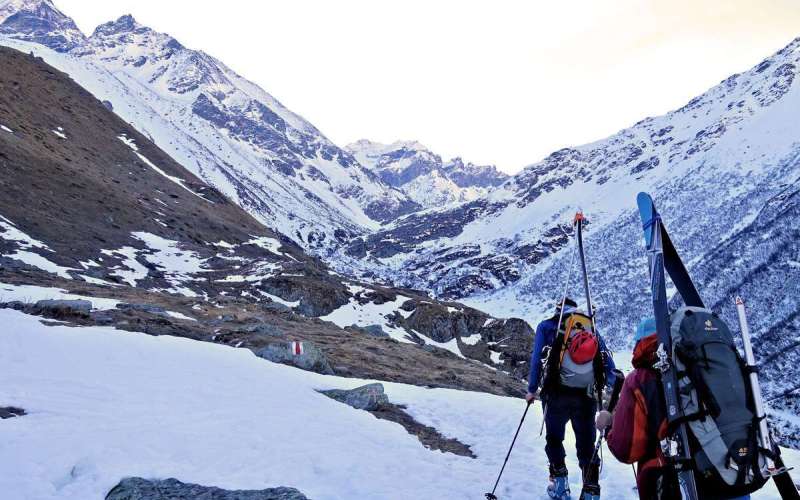
Purist Haute Route
Ski the Haute Route Chamonix-Zermatt Traverse off the beaten track and purely leg powered. A true ski adventure for purists.
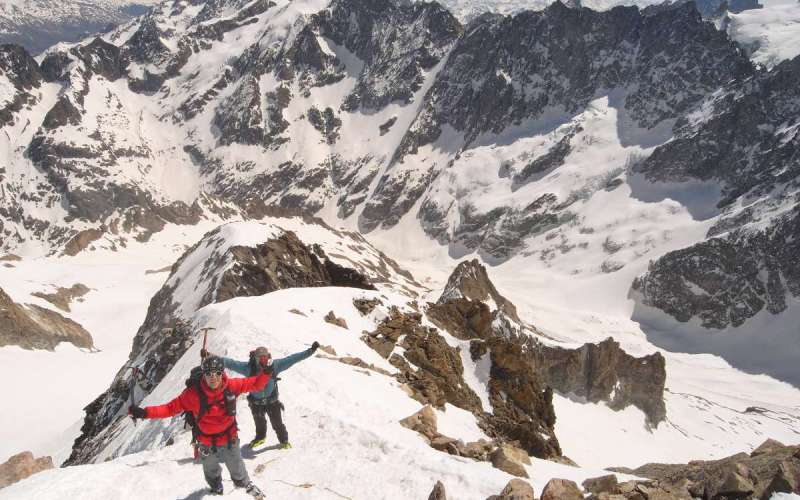
Ecrins Ski Mountaineering Traverse
One of the most challenging skitours in the Alps. 7 days traverse of the Ecrins Massif aka the Karakorum of the Alps
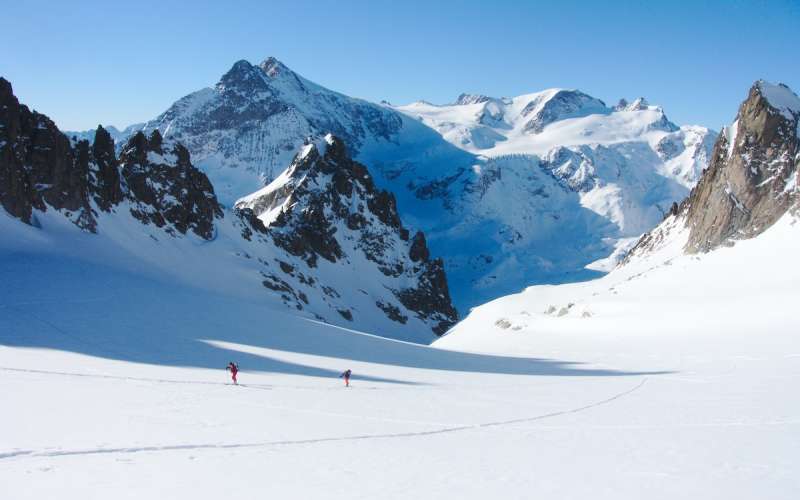
Skiers Haute Route
The Skiers Haute Route from Andermatt to Engelberg is the ultimate Haute Route for those who like long and steep powder runs.

- Guided Ski Trips
- Guided Climbing Expeditions
Haute Route-The Original Tour that started it all
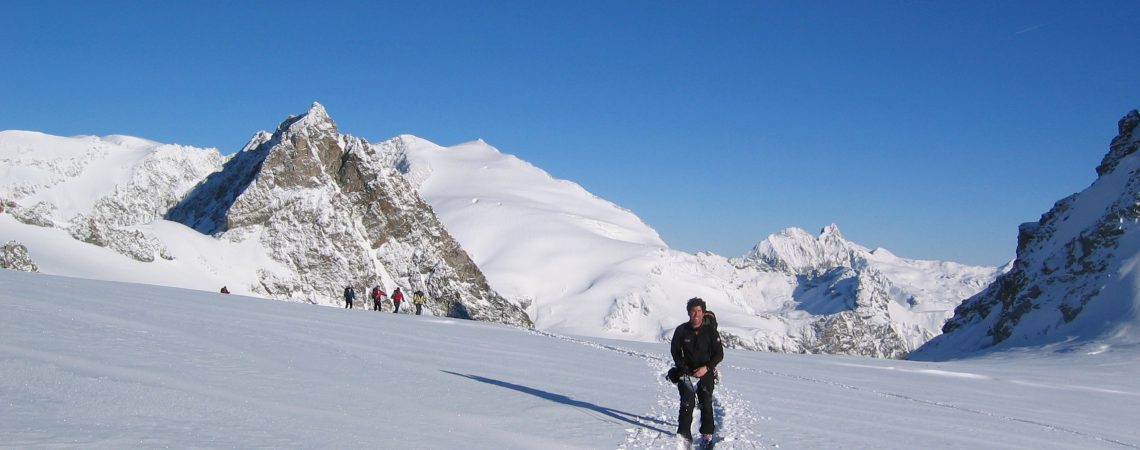
- Dates: 2024 – CUSTOM
- Duration: 7 Days
- Level: Intermediate
- Client Ratio: 5:1
- – $3150
- Included: group climbing equipment, and guide services.
- Not Included: All meals while on the mountain, airfare, transportation within Seattle, ground transportation hotel accommodations, restaurant meals, gratuities for guides, and all personal items.
Book Online Now!
The Haute Route is a classic tour through the heart of the Western Alps and some of its most stunning scenery. First completed in 1860, this high-level mountain traverse covers over 75 miles of alpine terrain, crosses over 12 different glacier systems, and connects the two major mountain centers − Chamonix, France and Zermatt, Switzerland. This route is perhaps the most famous ski tour in the world. There are few places in the world where skiers can travel unencumbered, in the heart of the mountains, over high cols, hidden valleys, and immense glaciers. The huts in the Alps allow us to enjoy the skiing as only traveling light can. You’ll witness an amazing mixture of cultures while staying in these huts as you socialize with ski mountaineers from around world who are also taking on the challenge of the Haute Route.
The Haute Route is a tour for skiers with advanced skills who are able to ski in variable snow conditions. Skiers should be able to ski “off piste” in all types of ungroomed snow. Also, for our climbs skiers should be able to execute uphill kick-turns without difficulty. This is a challenging tour which requires skiers to be in excellent shape not just for the downhill skiing but also for the uphill sections. A basic knowledge of general mountaineering techniques is helpful. We will meet in Chamonix on the afternoon or evening before the tour begins to answer questions, begin packing and finalize other logistics.
- EQUIPMENT LIST
FREQUENTLY ASKED QUESTIONS
Day 1 Depart from home.
Day 2 Hotel Gustavia, Chamonix – Check in to your hotel and get organized for tomorrow’s departure. Chamonix is a beautiful quaint French town with many great shops and restaurants.
Day 3 Vallée Blanche ski descent.– Meet in Chamonix. Discuss route plan and review equipment. Ride Aiguille du Midi and ski the Vallee Blanche where we have the opportunity for practicing skills on glacier. Night in Chamonix B, D
Day 4 Trient Hut – Today we ride the tram at the Grand Montet and cross the Argentiere Glacier to reach the Col du Chardonnet.. We cross the Fenetre de Saleina then continue to the Trient Hut (10,370ft.,3170m). B, D
Day 5 Champex – Cross Col des Ecandies (9,145 ft., 2796m), descend to the Val d’Arpette to the quaint village of Champex situated by a pristine alpine lake. We will take a short break from the alpine environment and bus to Bourg St. Pierre. We spend the night in Bourg St. Pierre and enjoy the comforts of the Swiss village. B
Day 6 Valsorey Hut – Today we will hike under the Grand Combin (14,115ft., 4314m) and climb over 4,000 feet to reach the Valsorey Hut (8,050ft.,2462m) B, D
Day 7 Chanrion Hut – Today we will climb over the Plateau du Couloir, the Col du Sonadon and ski down the Durrand glacier to reach the Chanrion Hut (8,050ft.,2462m) B, D
Day 8 Vignettes Hut – Traverse high above the village of Arolla to the Vignettes Hut (10,340ft.,3160m). From the hut there is beautiful view back down the glacier with snow covered mountains in the distance. B, D
Day 9 Zermatt– Today we will descend slightly before climbing over the Col de‘Eveque (11,095ft.,3392m).We descend and cross the Glacier to cross Col du Mt. Brulé (10,510ft.,3213m) to the Col du Valpaline then enjoy the 2400 meter descent down the Stockji glacier under the Matterhorn and into Zermatt B, D
Our recommended clothing system has four layers.
- Base layer: manages moisture and wicks perspiration away from your skin. (Polypro, capilene, driclime)
- Softshell: should be a durable, comfortable, insulating and wind/water resistant layer that breathes well.
- Hard shell: windproof, waterproof and breathable. (e.g. Gore-Tex, or similar)
- Insulating layer: should be down-fill or synthetic-fill and fit over all layers. (e.g. down, primaloft or polarguard)
These four layers are usually sufficient for most people, but if you tend to be colder bring one extra medium-layer that would be ideal for extra warmth around camp, such as a vest. When deciding what to pack, remember to bring enough clothes and accessories to ensure your safety and comfort, while not over-burdening yourself with items you probably won’t use.
Climbing/Ski Gear
- Skis or snowboard. Skis should be equipped with alpine touring bindings or telemark bindings. We prefer split decision Snowboards w/ skins because you do not need snow shoes.
- Adjustable Ski Poles
- Alpine touring, telemark, snowboard boots crampon compatible
- Ski Crampons Required for all ski mountaineering trips
- Alpine climbing harness Must have adjustable leg loops and fit over all clothing and can be put on with ski boots
- 2 Locking carabiners Large, pear-shaped carabiner is best.
- 2 Regular carabiners lightweight
- 1 Single Length Runner/Sling
- Ice axe Lightweight
- Crampons with anti-ball plate Must be fit to boots prior to trip,
- Climbing/ski helmet Adjustable, should fit with hat on
- 1 synthetic T-shirt
- 1 long sleeve Sun Hoodie or shirt Lightweight, light colored for sunny days
- 2 synthetic sports bras*(WOMEN)
- 1 soft shell jacket
- 1 Down/synthetic jacket with hood
- 1 Hard shell jacket with hood Waterproof and breathable. Gore-Tex or equivalent is best, roomy enough to fit over multiple layers.
- 1 pair lightweight gloves
- 1 pair warm waterproof gloves
- Warm hat Wool or synthetic
- Balaclava/Buff
- Shade hat or Visor
- 2 pair med- heavy wool/synthetic socks Check boot fit with liner and wool socks on
- 1 pair lightweight long underwear
- 1-2 pairs of underwear boxers/briefs
- Softshell pants
- Shell pants Waterproof/breathable with full side zips
Hut & In Town clothing for travel and evening
- Comfortable clothes for travel, walking around town and hotsprings for huts
- lightweight booties or slippers, comfortable top and bottom-cotton optional. for huts
Sleeping Gear
- Sleeping sac for huts
- Internal frame pack 2000-2500 cubic inch capacity able to carry snowboard/skis
Miscellaneous Equipment
- Goggles and Glacier glasses 100% UV protection with side shields or wrap around.
- Personal first aid repair kit Basics: moleskin/blister kit, Band-Aids, first-aid tape, ibuprofen, personal medications, spare parts for bindings and batteries etc.
- Lip balm At least SPF 20
- Sunscreen At least SPF 40
- Headlamp lightweight LED
- 2 water bottles 1 liter wide-mouth Nalgene and 1 bottle holster, or
- Hydration bladder With drinking tube and 1 Nalgene bottle
- Toiletry kit Be sure to include WAG Bag or toilet paper stored in a plastic bag.
- 1 small stainless steel thermos ( Optional)
- Favorite snack foods (no more than 2 pounds)
WILL MY GUIDE (OR GUIDES) BE? You will receive an introductory email with the guide for your course. Pablo Puruncajas and Ian Nicholson lead all our Alps trips and will be one of the led guides. We are small company who enjoy working together in the mountains as well as highly skilled professionals who hold current Wilderness First Responder certification and are proficient in technical rescue and evacuation skills. Our guides are dedicated to the world of alpinism, many having first ascents and hold professional certifications with AIARE & AMGA. The AMGA is part of the IFMGA, which is the international body of certified mountain guides.
HOW MUCH SHOULD I TIP MY GUIDES? Tipping is considered standard practice in the guiding industry. Tipping amounts vary – so $15-20 per day per person/per guide is average that works well for the guides without a serious blow to your wallet. Often 10% of the course cost is a good rule-of-thumb. If you feel that the program was exceptional or substandard the tip can reflect that.
CAN I RENT EQUIPMENT FROM BCAG? Yes, we rent Beacons, Shovels, Probes and Packs here . If you need these plus touring equipment, Second Ascent rents avalanche safety equipment, alpine touring, tele and split boards click here . Quantities are limited so please contact us as soon as possible if you are interested.
HOW HEAVY WILL MY PACK BE? You will carry 10-15 pounds, which will include everything on the equipment list.
WHEN DO I NEED TO PAY THE BALANCE OF MY TRIP? Payable when you make your reservation by check, or credit card.
WHAT HAPPENS IF I NEED TO CANCEL MY TRIP? If you should decide to cancel your trip, BCAG must be notified in writing. Your trip will be cancelled from the date we receive written notice. You will be assessed a cancellation fee according to the following schedule: 90 to 22 days from trip departure – 50% of trip cost 30 days or less – 100% of trip cost
WHAT HAPPENS IF I WANT TO CHANGE THE DATES OF MY TRIP? Schedule changes are subject to a $50 fee per person up to 2 weeks out and $100 less then 14 days from the start of the trip and may not be possible. If conditions or circumstances preclude running a scheduled program we reserve the right to make the decision as to whether the program will be canceled, rescheduled, or an alternative provided.
WHAT HAPPENS IF BC ADVENTURE GUIDES HAS TO CANCEL MY TRIP? In the rare circumstance where we need to cancel a program you can reschedule without a fee or receive a refund on your deposit. If circumstances arise that force us to cancel a program that is already in progress we reserve the right to decide whether a refund or credit, at a prorated rate, will be issued. We are not responsible for cancellation fees or costs arising from your changed or cancelled flights, lodging, or other arrangements. We strongly recommend obtaining trip cancellation insurance from your travel agent.
DO I NEED TO PURCHASE TRIP INSURANCE? BCAG highly encourages the purchasing of trip cancellation and travel insurance on domestic trips and requires it on International trips. Europeans and Canadians use it because travel insurance provides coverage for trip cancellation and interruption, travel delays, loss of baggage and travel documents, baggage delays, medical expenses and emergency assistance. Several options include Travelex or Travel Guard International at (1-877-248-8992) & www.travelguard.com for protecting your investment, however there are many companies to choose from and you may wish to do some individual research regarding which policy is right for you.
Recent Projects
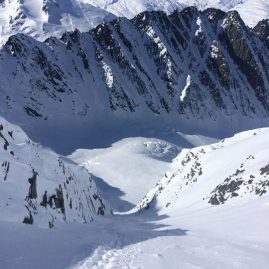
Valdez-the Steep and Deep Tour
Northwest Tours, Schools, Ski, Ski Courses, Ski Courses
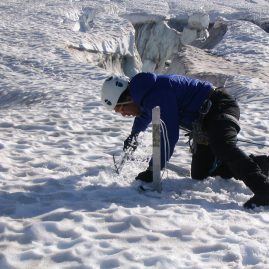
Intro to Mountain Climbing-The Weekend Edition
Alpine Courses, Climb, Northwest Climbs, Rock Courses, Schools
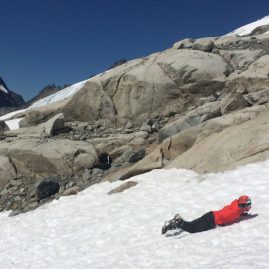
Intro to Mountain Climbing-Alpinism 101
Alpine Courses, Climb, Schools
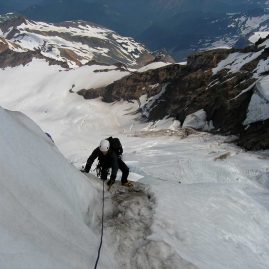
Alpinism 102 – Ice Climbing Course Alpine Style
Alpine Courses, Schools
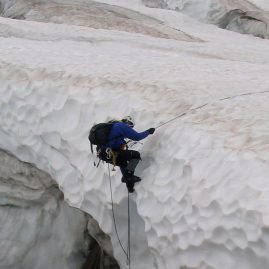
Crevasse Rescue Glacial Travel Seminar 1 Day
Alpine Courses, Climb, Schools, Ski, Ski Courses, Ski Courses
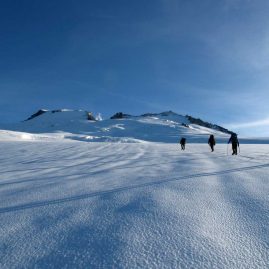
Mount Baker
Alpine Courses, Climb, Northwest Climbs
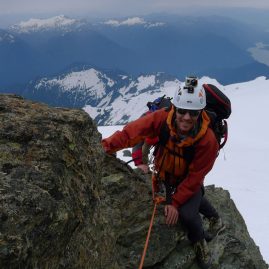
Mt Shuksan Summit Climb
Climb, Northwest Climbs
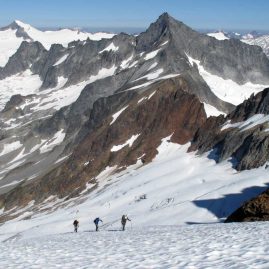
Forbidden Peak – Alpine Climbing Mecca
Domestic Ski Tours
International ski tours, ski courses, rock climbs, alpine rock climbs, rock climbing courses, domestic alpine climbs, international alpine climbs, alpine climbing courses, aiare avalanche courses, aiare rescue courses, avalanche awareness courses.
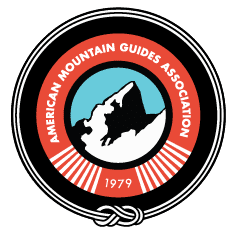
Snoqualmie Haute Route Ski Tour
The Snoqualmie Haute Route was pioneered by Martin Volken in 2000. It is a multi-day alpine traverse through the big mountain terrain from Alpental to Mount Hinman and beyond. This committing, rugged, and absolutely incredible traverse has brought new meaning to Snoqualmie Pass ski touring.

Trip Information
Back in 2000 we pioneered this committing, long, alpine multi-day traverse that will bring new meaning to Snoqualmie Pass ski touring. We will take five full days and four nights to complete this 40-mile tour that has approximately 20,000 feet of elevation gain. The tour starts from the end of the Middle Fork road or Snoqualmie Pass, weaves up to the north of the pass through the Chimney Rock and Lemah areas, and ends in the Commonwealth Basin at Snoqualmie Pass. We will have the option to summit Big Snow Mountain, Mount Hinman, Chikamin Peak and Alaska Mountain.
Overall Difficulty Level: Very difficult
Skills Required: Advanced skiing ability and prior ski touring experience
Fitness Level: Very strenuous due to ski touring with big overnight packs
Private Trips Available
Day 1 : We will meet in front of the guiding office in North Bend at 6am, conduct a gear check and then drive up the Middle Fork Road. We should be able to drive to at least near the road head at about 3000 feet. From there we will hike and then ski up the Hardscrabble drainage and the summit of Big Snow Mountain (6680feet). We will camp at the saddle north of Big Snow Mountain. Day 2 : Essentially we will follow the crest north of the Middle Fork Valley to the Chain Lakes area, drop some gear, and summit Mount Hinman at over 7000 feet and then ski back to our camp near Williams Lake; Another big day. Day 3 : Our third day will send us up the hidden Summit Chief Valley, over the Summit Chief Col at 6140 feet. Then we ski all the way down to the head of the Lemah drainage at around 4600 feet and back up underneath the massive East Face of Chimney Rock to the Overcoat Col at 6800 feet. Day 4 : The descent into the Burnt Boot drainage first thing in the morning will wake anybody up. It is wild and very scenic. From Iceberg Lake at around 4800 feet we will tour up underneath the West Walls of the Lemahs all the way up to Chikamin Ridge at nearly 7000 feet. A short scramble should bring us to the summit of Chikamin Peak. We have to make it there on time, so that we can ski the following descent down the South Face of Chikamin Peak in good conditions. A short traverse around Huckleberry Mountain will get us to our last camp at Joe Lake (4624 feet). Day 5 : From camp we will tour south along the PCT past the Kendall Catwalk into the Commonwealth drainage and out to Alpental. We will get picked up there, go to North Bend and party.
Private Trips
Equipment list.
- 1 Bottom - midweight or lightweight
- 1 or 2 Tops - midweight or lightweight
- Ski Socks - 2 pair
- Windshirt or light Soft Shell jacket
- Fleece or similar warm layer
- Soft-shell pants
- Lightweight Waterproof/Breathable Jacket
- Lightweight Waterproof/Breathable Pants
- Warm Hat - should cover your ears
- Sun Hat - baseball cap or visor
- Lightweight Gloves
- Ski Gloves/Mittens
- Down or Synthetic Puffy-type Jacket
- Everything must fit inside except ice axe, crampons, helmet, and pad
- If approach shoes are worn, ski boots may be on outside of pack as well
- Sleeping Bag - down or synthetic, 15-20º F or warmer
- Compression Sack - for sleeping bag
- Sleeping Pad - closed cell foam or self inflating (or both)
- Headlamp - lightweight LED recommended
- 2 Water Bottles - liter bottles, wide mouth recommended
- Bowl and Cup - bowl is optional if eating from freeze-dried meal bags
- Spoon, Fork, or Spork
- Small Knife
- Sunglasses - adequate for snow travel
- Sunscreen - SPF 25+, waterproof
- Lip Balm - SPF 15+
- Personal Toiletries - keep it simple: toothbrush, tiny toothpaste, hand sanitizer
- Small Personal First Aid Kit - just the basics: blister care, ibuprofin, prescription meds, etc.; your guides will have a substantial group first aid kit
- Toilet Paper (blue bags provided by PGS)
Snow Travel Equipment
- Skis - Alpine Touring or Telemark (or Splitboard)
- Ski Boots - Alpine Touring or Telemark - no downhill boots (or Snowboard Boots)
- Poles - Telescopic poles work well, but not required, with snow baskets
- Climbing Skins
- Ski or Splitboard Crampons - REQUIRED! - Ensure that they are compatible with your bindings
- Ski Brakes or leashes
Safety Gear
- Avalanche Transceiver
- Shovel - compact, lightweight, metal blade preferred
- Probe - dedicated probe only, ski poles do not suffice
Technical Gear
- Ice Axe - lightweight, 45-70cm is fine
- Boot Crampons – Ensure they fit your boots
- Anti-ball plates for crampons
- Climbing Harness - lightweight, (no padding; ex: Petzl Altitude, Black Diamond Couloir)
- 2 Locking Carabiners - at least 1 large HMS style and 1 regular locker
- 2 Non-locking Carabiners - any style, we recommend wire gates
- 1 Single Length Dyneema/Dynex Runner/Sling (60cm/24in diameter loop)
- 1 Double Length Dyneema/Dynex Runner/Sling (120cm/48in diameter loop)
- 1 Cordelette - 6 mm cord, 6 meter length
- 1 Prussik Loop - 3-4 feet of 6mm cordelette tied in loop with double fisherman's knot and/or a Sterling Hollowblock
- Camera - we’d like some shots for the PGS website!
- Ear Plugs - essential for sound sleep
- Camp Booties
- Thermos - vacuum type
- Electrolytes - tablets/powder/gel/blocks
- Note Pad and Pencil - Rite-in-the-Rain brand waterproof notebooks work well
- Compass - adjustable declination a must
- Altimeter watch
- Map Case - large Ziploc bag works well
- Maps - contact guiding office for appropriate quadrangles
- Collapsible Water Canteen - good for storing snowmelt at camp
- Liner socks - if blister-prone
- Warm Socks - to sleep in
- Approach shoes--lightweight running shoes work well
- Foot Powder
- Neck gaiter - for protecting your face from sun, wind, cold
- Helmet - climbing or lightweight uninsulated ski helmet (recommended)
- Post-course care kit (to leave in car): cotton T-shirt, flip flops, favorite treats
Gearing Up Adventurers Since 1999
Well, yes it is. You should definitely be in excellent physical condition if you want to enjoy yourself.
Although tipping is not a requirement, it is considered standard practice in the guiding industry and is appreciated by our guides. We generally recommend roughly 10%-15% of your course or trip cost or a flat amount that you are comfortable with.
Why Book With Us?
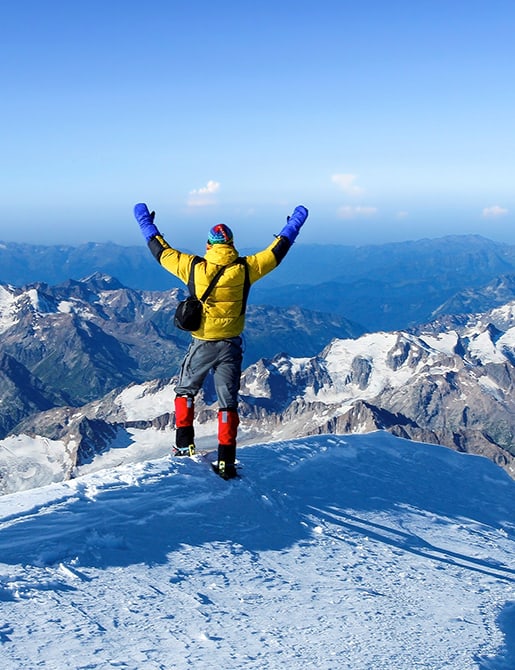
Plan Your Trip
Trip prep & tips, food suggestion list, difficulty ratings, books we've written, shop for gear, route pioneering, related adventures, isolation ski traverse, forbidden ski traverse, haute route ski tour, get the latest updates on mountaineering news & upcoming trips.
- Private Guiding
- Gift Certificates
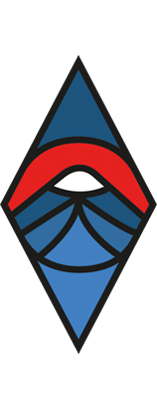
Niseko Haute Route
Hokkaido backcountry ski touring / niseko region.
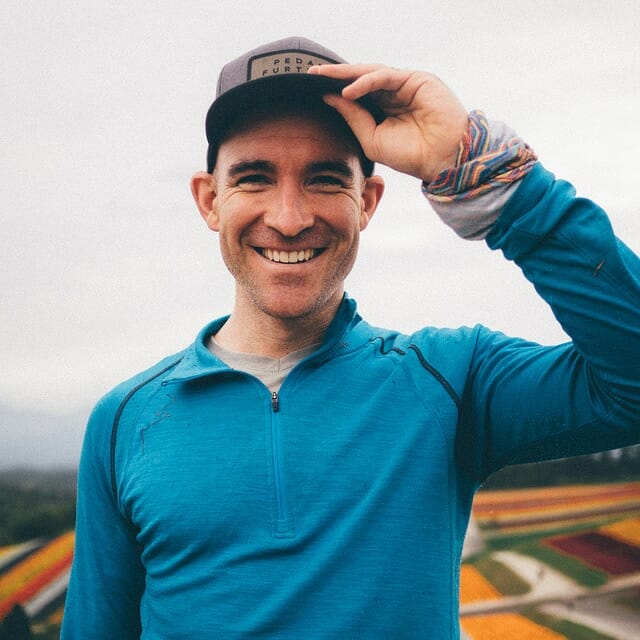
Highest point

Best season
TOPO DOWNLOAD (PDF, 37.6MB)
Download may take some time (high-res map)
We visited this route on Mar 25, 2022
The crew: Rob , Chris , Timbah and Ben
Last updated Nov 25, 2022
GPX route file download
Kml route file download, photo gallery, need to know details.
The Niseko Range is in the southwest of Hokkaido, about 2.5hrs (90km) drive west of Sapporo City. It stretches east to west, from the bustling ski resort town of Niseko to the Japan Sea coast. Skiers can start the traverse at either end of the range (see more details below).
The moniker Niseko “Haute Route” was borrowed by locals from the European version , but the concept is the same: a multi-day, high-level ski tour route up in the alpine, ticking off as many of the major peaks in the range as possible along the way. When visibility is good – as is often the case in spring – this is an incredibly inspiring route with plenty of variation. The descents off Niseko-Annupuri, Iwaonupuri, Nitonupuri, Chisenupuri, Mekunnai-dake, and Raiden-yama are also amazing. The final descent from Raiden-yama to the sea is a particularly unique experience that caps off an amazing volcanic traverse.
- Direction: Most skiers complete the traverse east to west. That is, from Niseko to the sea. This direction involves about 20% less climbing overall (and also means 20% more downhill). Symbolically, this direction has an aesthetic appeal. The escape from the madding crowds of the resort area, all the way to the wild ocean…
- Where to start: If starting in the east, most skiers start at the road-end car park near Goshiki Onsen on Route 58 . A ‘true’ traverse might start at the base of any of the four major ski resorts of Niseko , however hiker access is limited on the southeast side of Niseko Annupuri – consider taking one of the first lifts (8:30am) up and hiking to the Niseko Annupuri peak from there. The King Lift #4 in the Niseko Grand Hirafu ski area gives most direct access to the peak via Gate 3. Note, however, that backcountry gate openings are not guaranteed ( see the Niseko Rules here ), and the west face of Niseko-Annupuri can be horribly wind-affected and icy, particularly on early-spring mornings. If the purist in you must hike from the base of Niseko-Annupuri, then a ridge-line hike to the west of Osawa Bowl starting from just east of the Niseko Moiwa Ski Area Center Lodge ( around here ) might be feasible, however make sure to start well before 8:30am, as the Osawa Bowl and Back Bowl sees a huge number of sidecountry skiers descending from first lifts ( see Moiwa Ski Area map here , and topomaps here).
- Where to end: The Japan Sea coast side of Raiden-yama is a labyrinth of rugged cliffs, high narrow spurs, wind-stripped ridgelines, and deep, tightly wooded gullies. As such, there’s no pleasant way to finish close to Cape Raiden-misaki 雷電岬 ( location ), which would, arguably, be the purist’s choice of route terminus. Therefore, most skiers opt to ski from the Raiden-yama summit due north towards Iwanai Town. Arguably the most aesthetic balance between access, skiing quality, and a true sea-side finish is to ski the ridge north from Maeraiden-yama past the 997m point, just west of Narukami Falls 鳴神の滝 ( location ), and northwards to the little abandoned fishing port at Shikishimanai 敷島内 ( location ). There’s a small parking area there and a bus stop (6 buses daily, see Transport Options below). That ridge offers very nice skiing, if not wind-packed for most of the season. Skiers tempted to ski down to the derelict Asahi Onsen 朝日温泉 ( location ) via Raiden-toge Pass 雷電峠 and on to the derelict Raiden Onsen 雷電温泉 ( location ) should expect a solid dose of adventure skiing – think steep, very narrow and tightly wooded spurs with questionable snow cover, heading into tightly wooded gullies and sketchy traverses. In theory, a descent from Raiden-yama west-southwest to the coast from Raiden-toge Pass to the coast at Rankoshi Town ( around here ) is also possible. However, the Rankoshi Side offers no services – the Iwanai side offers better public transport options back to Niseko, a good array of restaurant options, and even onsen.
- When to go: The Niseko Traverse can be completed at any time during the ski season, from December till April. Surface and weather conditions are best in spring (March till April) – expect fast hard-pack and/or corn and good weather windows of up to 72 hours/3 days. In deep winter (December till end of February), surface conditions are as deep as they get anywhere in the world, and weather windows of more than 12 hours are rare.
- Route timing: Spring – 10-20hrs (1-2 days) | In spring with firm surface conditions, fit skiers have been known to ski from Goshiki to the sea, hitting all peaks along the way (30km, 2000m+ ascent), in a single one-day push of under 11 hours ( see Bine Žalohar’s report here ). Winter – 3-4 days | In the mid-winter months, the traverse becomes a much more challenging ordeal – with shorter daylight hours, deep snow, and dramatically shorter alpine weather windows, expect up to three days or more, with relatively little opportunity to remain in the alpine for the duration of the traverse (see Aaron Jamieson’s late February report here and the Way East video here ).
- Peaks along the way: Niseko-Annupuri ニセコアンヌプリ (1308m), Iwaonupuri イワオヌプリ (1116m), Nitonupuri ニトヌプリ (1080m), Chisenupuri チセヌプリ (1134m), Shakunage-dake シャクナゲ岳 (1074m), Shirakaba-yama 白樺山 (954m), Maemekunnai-dake 前目国内岳 (980m), Mekunnai-dake 目国内岳 (1202m), Raiden-yama 雷電山 (1211m).
- Escape routes: The beauty of the Niseko Haute Route is the plethora of good escape routes along the way. If at any point you need to get out of the alpine or indeed to a public road, it’s relatively easy to do so within a couple of hours. We’ve marked the escape routes on the topomap, so take note of those during your planning phase.
- Camping/accommodation: Besides Goshiki Onsen at the start (or end) of the route, there are no huts, campsites, or facilities along the way. If making this an overnight or multi-day traverse, you’ll need to plan in advance feasible places to camp in consultation with the wind direction forecast. In general, plateaus and saddles in the alpine are very exposed to the elements. Skiers may wish to sacrifice some elevation gain to drop down below the treeline to dig in for the night. The Niimi Onsen ruins 新見温泉跡地 ( location ) make for a unique overnight halfway along the range – note that as of 2022 there was hot water still flowing, but all buildings have been removed (only foundations remain).
If starting from the resort side of Niseko-Annupuri, take a lift up to Gate 3 (Grand Hirafu ski area, King Lift #4) or Gate 2 (Annupuri ski area, Jumbo Pair Lift #4) ( trail map here ), and hike to the Niseko-Annupuri peak. Descend to Route 58.
If starting from the road-end on Route 58 just beyond Goshiki Onsen, park up at the large snow-cleared parking area just before the end of the snow-cleared road. Head up Iwaonupuri on the standard ascent route via the southern ridge to the looker’s left of the bowl. This is a fairly mellow ascent, and the summit is flat and quite featureless. Descend the same way. While it might tempting to descend the west side from the peak, this slope is steep, rocky, and has a number of bluffs.
Continue west towards Nitonupuri, via a picturesque rolling plateau. The climb up to the Nitonupuri summit is relatively short and straightforward. If snowpack conditions are stable, there’s a fine descent via the west face of Nitonupuri to the snowed-in Route 66. A more conservative descent would be via the broad ridge to the skier’s left (south) of the west face bowl.
For the ascent of Chisenupuri, we’ve marked on the topomap the most conservative, common route up to the peak, via the south face. If conditions allow it, connecting with the summer trail ridge would be the more direct, albeit slightly more exposed, ascent option. Descend Chisenupuri on the south or southwest aspect – the west aspect proper is often wind affected.
At around 890m on the flanks of Chisenupuri, head due northwest across the broad, featureless saddle towards Shakunage-dake. The Shakunage-dake peak is easily gained, and the descent north off the peak towards Shakunage-numa is very short-lived. Continue in a north-then-northwest arc, following a broad ridge-like feature towards Shirakaba-yama. The descent from the 1041m point north of Shakunage-numa is very mellow, but the vast plateau-like descent is fast and inspiring.
Make the long traversing ascent to the diminutive Shirakaba-yama. From here, skiers need to decide if they’ll push on in the alpine, or drop down to Niimi Onsen to camp. The descent to Niimi Onsen wipes off an additional 250m of vertical gain (when compared with just skiing to Niimi Pass), which needs to be made up for the next day. That said, the onsen hot water still flows freely at the onsen ruins (just foundations remain), so intrepid skiers may wish to indulge in the ultimate Hokkaido ski touring experience – wild onsen in the snow with a camp nearby. There’s also a spring in the vicinity of the ruins, at the north end of the large pond-like pool.
Regardless of whether you drop down to Niimi Onsen or not, you’ll cross another road – the snowed-in Route 268. This roughly marks the half-way point in the traverse. The ascent to the Mekunnai-dake summit is one of the more significant ascents in the traverse – it’s long and particularly exposed to the elements. Mekunnai-dake is an impressive volcanic dome with a very distinctive rocky summit .
From the Mekunnai-dake summit, it’s a hard-packed, rattly descent down to the Panmekunnai Moor, after which the final ascent of the traverse begins – the long, gradual approach to the rather anticlimactic featureless peak of Raiden-yama. If you’ve not experienced any strong wind on the traverse yet, you’ll most likely experience it here. Bitter northwesterlies blow uninhibited from the Japan Sea, slamming into Raiden-yama’s buttressed northwestern side.
The most practical descent to the sea takes the skier along the broad northern ridge from the summit, via Maeraiden-yama, skirting the 997m point, and down to the small hamlet of about five houses at Shikishimanai. This ridge offers some great skiing, with views of the sea the entire way down. At the terminus of the ridge is a steep bluff, but just above the bluff is the ruins of an old house. There’s a decaying access path to the house to the skier’s left of the house, which will lead you to the main highway. Head just 50m southwest along the highway, and you’ll come to the dilapidated Shikishimanai port. Surely it’s time for a celebratory swim!
You can either wait for one of the six buses that stop at the Shikishimanai bus stop, or walk the 5km northeast along the coast road to the Iwanai Bus Terminal 岩内バスターミナル ( location ).
Depending on the season, this route could take anywhere from 11 hours (in spring) to two to three days of around 8 hours each (in winter). There’s up to 2,500m of total ascent, with about 15 transitions required if hitting all peaks along the way.
The Niseko resort area is well serviced by public bus and rail from Sapporo City. See access details on the Niseko United website here. Access to Goshiki Onsen in the winter is by private car or taxi only. Expect to pay around 7,000yen for a taxi from central Hirafu to Goshiki Onsen. From the Raiden coast, there is a public bus service running buses six times daily to and from the Iwanai Bus Terminal. From Iwanai Bus Terminal, there is a direct bus back to the Niseko resort area via Kutchan Town. If you have to escape from the route part way through, your most practical option would be to call a taxi. Note that in Hokkaido there are no taxi callout fees, no matter how far.
There is plenty of parking at the large public snow cleared parking area at the Goshiki Gate on Route 58. There’s also plenty of parking at any of the ski areas around the southeast base of Niseko Annupuri. At the end of the route on the Raiden coast, there’s a small cleared parking area just before the entrance to the Narukami Tunnel 鳴神トンネル on Route 229 along the coast, just above the Shikishimanai Port ( location ).
NOTE: The official 1/25000 topo map(s) above can be purchased for 350yen from Kinokuniya bookstore next to Sapporo Station or online (in Japanese).
Snow and route safety
This route is heavily exposed to changing weather conditions. But, it also offers numerous ‘exit’ options to ski down to one of the snow-cleared road ends. Be sure to take a map so that you know where these escape routes are. Avalanche hazard is very manageable with good terrain selection options throughout the trip.
- See our tips for keeping safe while ski touring in Hokkaido here .
- Notify the police of your backcountry plans online using Compass – instructions here .
Niseko Haute Route Difficulty Rating
Strenuousness
Vertical Gain
Time ascending
Technicality
Weather forecast
Given this is a point-to-point tour you’ll have options at both the start and end of the trip. Goshiki Onsen 五色温泉 ( location , 800yen) is a must-visit at the eastern end of the range, as are any of the Niseko resort area onsen – our pick of the bunch is Ikoinoyuyado Iroha いこいの湯宿 いろは ( location , 800yen), hear the base of Annupuri ski area. In Iwanai there are two great onsen up the hill by the Iwanai ski area: San san no yu サンサンの湯 ( location , 500yen) and Okaerinasai onsen おかえりなさい ( location , 800yen) . Of course, during the traverse, there’s the ‘backcountry onsen’ experience at Nimii onsen.
- Bine Žalohar’s report and video here
- Aaron Jamieson’s report and video (plus one more report ).
Guide Options
If you’d like to ski this route and/or explore other Niseko areas together with a local certified guide, get in touch with Yasuko Kikuchi . Born and raised in Hokkaido, she’s a JMGA-certified guide now based in Sapporo. Her outdoor experience is broad and worldwide, having worked as a Canadian Ski Patrol member, and has sumitted a number of 6,000m+ peaks around the world. She speaks good English. In addition to Yasuko, also see a full list of English-speaking Hokkaido Mountain Guides Association (HMGA) guides on the HMGA website here .
About guide links on Hokkaido Wilds
We make an effort to support certified, English-speaking local guides on Hokkaido Wilds ( see a full list here ). They'll have the experience and skills to help make access to Hokkaido's most wild places possible.
Disclaimer: Booking a trip with a local guide through Explore-Share.com via Hokkaido Wilds earns us a commission. 100% of that goes into a fund to promote and sustain the Hokkaido outdoors. SEE MORE DETAILS HERE .
Like this content? Buy the HokkaidoWilds.org team a coffee . 50% of tips go to the Hokkaido Wilds Foundation .

Route Trip Notes
It had been 25 months since I’d been able to join a Hokkaido Wilds trip, but with borders finally opening and my business visa in hand for some meetings in Japan, I was able to tack some touring into the schedule. Our plan for the Niseko range traverse had come together slowly and then all at once. We’d been really focusing on the Niseko area for a forthcoming project and this was absolutely one that we needed to tick off. We penciled the weekend a few weeks out, started a group chat on Messenger for the logistics, and kept our eye on Windy.com for the weather.
A few days out we made the call to do a Friday-Saturday trip; day one was forecasting bluebird but with winds increasing on the Friday night from the [warm] South-West the second day would be more challenging. Getting to the campsite would be fine and then we’d need to make a call on the second day’s section based on conditions on the ground. We would start early on the Saturday morning to try and get-‘er-done before the forecast rain rolled in.
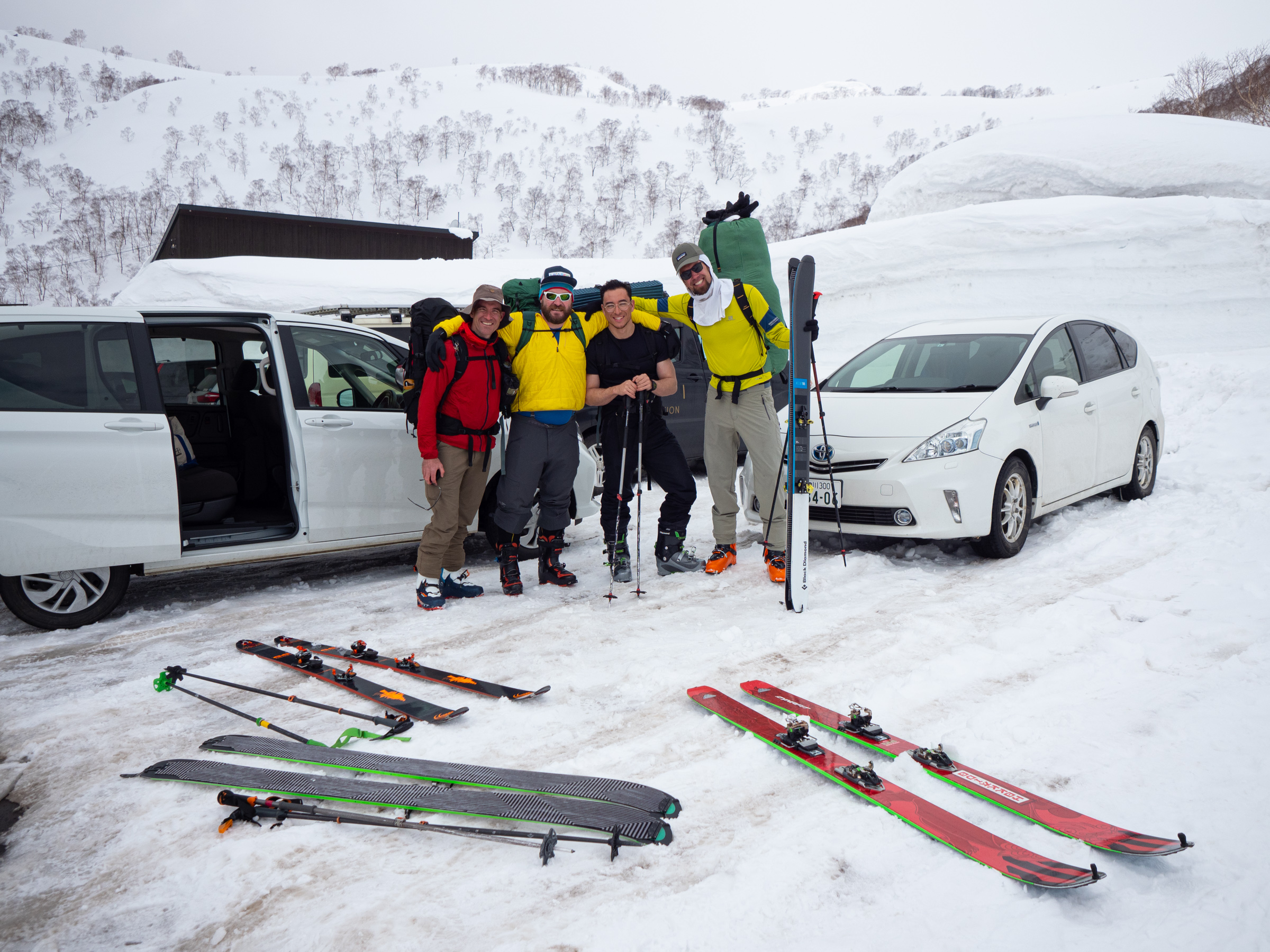
In the end we were a group of four. Myself and Rob were joined by Ben, who’s a Chisenupuri local, and Timbah, who’d driven down from central Hokkaido on the Friday morning. Strictly speaking the tour should start at Mt Niseko-An’nupuri [Rob: strictly speaking, walking up from the base!] but we decided to forgo the crap-shoot of the ski resort backcountry gates opening and instead started at Goshiki onsen.

Morning Zoom [Chris: Microsoft Teams!] calls notwithstanding, we managed to head off from the car park at about 09:45. We skipped the summit of Iwaonupuri and pushed on to ascend Nitonupuri. There’s a bunch of steep but short ski lines to be had in the terrain between the two peaks and I noted to Rob that they’d be worth a write up sometime, but we carried on, the group were all focused on making camp in plenty of time to ski down to Nimi onsen.
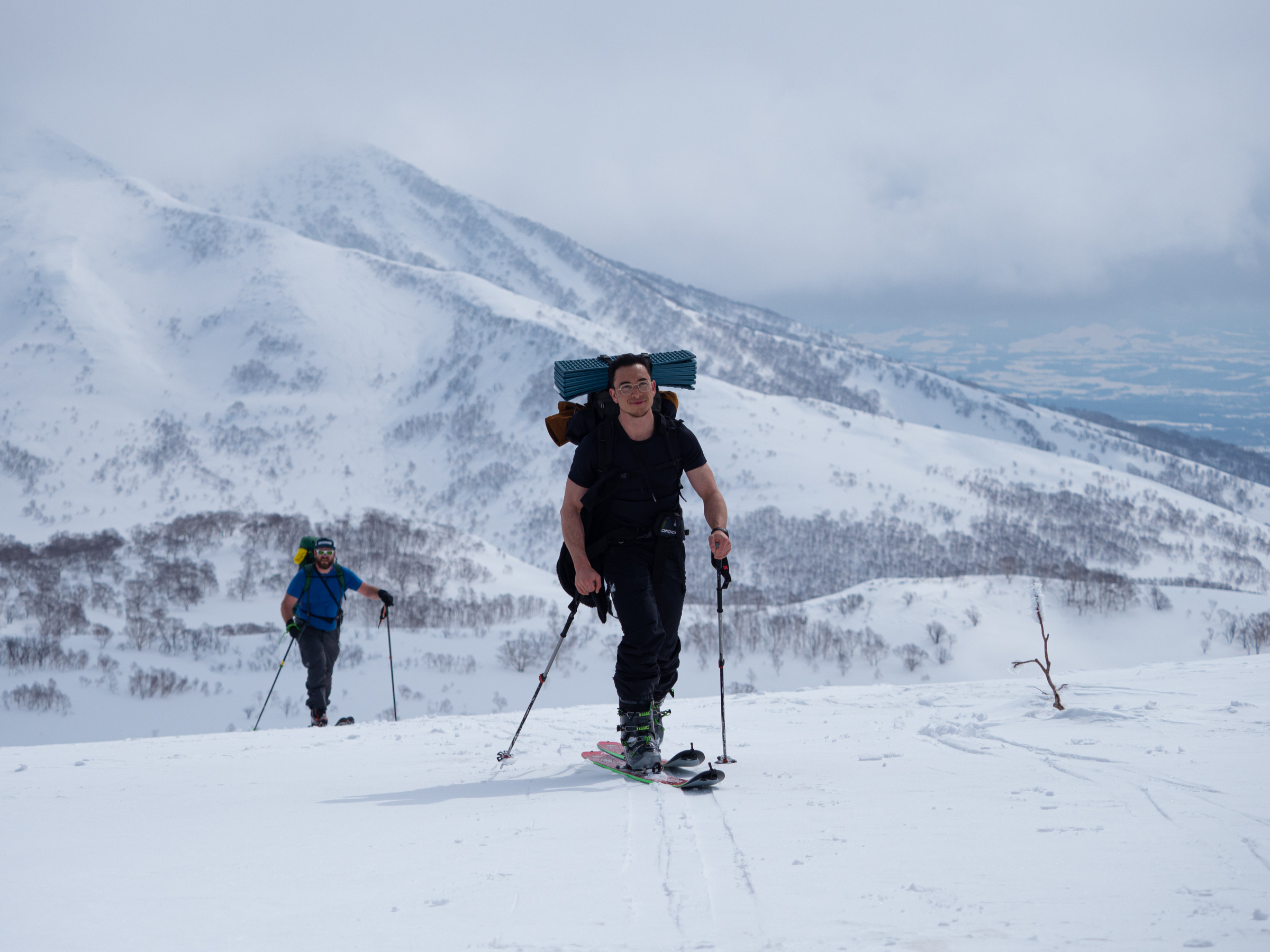
There’d been a solid 30cm of snow on Tuesday afternoon but even the relatively solar-sheltered NE slopes off Nitonupuri couldn’t withstand the warm ambient temperatures and it was a cream-cheesy descent down to route 66. Still, these were undoubtedly the best turns of the trip. Our full post on this zone is here . Once again, we skipped a full summit of Chisenupuri and instead contoured our way around the southern slopes; given our time again we’d probably have stayed a little lower to avoid the steeper slopes which made for slower going on edges rather than ski-bases.
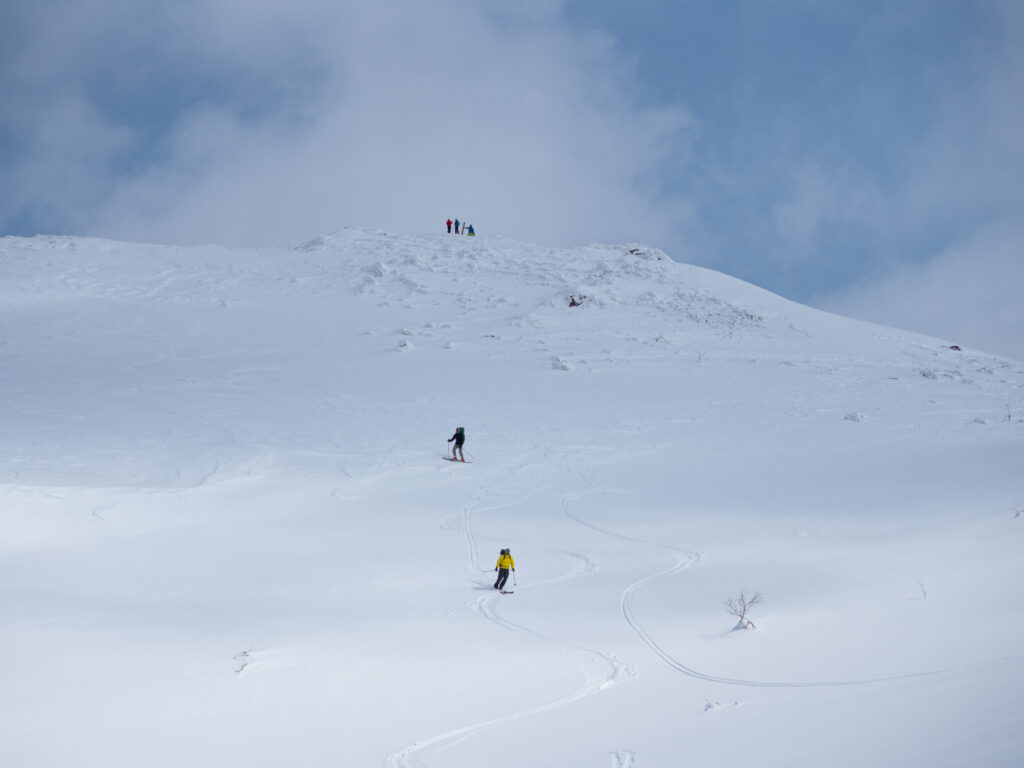
The rest of the first day into camp was broadly uneventful, but offered some inspiring vistas. Far more of a walk-than-a-ski as I am often want to say. We’d made good time and felt happy that we were able to drop down to the old Nimi onsen ruins to pitch camp for the night. It was sad to see Nimi onsen pulled down a few years back as in full Ryokan with dinner + onsen mode it would have made this traverse something special. But, we had high hopes for there to still be flowing hot water and so we skied down for a nosey.
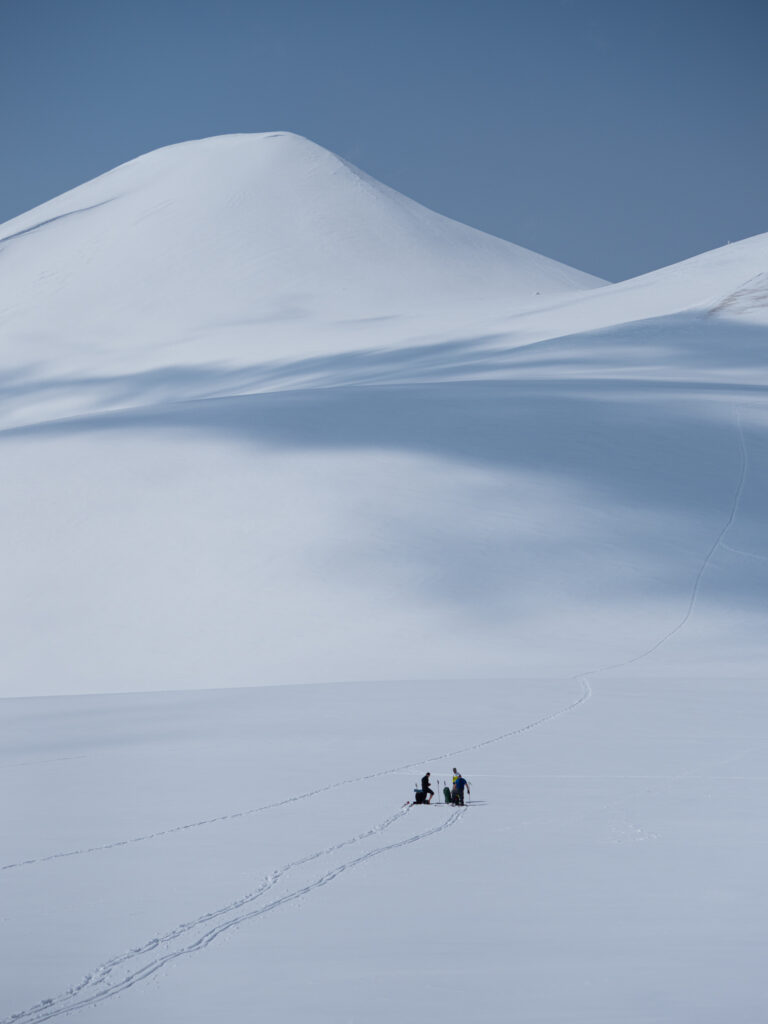
We were in luck… there was hot water… a lot of it…and it was damned hot too. The onsen facility closed in about 2016 and the buildings were fully removed a couple of years later. It’s a bit sad that such a great facility has gone but at least there’s still an opportunity to enjoy some of the warm water that still flows. The Good Hokkaido blog has some great photos of the Nimi onsen facilities before it was removed so you can dream of what once was. Your mileage may vary in terms of water flow and ability to build up a little pool, but, when we visited there was a very steady amount of very hot water.
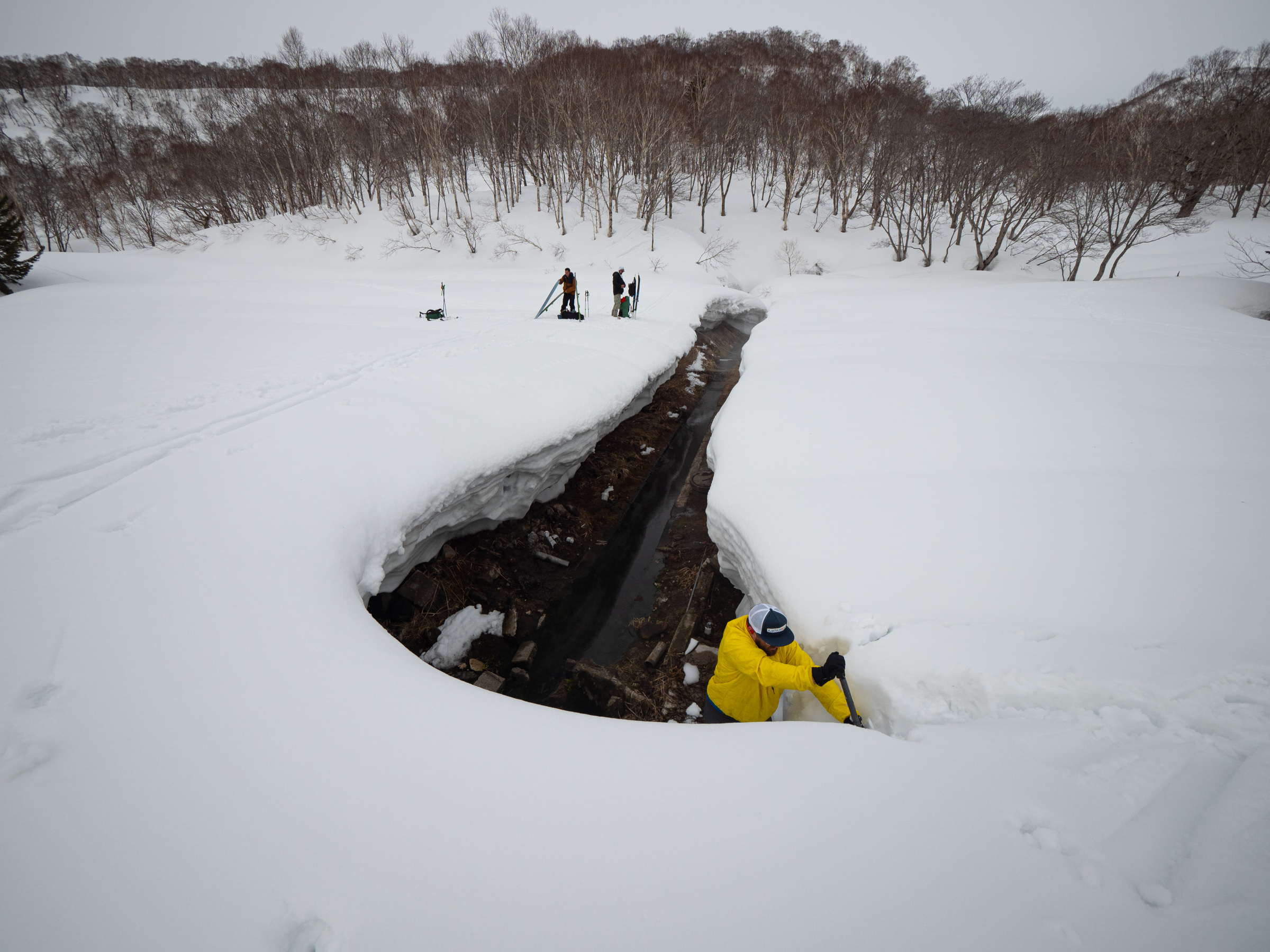
The hot water vent-pipe that remains flows water into a 1.5m wide concrete drain. We were obviously not the first to have come here and there was an old tarpaulin sitting in the drain that we used to build a make shift dam and pool. The water temperature was a bit hot and so we found ourselves needing to drop snow into the pool to keep the temperature down. At first we shoveled but then after a while we whipped out our Rutschblock cords and worked to cut large chunks out of the snow walls.

The channel that had been cut out by the warm water also made a fantastic area to setup our camp-kitchen for the night. Even though we were pack carrying all of our food for this trip, a single night away meant that we went for the ‘heavy but fresh’ option and we’d be cooking a full backcountry nabe. Such high end cuisine was deserving of a high end backcountry kitchen, and so Rob and I set about construction into the walls with a cooking platform and a food shelf.
For those not familiar with Nabemono (鍋物, なべ物, nabe “cooking pot” + mono “thing”), it’s a Japanese hot-pot dish consisting of simmered broth, vegetables and meat. The great thing is that it runs to about three courses and is dead simple to cook out here in the Hokkaido Wilds:
- Cook the meat/veges/tofu in the hot water, fish them out with chopsticks, and eat. We’d packed cabbage and a tone of awesome mushrooms for extra umami .
- Next add noodles to simmer in the broth. Udon worked really well on this trip.
- Finally, you’re left with a tasty soup.
We even had tare (タレ) dipping sauce. Rob had forgotten this on his first trip to the Rankoshi store the night before. He took-one-for-the-team and drove all the way back for a second trip. He also grabbed a couple of ‘small’ Aquarius drinks and decanted the tare from the relatively heavy and fragile glass bottles into the empty PET bottles. Good thinking that man!
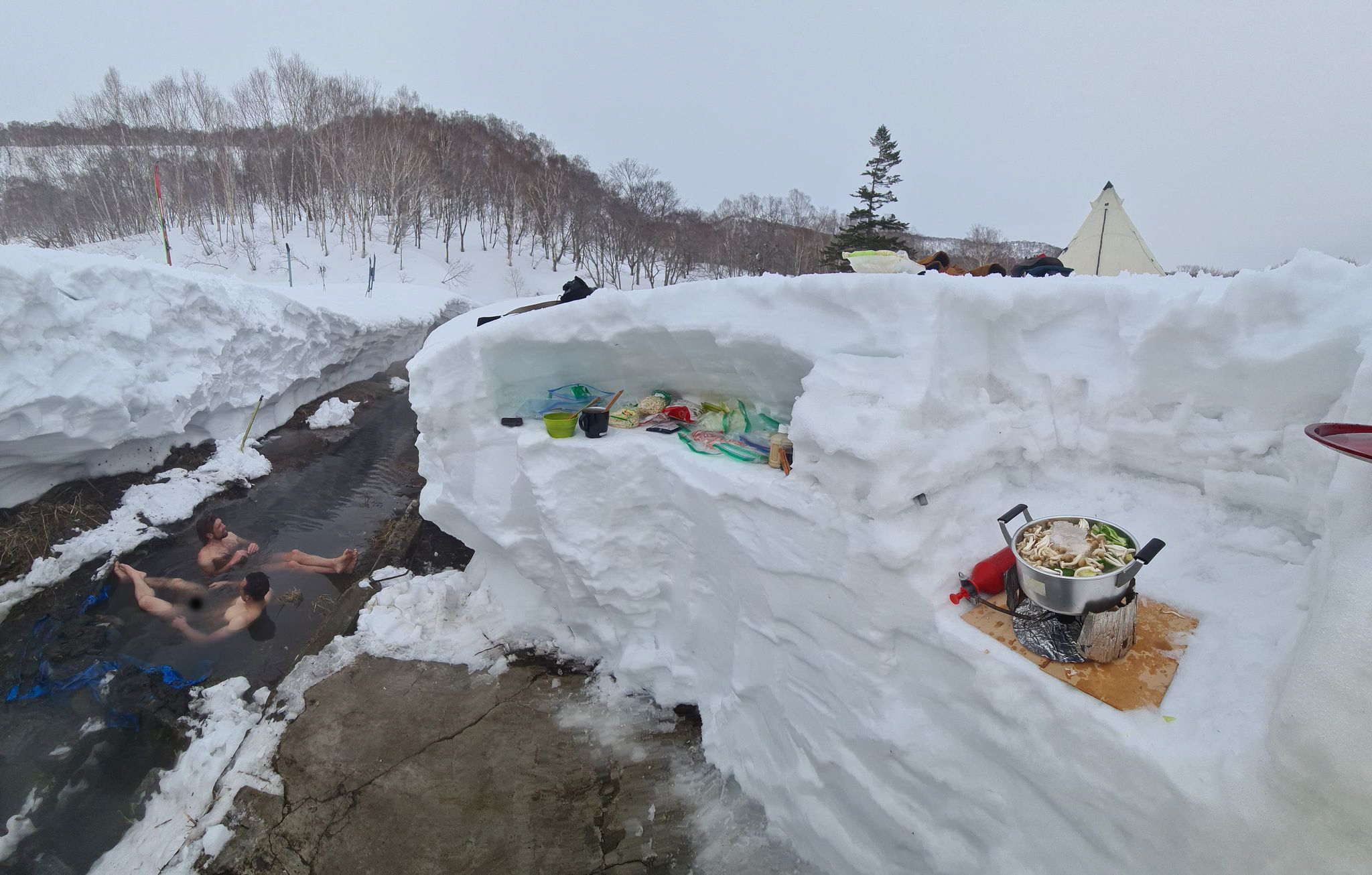
While there was rain forecast for Saturday we’d gone with the ‘travel light’ accommodation option and so the four of us planned to pack into Rob’s ultra lightweight cuben fibre tipi tent… a feat that was surprisingly easy and actually quite comfortable in the end. We slept early and woke early… well some of us woke early… Rob and Timbah were up and at it from about 0400hr while Ben and I *loudly* discouraged such an early start.
I took one last turn in the kitchen to prepare coffee with my new-found-post-pandemic toy; a Wacaco Nanopresso portable Nespresso pod coffee machine. Two stays in Jacinda’s 14 day Managed Isolation and Quarantine detention system had rather refined my DIY coffee system. The Wacaco also provides for a normal coffee basket if you want to bring ground coffee… or a hand-crank coffee mill. Full credit to Niseko regular David Addison for sending me down this path of backcountry luxury.
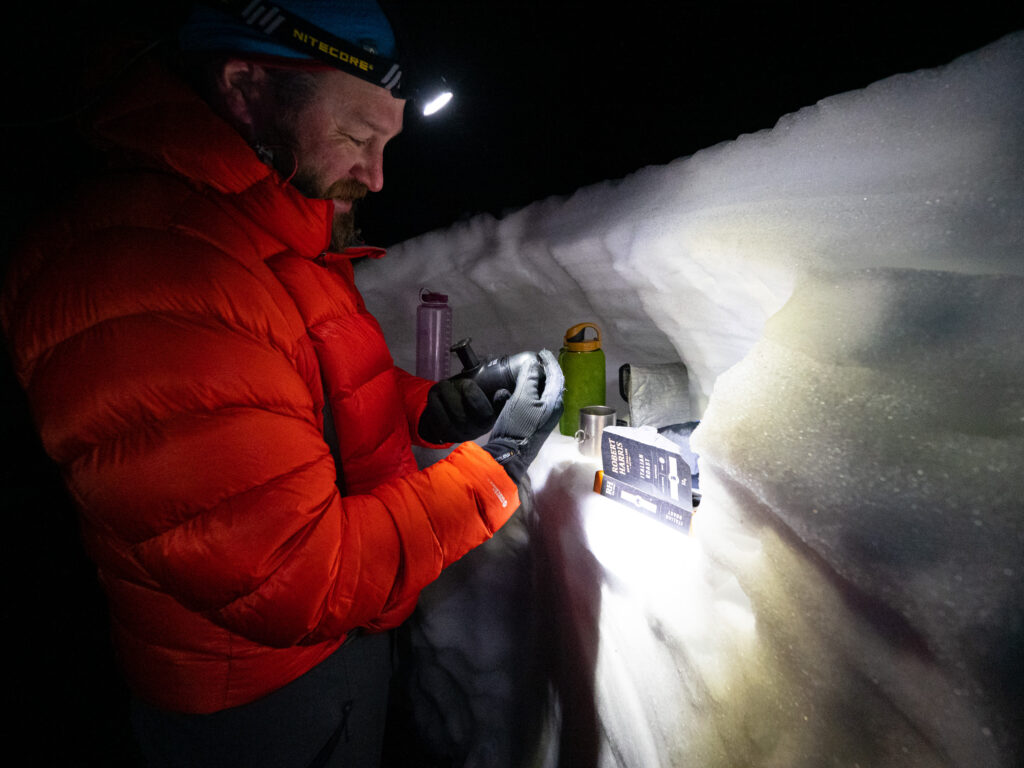
Dawn was just breaking as we began the second day’s journey. A short skin up the road before we ducked across the creek and climbed directly towards Mekkunai-dake. Your mileage may vary a bit here; as the spring melt kicks in we suspect that the creek crossing will get quite sketchy and you may find yourself climbing further up the road to the saddle before continuing westward.
As well as the most butt-ugly hiking pack any of us had seen in our lives, Timbah had brought his bluetooth boombox along too. The former was excusable on account of the “it’s all my ex-girlfriend left me” sob story we got to hear [several times throughout the trip], the latter was significantly less forgivable; Rob and I had to put it down to inter-generational differences. Ben seemed generally indiferent as to both the pack… and the boombox.
Nevertheless, there was marching to be done and nothing makes a long march better than some marching music. Memorable favorites from the section to Raiden-yama section included The Hiphopopotamus vs. Rhymnoceros and Wilhelm Richard Wagner’s Flight of the Valkyries .
At least we could say that Timbah would finish the day significantly more cultured than when we had begun.
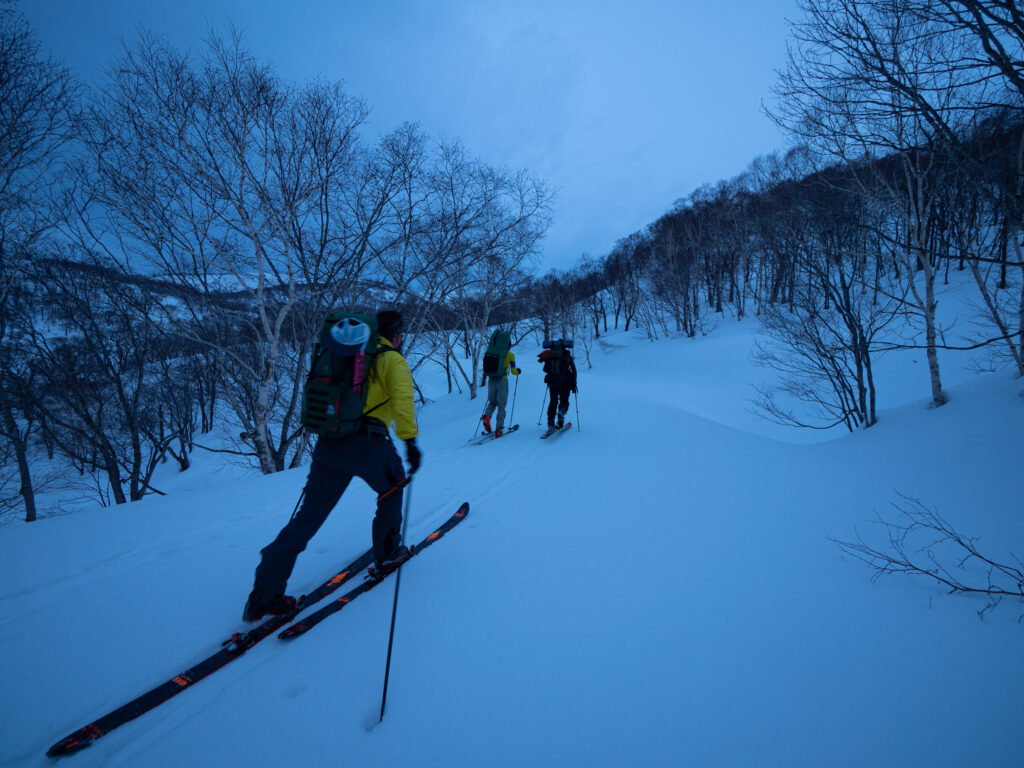
The march went on. And on. And on.
More of a walk than a ski to be sure and it was getting windy now. Still no rain in sight but we certainly didn’t have the bluebird conditions of day one. Visibility was still reasonable under the slowly thickening layer of altostratus and we could see through to Kariba yama in the south . A trip down there is definitely on our plans for winter 22/23.
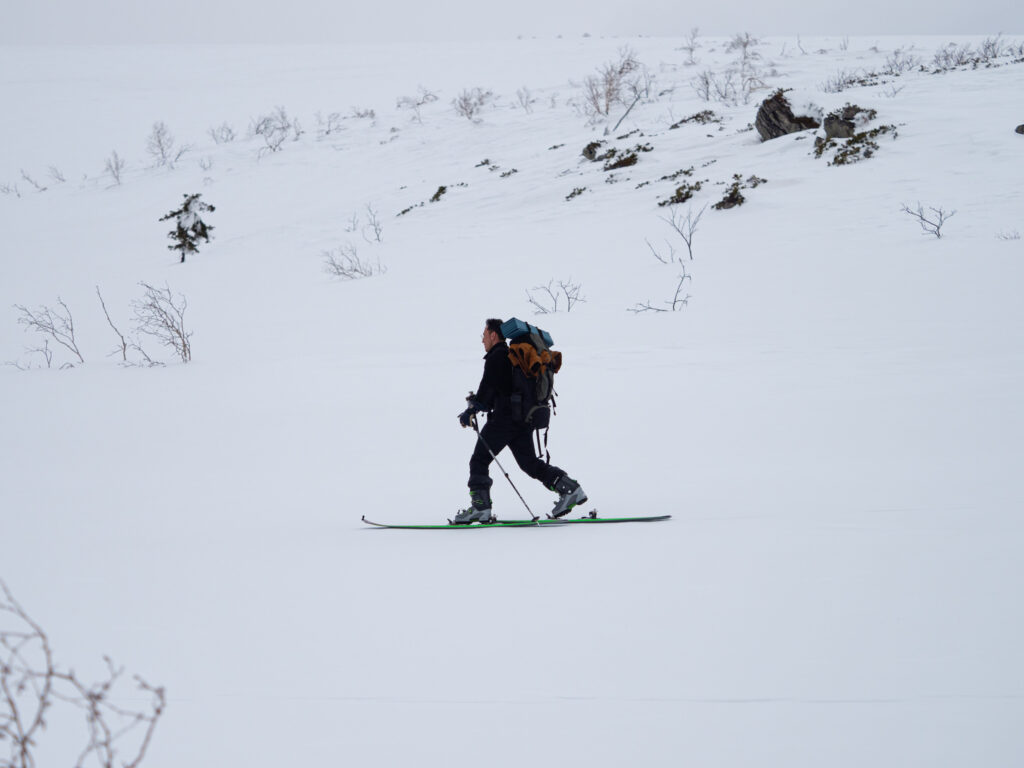
The summit of Raiden yama was a much larger plateau than I had anticipated. We found the summit marker, well about 20cm of the summit marker, sticking out from the snow. Visibility had retruned a bit and was good enough for some great views across Hokkaido. The Shakotan peninsula was stunning and is another part of Hokkaido that we’ve got to get out and explore on skis next season.
Typical for Raiden, wind at the summit was howling. Aaron Jamieson reported similar conditions on his traverse a few years back. With nothing hindering it, the winds off the Sea of Japan barrel across unabated.
The ski down the main ridge was the longest descent we’d had on this trip, and mercifully it wasn’t all that bad for the most part. There was a goldilocks zone of about 300m vertical where the porridge was “not too hard, but not too porridgey”.
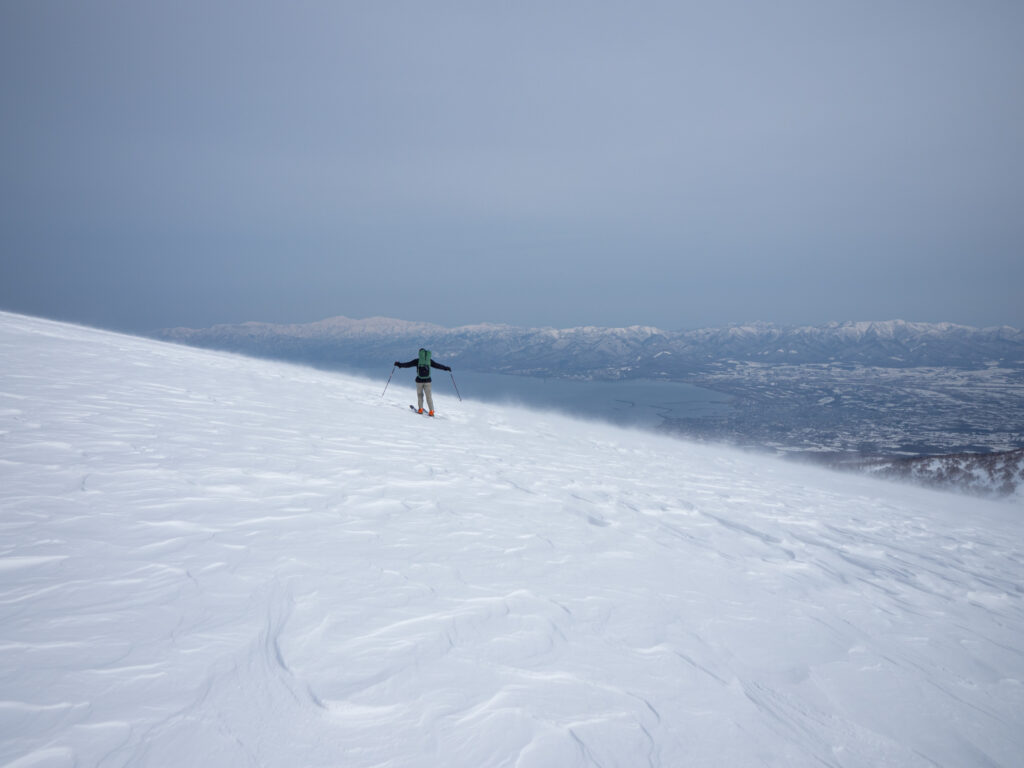
The woods quickly got woodier below the tree line. Along with it the snow descended into a hot sticky mess. No small amount of survival skiing ensued.
At the terminus of the ridge we were finally bootpacking. But to where we’d need to bootpack, it wasn’t immediately clear. The map suggested a slightly less steep bluff to the descender’s right, but a quick look over the edge suggested it would be quite the scramble.
Then we found the remains of an old house. If someone had managed to live up here on the bluff, then surely there was a path somewhere.
Timbah forged ahead, doing a full circuit of the old decrepit ruins. “There’s an old path down here!” he hollered triumphantly.

The path led us down right to the coast. A short walk had us arrive at a very convenient, deserted-looking old boat ramp. I suspect that it’s probably an active fishing harbour for much of the year. This was cause for great celebration, as we’d originally planned to descend a different route which may not have given us such direct access to the sea. This alternate route meant we truly skied from the eastern end of the range to its terminus here at the Japan Sea.
Accomplishment unlocked.
Timbah and Ben quickly stripped off and committed to a celebratory dive into the sea. While the weather was warm, that water was still not much more than 5 degrees Celcius. I forewent the ceremonial dip, and feel vindicated for the choice after hearing the clearly painful noises coming from Rob as he also went for a dip.

MVP award for the trip went to Haidee for picking us four stinky boys up at the boat ramp.
Following a trip like this to the coast, it only felt right to have sushi. Makoto Sushi 誠寿司 ( map ) appeared to be one of the few Iwanai such joints open at the time. The owner hid his surprise at five foreigners suddenly turning up well after lunch time, and whipped up some amazing lunch sets for us all.
A fitting end to a great two days out in the Niseko Range.

As with each ski touring, cycle touring, and hiking route guide published on hokkaidowilds.org, should you choose to follow the information on this page, do so at your own risk. Prior to setting out check current local weather, conditions, and land/road/track closures. While traveling, obey all public and private land use restrictions and rules, carry proper safety and navigational equipment, and of course, follow leave-no-trace procedures. The information found herein is simply a planning resource to be used as a point of inspiration in conjunction with your own due-diligence. In spite of the fact that this information, associated GPS track (GPX, KML and maps), and all information was prepared under diligent research by the specified contributor and/or contributors, the accuracy of such and judgement of the author is not guaranteed. hokkaidowilds.org, its partners, associates, and contributors are in no way liable for personal injury, damage to personal property, or any other such situation that might happen to individuals following the information contained in this post.
hokkaidowilds.orgに掲載されるすべてのスキールート、自転車ツーリングルート、ハイキングルートと同様に、本ページに掲載される情報を利用し行動する場合、必ず自己責任で利用することを条件とします。出発する前に現地の天候や状況、通行止め情報などを確認しましょう。行動中は、公有地/私有地に関係なく必ず現地の利用条件を守るようにし、適切な安全装置や、コンパスや地図などのナビゲーション道具を身に着けてください。いうまでもありませんが、自然に与える人間の影響を少なくし、ゴミの持ち帰りをはじめ環境を傷をつけない(Leave No Trace)ようなアウトドア行動にしましょう。本サイトに掲載される情報はあくまで計画を立てるための一つの情報源に過ぎなく、行為者の先んじて払ってしかるべき正当な注意義務及び努力と合わせて利用することを条件とします。本ページのGPSトラック(GPXとKMLと地図)を含む情報は提供者のできる限り正確な調べにより提供しているものの、その情報の正確性や、提供者の行動判断は、hokkaidowilds.orgは一切の責任を負いかねなく保証できません。また、本ページに掲載される情報を利用することによるいかなる怪我、器物損壊等、その他事件 ・事故等においてhokkaidowilds.orgや本サイトの関係者は一切の責任を負いかねます。
Comments | Queries | Reports
Done this route to Niseko Haute Route, or others nearby? Thinking of doing it? Please post any feedback, reports, or queries here. Thanks!
Leave a Reply Cancel reply
Your email address will not be published. Required fields are marked *
Yes, add me to your mailing list
This site uses Akismet to reduce spam. Learn how your comment data is processed .
See More Like this
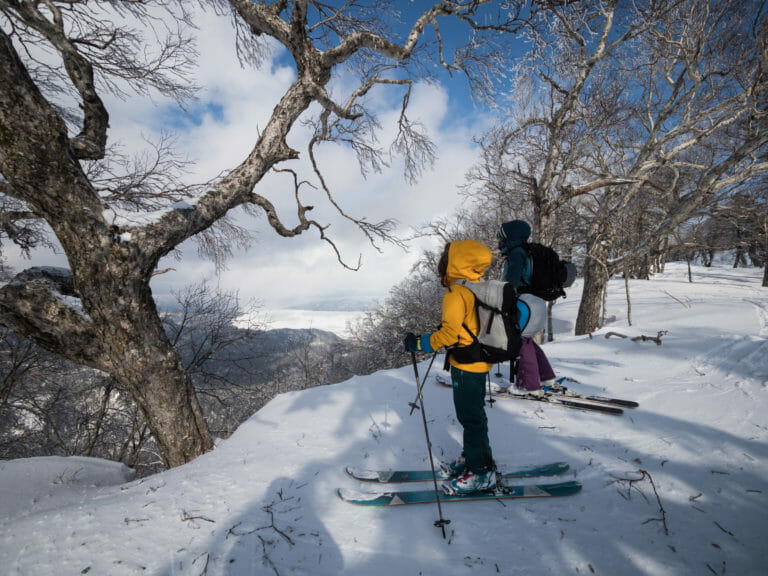
Kotoninupuri and Osappenupuri Ski Touring

Haruka-yama Ski Touring
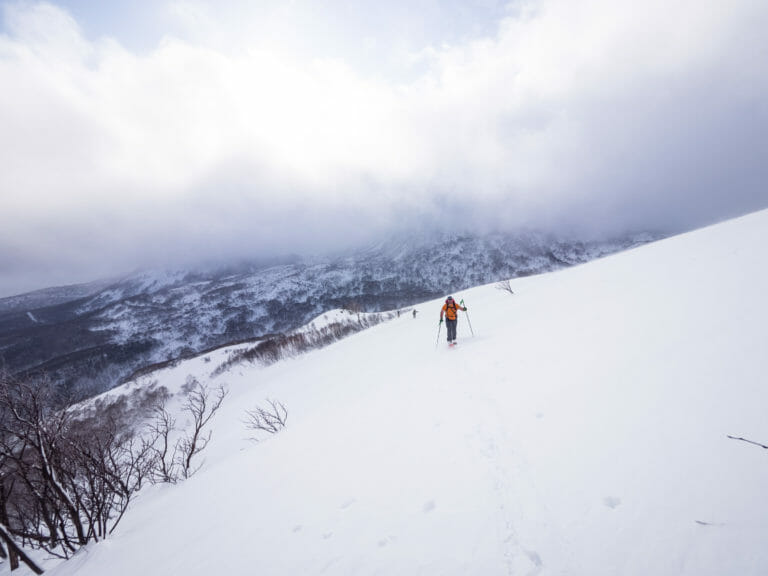
Weisshorn Ski Touring
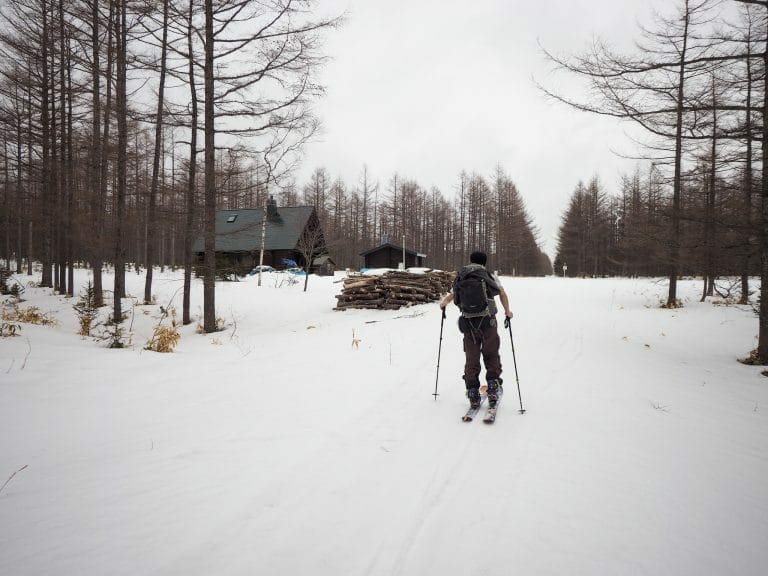
Nishibetsu-dake and Nishibetsu Hut

Goryo-yama and the derelict Kami-Sunagawa-dake Ski Field
More hokkaido backcountry ski touring routes.

#hokkaidowilds
About hokkaido wilds.
Follow on Instagram
Hokkaido Wilds CC BY-SA 4.0 ( guide )| Site Map

Printable Niseko Haute Route Topomap
Download may take some time
BADGE by @joekkaido
Hokkaido Wilds Foundation
We’ve got affiliate links on HokkaidoWilds.org to help fund the Hokkaido Wilds foundation.
The Foundation gets a small commission on sales from affiliate links, but we only link to stuff we think is worth checking out for people keen on the outdoors in Hokkaido and Japan.
The Hokkaido Wilds Foundation is a fund where 100% of funds are donated to Hokkaido volunteer groups involved in sustainable, safe, and responsible access to the Hokkaido outdoors.
Learn more here
ADVANCED FILTERS
Filter by location
About Filters
REGION: The general mountain/geographical region the route is in.
BEST MONTH(S): Time of year a route is suited to visiting. Some pop all season, some are more limited.
DIFFICULTY: How strenuous a route is, and how technical it is. Full details here.
FREERIDE/SKITOUR: Very subjective, but is a route more-of-a-walk-than-a-ski or the other way around? Some routes are all about the screaming downhill (freeride), some are more about the hunt for a peak or nice forest (ski-tour). Some are in between.
MAIN ASPECT: Which cardinal direction the primary consequential slope is facing, that you might encounter on the route. More details here .
ROUTE TAGS: An eclectic picking of other categories that routes might belong to.
SEARCH BY LOCATION: You can find routes near your current location – just click on the crosshairs ( ). You may need to give permission to HokkaidoWilds.org to know your GPS location (don’t worry, we won’t track you). Or, type in a destination, such as Niseko or Sapporo or Asahikawa etc.
Please let us know how we can make it easier to narrow down your search. Contact Rob at [email protected] with your suggestions.
GRADES range from A (very difficult) to D (easy). Hazards include exposure to avalanche and fall risk. More details here . Rating rubric adapted from Hokkaido Yukiyama Guidebook 北海道雪山ガイド .

IMAGES
VIDEO
COMMENTS
These two incredible ranges are among the highest areas in the Alps. The Haute Route in its entirety dates back to 1924 (the history of the individual passes or 'cols' is much longer), so the journey is steeped in history and tradition. The total distance is approximately 120kms with 6,000m of ascent and descent.
The Haute Route is an Advanced Level trip for experienced ski tourers. The tour involves several big climbs and long technical descents, with a number of sections where the use of the rope for security is necessary. Like most high altitude ski tours, reasonable weather and snow conditions are required in order to complete the whole tour.
Haute Route Chamonix-Zermatt. An absolute ski tour classic. Over 5-6 days, from one mountaineering centre to another. Type Skitouring. Difficulty medium. Duration 50,00 h. Distance 94,3 km. Ascent 6700 m. Descent 8345 m.
Haute Route Day 2 - Refuge Albert Premier to Cabane du Trient. First Breakfast in a hut - and early start off to Trient. Climbing stats - 4.75 miles (7.6 km), 5 hrs 38 min, 2437 ft (715 M) ascent, 907 ft (277 M) descent. On our second day of the Haute Route we covered the ski trek from Refuge Albert Premier to the Cabane du Trient.
2021 Haute Route Tour dates: March - May 2021: custom design your ski tour. for individual and group. Day 1: Welcoming in Chamonix. Prepare equipment and review tour. Day 2: A perfect way to acclimatize for the Haute Route is to ski the Vallee Blanche. Although this run can be accessed by lifts, it is rugged glacial terrain that will allow ...
An absolute ski tour classic. Over 5-6 days, from one mountaineering centre to another. Chamonix and Zermatt: Two names that make any mountaineer's heart beat faster. A multi-day ski tour links them both. Every day starts early, often when it's still dark. There are tough ascents and fantastic descents, requiring both physical and mental ...
1:6. The world famous Haute Route Ski Tour is above all a classic high mountain journey, traversing cols, peaks and glaciers to link the famous Alpine resorts of Chamonix and Zermatt. Incredible scenery, long ski descents and challenging climbs characterise the route, which our specialist ski touring guides know intimately.
The Haute Route is an Advanced Level Alpine hut to hut tour, that includes some ski mountaineering, so you need good levels of ski touring experience for this to be a suitable trip. More specifically, there are 4 requirements for joining a guided Haute Route trip (or any hut to hut ski tour) - here they are, using Alpine Guides' ski and ...
The Haute Route ski tour is a classic Alps ski tour that every backcountry skier should experience. In this European Alps ski tour, we traverse the spectacular alpine ski touring terrain from the Mont Blanc massif in Chamonix to the Matterhorn in Zermatt through the heart of the Valais Alps of Switzerland. We are proud to be one of the most ...
The Haute Route is most likely the single most famous ski traverse in the Alps. Pro Guiding Service has guided this super classic ski tour from Chamonix to Zermatt about 45 times in 5 different variations. We have guided the original route via the Valsorey hut, the "classic route" via Verbier, from Zermatt to Chamonix ending in Courmayeur and other variations in between.
Classic Haute Route Chamonix Zermatt - Grand Combin / Bourg-St-Pierre route. After crossing the Mont Blanc range to Champex a night is usually spent in the village of Bourg St. Pierre. Day 3 - A long and steady climb to the Cabane de Valsorey (3030m) passing through an interesting gorge at one point. Day 4 - A steep climb (often made on foot ...
The Haute Route is without doubt the most famous ski tour in the Alps. Launched in 1903 by members of the Compagnie des Guides de Chamonix, it links these two historic centres of mountaineering via a series of 3000m mountain passes and a 3800m peak. The extraordinary beauty of the landscapes traversed makes it an absolute must for ski tourers.
Top recommended route Difficulty difficult closed 153.3 km 55:00 h 11,232 m 10,667 m The Haute Route ski tour connects the towns of Chamonix and Zermatt, and in the extension it leads to Saas Fee. It is a tour of superlatives and runs along the highest and most famous peaks as well as over the widest and longest glaciers in the Alps.
Apr 09 - Apr 15, 2025. $3,310 7 days. Apr 16 - Apr 22, 2025. $3,310 7 days. The Haute Route is the most famous backcountry skiing tour in the world. See the Alps in all their glory along with an expert guide!
The Haute Route is a classic ski tour through the heart of the Western Alps and some of its most stunning scenery. First completed in 1860, this high-level mountain traverse covers more than 75 miles / 121 kilometesr of alpine terrain, crosses 12 different glacier systems, and connects the two major mountain centers — Chamonix, France and Zermatt ...
The Proposed Haute Route. Six of us flew across the pond to traverse the Dolomites on what was billed as the "New Haute Route," a hut-to-hut linkup that had all the elements to be truly special: glacial travel, mountain-top refugios, steep couloirs, jagged ridges, and a unique Ladin culture. The problem, as we would learn, was that the ...
One of the best and most challenging days of the ski tour. Climb up and summit the Pigne d'Arolla at 3790m, the highest point of the entire Haute Route. After enjoying the spectacular summit views we ski down to the charming Vignettes hut for a well deserved dinner. 950m ascent, 700m descent (5-6hrs). Day 7:
Simply put, the Haute Route is one of the world's great long-distance hiking paths. Its name means "the high route" which is what it was branded when it was first chartered as a summer mountaineering route by members of the Alpine Club in the mid-19th century. It was given its French translation in 1911 when it was first explored as a ski ...
Vertical ↑ 1600 ↓ 1300 m. Day 3: Steady ascent over gentle glacial slopes to the summit of the Grossvenediger, premier ski peak in the area. The views are said to go as far as Venice. Now follows the first downhill highlight of the Tyrolean Haute Route. A long ski run of 2000 m to the quaint village of Innergschlöß.
The Haute Route is a tour for skiers with advanced skills who are able to ski in variable snow conditions. Skiers should be able to ski "off piste" in all types of ungroomed snow. Also, for our climbs skiers should be able to execute uphill kick-turns without difficulty.
Overview. The Snoqualmie Haute Route was pioneered by Martin Volken in 2000. It is a multi-day alpine traverse through the big mountain terrain from Alpental to Mount Hinman and beyond. This committing, rugged, and absolutely incredible traverse has brought new meaning to Snoqualmie Pass ski touring. $ 1,200 Per Person. 5 Days. Difficulty. Ratio:
The moniker Niseko "Haute Route" was borrowed by locals from the European version, but the concept is the same: a multi-day, high-level ski tour route up in the alpine, ticking off as many of the major peaks in the range as possible along the way.When visibility is good - as is often the case in spring - this is an incredibly inspiring route with plenty of variation.